For reasons I'm sure made sense at the time, I started sending a coworker random fungus facts every workday morning just as a random interesting thing while we're all self-isolating. Since a few folks on twitter also expressed an interest, I'm going to tweet a few also! 🍄
Disclaimer: although I studied mycology and have an M.Sc in plant pathology, that was a long time ago and I no longer work in the field, so if I contradict a current expert I'm probably wrong. Also, feel free to mute this thread if you hate fungi! 😛
First of all, what are fungi? You may think mushrooms are fungi, and kind of true - in fact, mushrooms are the reproductive body of some (not all) types of fungi, kind of like fruit are the way trees distribute seeds. Many fungi do not make mushrooms.
Many fungi can choose whether to reproduce using sex or asexually. Often related to resources available. If few resources, they can hang out in the soil as simple mycelium (little fungus threads like roots) and bud off asexual spores and things like that. It's cheaper and easier.
If resources are plentiful, and two different fungi meet down in the soil, they may combine together (mixing genetics, = sexual reproduction) and spend the energy to grow a mushroom (like a fruit) which produces spores (like seeds) containing genes from both parents.
The mushroom is just a small and temporary part of the whole body that is specifically for reproduction purposes. Most of the fungus is underground in a tangle of tiny rootlike threads, called mycelium. (Ever picked up a rotting log and saw teeny white threads? Likely mycelium.)
It's (relatively) easy to identify a species by looking at the mushroom, but much harder to identify a species without a mushroom. So you might find THAT mycelium in the soil but have no way to know it's the same species that makes THIS mushroom if you don't catch it growing one.
(There are quite likely many fungi that we currently think are two different species because we found them separately (in the soil HERE, and growing a mushroom THERE) and haven't realized they're really the same species just doing different things.)
Since fungi can't walk around or run away like animals can, but also can't photosynthesize to make their own food like plants or algae, they have to be SUPER clever about (A) learning to eat anything that nobody else wants, and (B) chemical warfare to fight off the competition.
So if mushrooms aren't exactly the same things as fungi, and some fungi don't even make mushrooms, what is a fungus exactly? How is it different from other things out there lurking in the soil? Well, the scientific answer is a bit technical and precise, but generally speaking...
Things fungi are well known for would generally include: does not photosynthesize its own food from sunlight; does not have hard cellulose cell walls like a plant but instead has something like chitin; mainly immobile (doesn't run around like an animal);
Likely plays a fundamental role in decomposition in the ecosystem; probably digests its food by secreting enzymes outside itself then sucking in the "digested" molecules (as opposed to 'swallowing' food whole and then digesting it inside); cells have a distinct nucleus.
This is Onygena equina, growing teeny little mushrooms on a moose or elk hoof it's eating. Hoofs are mainly made of keratin, which is a very complex protein that's very hard to digest, but Onygenales species have learned to eat it because nothing else wants to make the effort. 
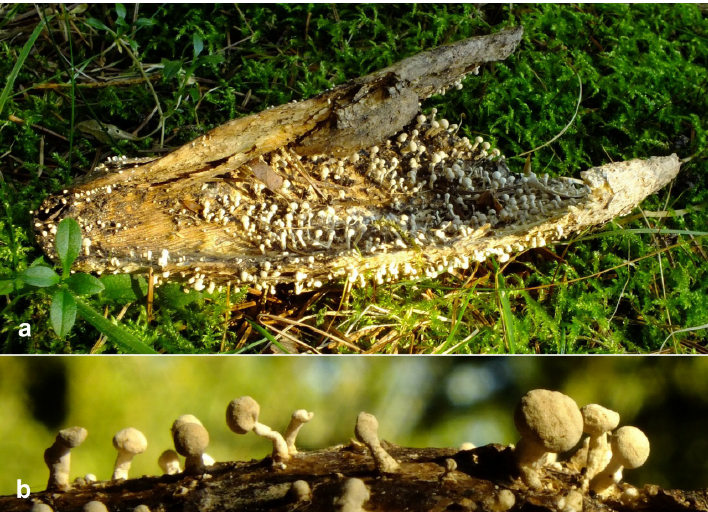
Last I heard (admittedly a while ago), Onygena equina has only been found eating hoofs and horns, not anywhere else. So nobody knows how it FINDS them lying around in the middle of forests and things, or what it does in between finding hoofs/horns, which aren't always available. 
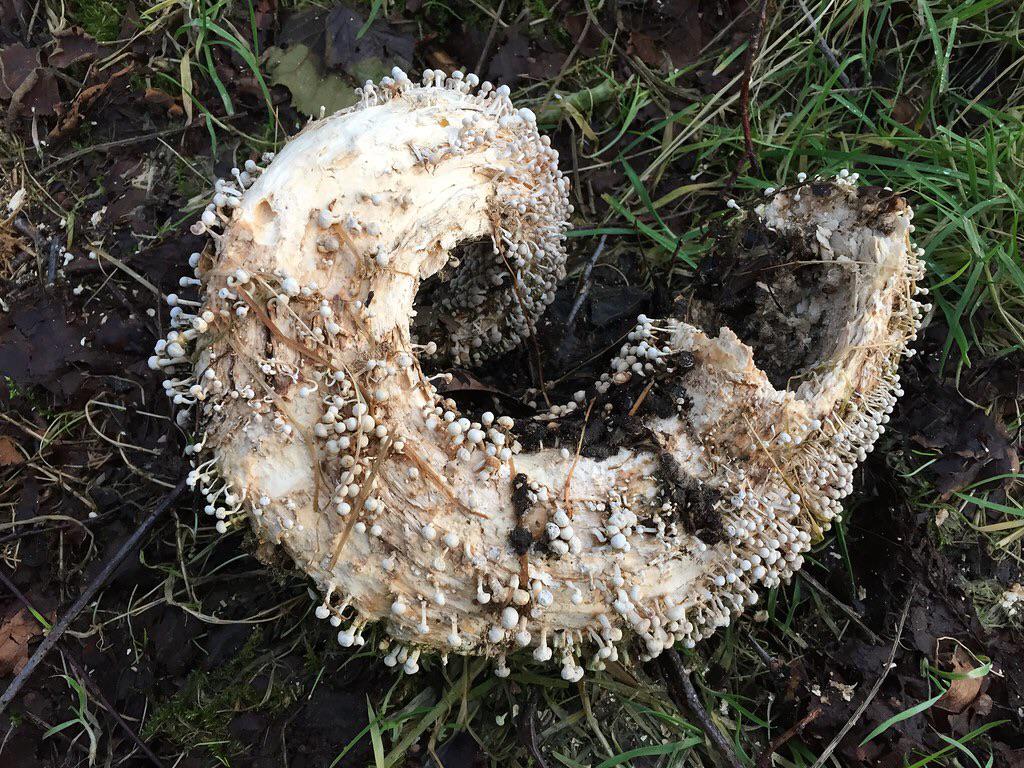
Possibly it's in disguise and only looks like this on moose hoofs so we don't recognize it when we find it eating something else. Possibly it's a parasite or a symbiote with insects and rides them around to find food. Maybe it teleports! WHO KNOWS, fungi work in mysterious ways.
Mushrooms are just the fruiting body of a fungus that is usually much larger and underground (like an apple on a tree). Here in Alberta, and most countries with similar summer/winter seasons, the best time of year for finding wild mushrooms is late summer till the first snowfall.
Foodies: @sorrentinos_yeg restaurant here in Edmonton does a whole mushroom month menu in September, including mushroom hunting walks! It is essential, however, to know how to identify the mushrooms you find. (In #YEG see also: @ABMycological for more info and teachings!)
Two of the mushrooms that most commonly cause fatal poisonings are found in a family called Amanita: Amanita phalloides and Amanita muscaria. Amanita muscaria looks like the stereotypical photo of a "toadstool": red cap with white flecks, so fewer people eat it by mistake. 
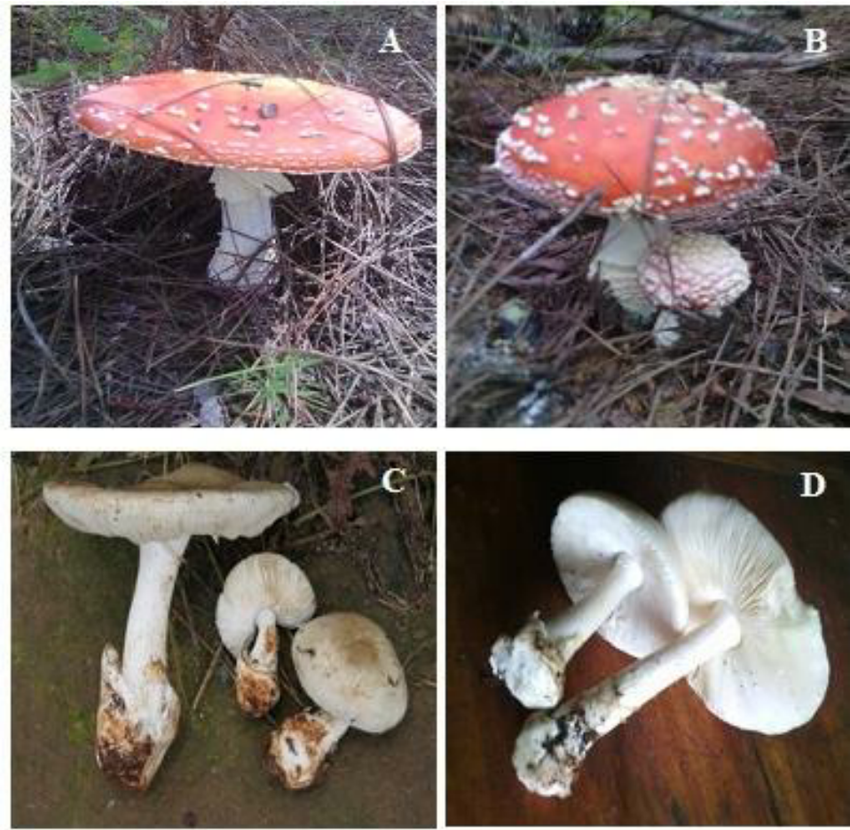
Amanita phalloides however is a beautiful white mushroom that looks similar to several other edible species. It causes liver and kidney failure, and since there is a liver transplant waiting list longer than the few days the mushroom would take to kill you, it's usually fatal. 😢
Fortunately for Edmonton #YEG it looks like Amanita phalloides isn't found here (although A. muscaria is), but it is found in other parts of Canada and is spreading. It is originally from Europe and is thought to be spread with species of trees imported from those countries.
The soil here isn't great for many European trees, but in cultivated gardens and landscaped cities it may be possible for it to occur. In BC, all known occurrences of A. phalloides have been within cities where imported trees would have been planted, not found out in the forests.
About 1% of the fungus kingdom consists of yeasts. These are eukaryotic (ie, they have a nucleus with a membrane), single-celled microorganisms that mostly reproduce asexually, by budding. 
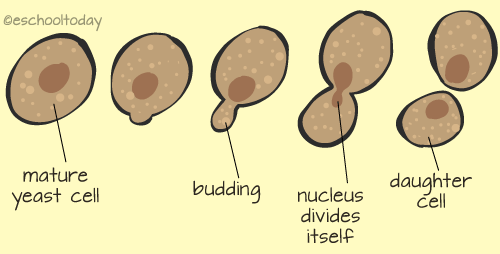
When we talk about yeast in daily life we're usually talking about the baker's yeast that's used for cooking bread and brewing beer. This is usually Saccharomyces cerevisiae, a common species which eats carbohydrates (particularly sugars) and converts them into CO2 and alcohol. 

There are many other species of yeast too. Some (such as S. boulardii) naturally live in our digestive systems and help us break down carbohydrates in the gut; many other types of yeast are found in nature.
Different types of yeast can be used to make products with subtly different flavours; in beer making, S. cerevisiae and S. carlbergenesis are most common. However, Belgian lambic beers use yeasts naturally occurring in that region, the most common being Brettanomyces lambicus.
B. lambicus also breaks down sugars, but unlike S. cerevisciae, in addition to alcohol it also produces acetic acid (what gives vinegar and some fruits their sour taste). Lambic beers are usually flavoured with fruit juice to make their characteristic sour fruity tastes. 

In the fermentation process, the yeast produces carbon dioxide and alcohol, but as the concentration of alcohol goes up, it will eventually become toxic to the yeast and most of it will either die or become dormant. Different strains of yeast have different tolerances to alcohol.
Off-the-shelf baker's yeast will typically only get to about an 8%-9% alcohol level before it dies off. To make wine, yeast strains which can tolerate a higher % of alcohol are normally used. To get to a really high alcohol level, further distillation may be needed. 

Once the yeast used to make beer has died or gone dormant due to the alcohol level, it's typically filtered out of most modern beer styles. Cakes of dormant yeast can be reused to make the next batch of beer. The remaining dead yeast is a protein-rich source of lots of vitamins.
Some breweries sell it off for use in vitamin supplements and flavour enhancers, and in the UK, of course, some of it goes to make everyone's favourite toast spread, @marmite 😋 


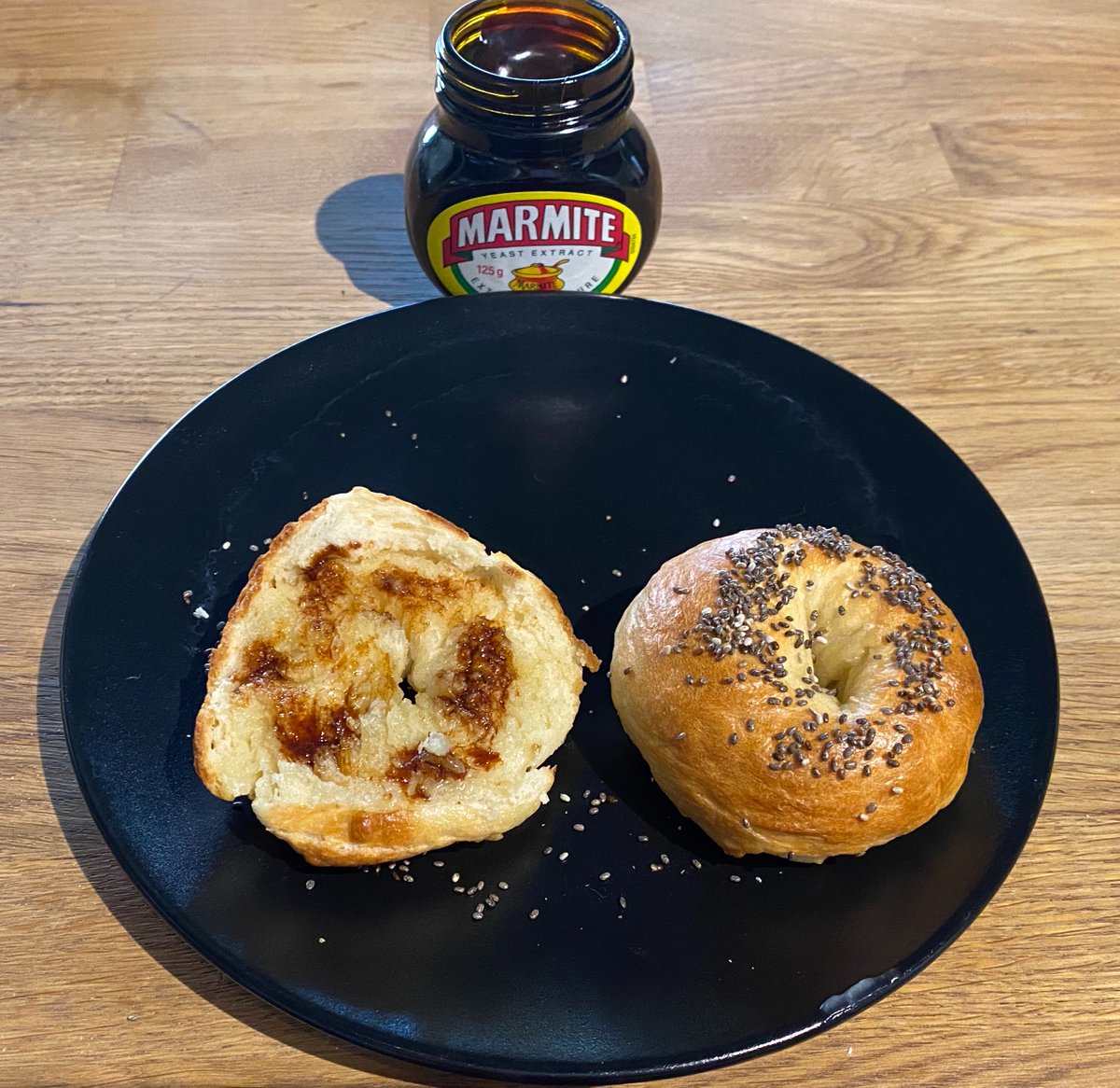
Cordyceps is a genus of fungi that includes about 400 species. Most Cordyceps species are endoparasitoids, parasitic mainly on insects and other arthropods. The name is from Greek "kordyle" meaning "club" and Latin "caput", meaning "head", b/c of the shape of the fruiting bodies.
Discovered by Alfred Russel Wallace in 1859, Ophiocordyceps unilateralis (also known as the zombie fungus) is mainly found in tropical forests. This species specializes in parasitizing ants and is creepy/interesting because of the way it takes control of the ant's behaviour.
It grows through an ant’s body, creating a network of filaments that commandeers the insect’s muscles. Then about 2 weeks after the infection, it compels the ant to leave the nest, climb a tree or plant stem, and clamp its mandibles on the major vein on the underside of a leaf.
This manipulated biting is a completely novel behaviour induced by the fungus and is not part of the regular behaviour as observed in healthy ants. It is also called the “death grip” since manipulated ants will stay in this position, where the fungus finally kills them.
The fungus uses the ant’s tissues as a carbon source to grow a fruiting body from between the ant’s thorax and head, producing spores that drop downward and hit the ant’s colony-mates as they go about their foraging trips. In this way, the zombie fungus can infect the colony. 
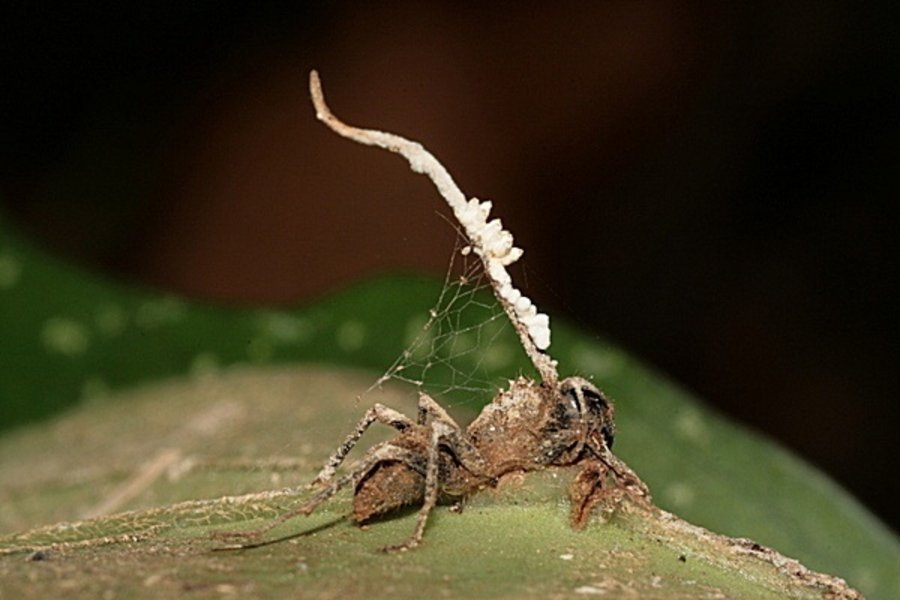
It appears the fungus controls the ant's behaviour by producing specialized metabolites that it releases in the neural system of the host.
In 2014, author Mike Carey published a book "The Girl With All The Gifts" which is set in a post-zombie-apocalypse England. Carey used "zombie fungus" as a basis for the science he referenced in the novel, hypothesizing that a new species of Cordyceps learns to infect humans. 

Similar to the way the zombie fungus affects ants, in his novel infected humans lose control of their nervous systems and are converted into "hungries", blindly drawn to infect other humans and thereby spreading the "zombie plague". Fortunately it's fiction! But a great read. 😊
If you read yesterday's tweets, you heard about the "zombie fungus" species that infect ants, causes the ants to climb to an overhanging leaf and die, and then slowly digests the ant and grows a spore-bearing structure to infect the rest of the ant colony.
Perhaps you wondered why are there still even ants? Why didn't they ALL get turned into zombie fungus food? Turns out that some ant colonies can reach an equilibrium with the parasitic cordyceps fungus, with the help of ANOTHER fungus. 
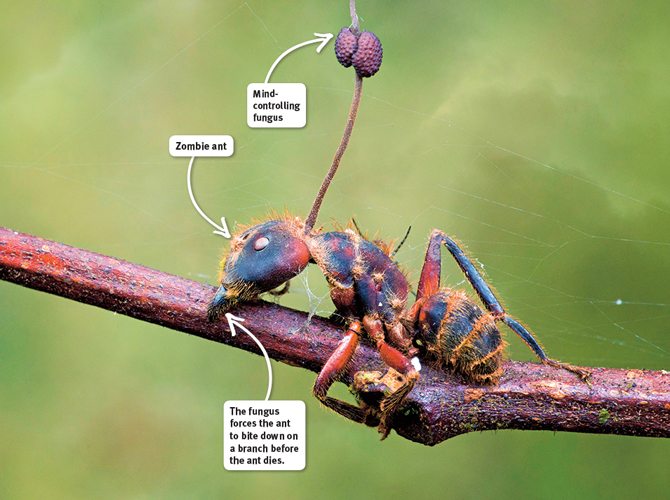
Studies of dead Cordyceps-infected ants discovered that some of the ant corpses were infected with not just one, but two (or more) fungi. Once the ant dies, the process of growing a spore stalk takes a few weeks, during which the structure is relatively defenseless!
During that time, other species such as Polycephalomyces ramosus move in and attack, which may slow or even prevent the Cordyceps spores from forming properly. Polycephalomyces is what would be called a "hyperparasite", a parasite that preys on another parasite.
It's not necessarily true for the ants that "the enemy of my enemy is my friend", because if Polycephalomyces entirely eliminated Cordyceps then it would have nothing left to eat and would also go extinct, so it doesn't help the ants TOO much.
But by limiting the number of spores Cordyceps produces, Polycephalomyces can reduce the infection rate of ants to a speed that the ant colony can match as new ants hatch... meaning the hyperparasite has a constant source of new food in the form of newly infected ants. 

Nature is very much a series of checks and balances, and compromises in which there is no clear winner. theguardian.com/science/neurop…
Today I played a D&D game in which a cave was described as filled with luminescent purple fungi. Actually, most fungi do not glow in the dark, but those that do normally have GREEN luminescence. 
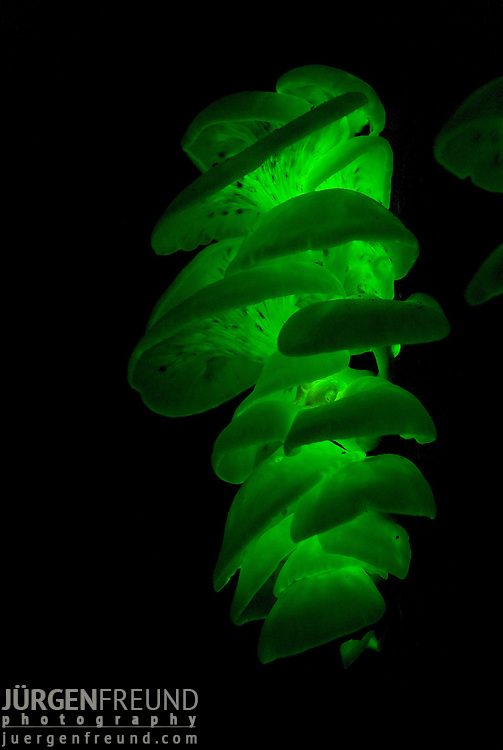
About 75 species of fungi are bioluminescent - meaning they give off light using a biochemical reaction. Almost all known bioluminescent fungi are mushroom-forming members of the order Agaricales, and form a white rot that decomposes wood. 

One theory is that breaking down the lignin molecules in the wood produces reactive oxygen molecules that are potentially damaging; bioluminescence is a chemical process that actively consumes oxygen so may help protect the fungus from damage.
Another theory is that the light may attract grazing animals that help spread the fungus spores. Either way, the eerie green glow of rotting trees has been observed as far back as Aristotle, and also used to be called "foxfire" or "fairy fire".
en.wikipedia.org/wiki/List_of_b…
en.wikipedia.org/wiki/List_of_b…
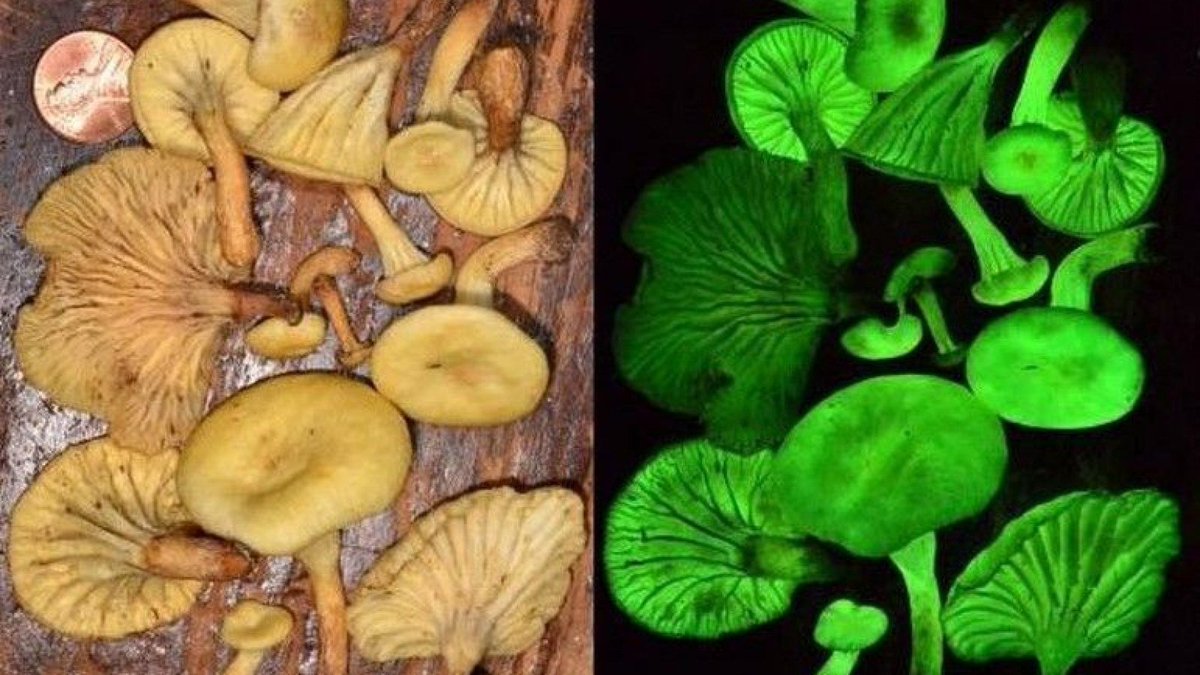
I've noticed in some computer games (Minecraft, for example) there's an assumption that mushrooms don't like/don't grow in sunlight. This is incorrect; you can often see mushrooms growing on people's front lawns, for example. There are two likely reasons for this misconception.
First, most fungi do need more moisture than plants, since they lack the hard cell walls and protective coatings that plant leaves have. This makes it less likely most mushrooms will grow in hot areas with a lot of direct sunlight, because these areas may be too dry.
And second, fungi don't NEED sunlight. They can't photosynthesize, so it's fairly irrelevant to them. Whereas plants DO need sunlight, and will compete for it. So, much easier and less competition for mushrooms to grow in places nothing else wants - like areas lacking light.
Why then do ANY mushrooms bother growing in sunshine? Why not just corner the lack-of-sunlight real estate and leave the sunshine to plants? Because many fungi do eat dead plants/leaves; and many have a symbiotic relationship with plants, so they'll still go where the food is. 😋
If you've ever seen a mouldy orange, which I'm sure you have, odds are good that it was Penicillium digitatum, one of the very many species of Penicillium that are very common in our air and soil and which generally look like a green mould with white edges when cultured. 
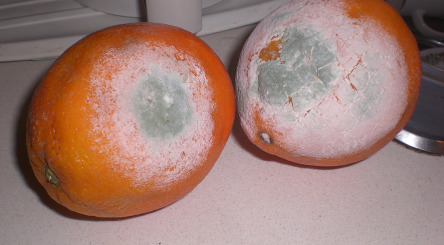
If you've found a mouldy orange then you probably also remember the SMELL, a sort of rotten citrusy smell. Having grown P. digitatum in the lab in petri plates full of agar media, I discovered that the smell is actually not the orange at all, but the fungus!
Even grown in a sterile environment nowhere near an orange, P. digitatum still emits that rotten citrus smell - it's the chemicals produced by the fungus to break down the orange's cells, not the orange itself, which you are smelling. 🍊😃
If you've ever tried reading up about moulds (and really, why wouldn't you), you might have been confused by the complicated names around how they're classified. First of all, what is mould? Let's define it as fungi that grow fuzzy filamental blobs like you've seen on old bread: 
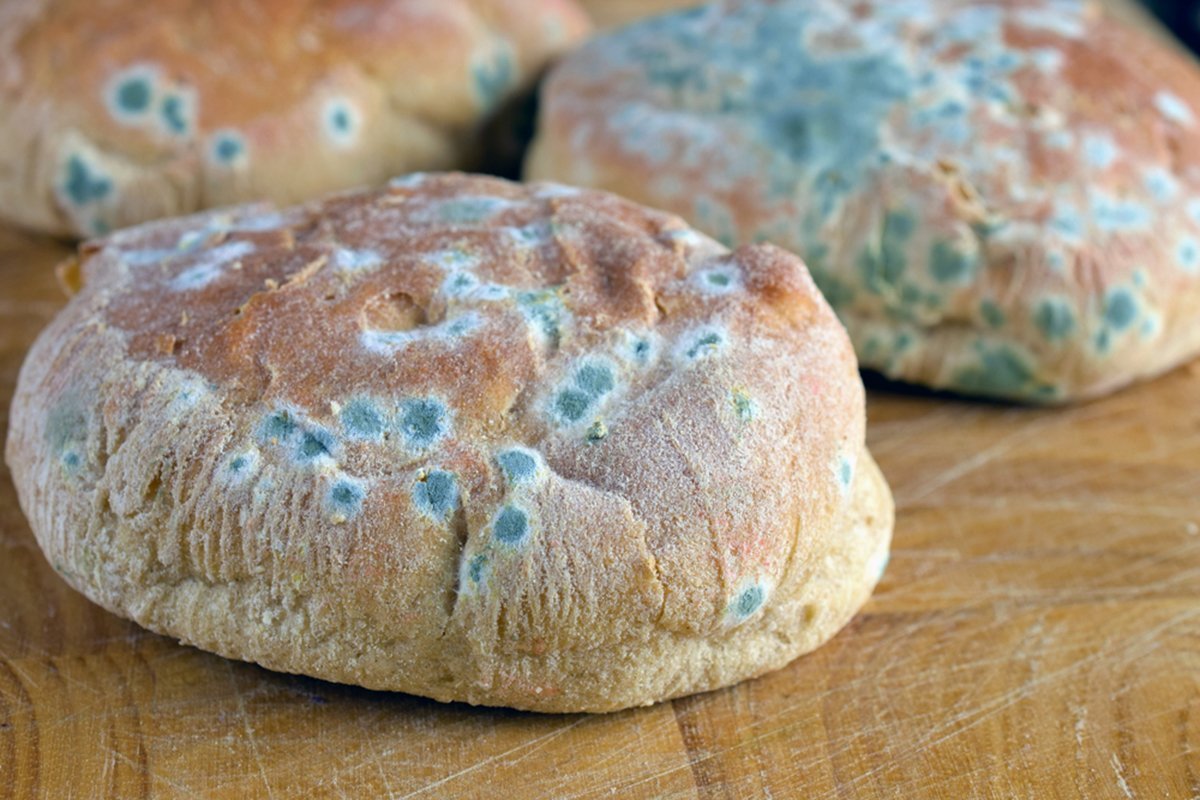
This includes almost all fungi (though not yeast, which remains single-celled and doesn't grow into filaments). But all the rest of it that does grow into mould is a little hard to tell apart at a glance. (At least for people who don't grow plates like this normally!) 
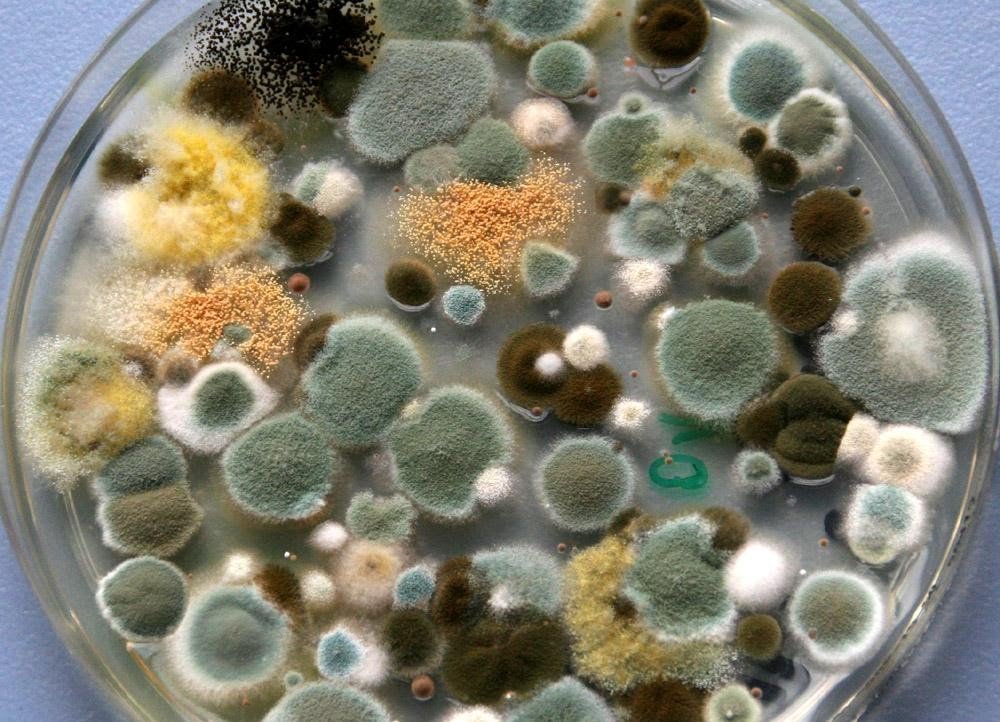
(It's been literally decades, but at a glance I would put a lot of money on this plate containing Rhizopus, Fusarium, Penicillium, and Aspergillus species, just looking at it.)
So what do all the fancy names mean? The secret is that biologists just think about sex a lot and decided the easiest way to tell moulds apart is to describe how they have sex. Yeah, that's all. 🤣
This probably tells you as much about biologists as it does about fungi. It's the equivalent of looking at all the birds in the world and deciding to call ducks the "corkscrew penis birds", it just sounds fancier if you use Latin or Greek to do it. 😄 

So what DO moulds look like having sex? Well, many of them reproduce both sexually (exchanging genetic material with another) AND asexually (single-player mode). For the purposes of classification, mould classification is based on what their sexual reproduction looks like.
Since this is all fairly arbitrary there's been a lot of disagreement over the years on exactly how to divide up the different types of mould sex into classifications, and if you search google/wikipedia there's a lot of conflicting and wrong information.
So I'm basing the below on text book I learned from ("Moulds: their Isolation, Cultivation, and Identification" by David Malloch, 1981) and the lab work I did in a mycology lab. Be aware whatever classification you use someone will argue about it, but we used this:
1. Oomycetes. ("Egg fungus") These reproduce by creating an egg-like structure when 2 genetically different individuals meet. They tend to live in very damp places and cause water molds on crops. Nowdays we know they're not actually true real fungi, just very fungus-like. 

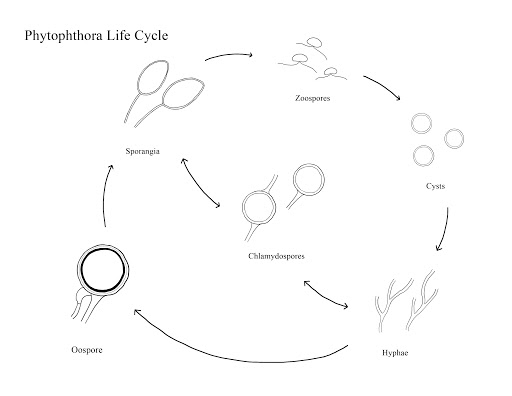
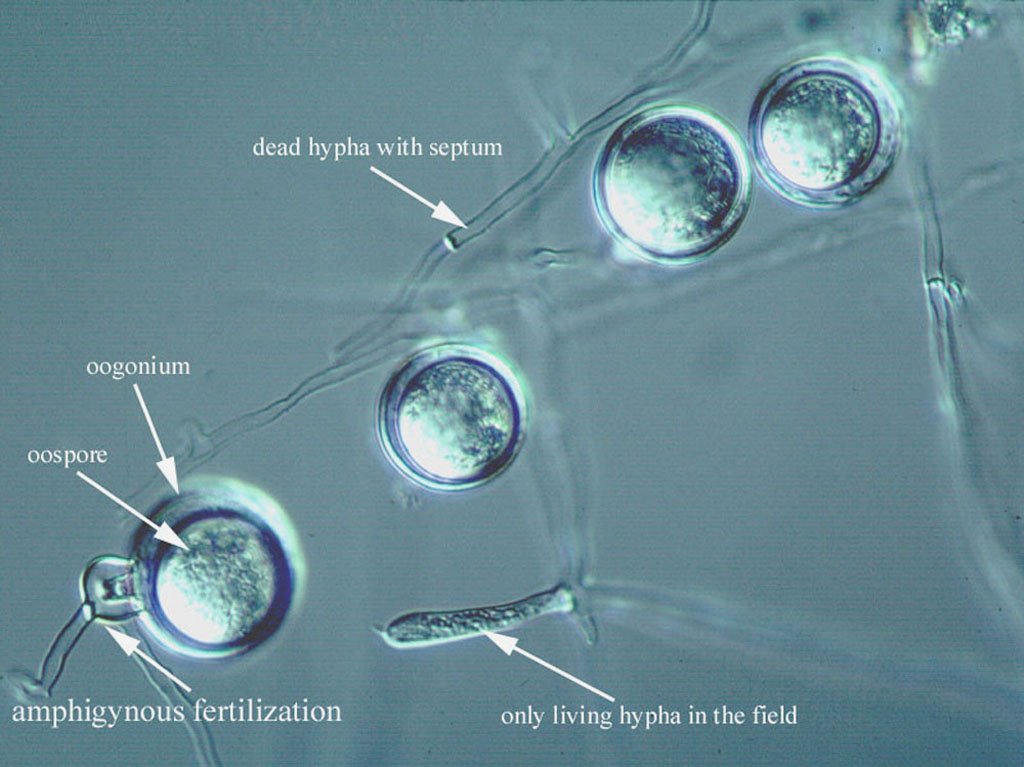
2. Zygomycetes. ("Joining fungus") When 2 genetically different individuals meet and combine genetic material, they join together to create a thick-walled cell between them in which form zygospores. 

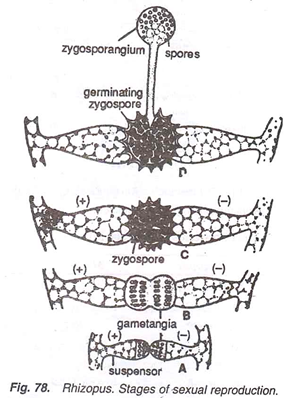
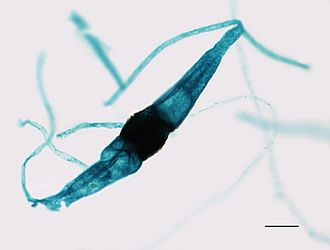
3. Ascomycetes. ("Sac fungus") When 2 genetically different individuals meet and combine genetic material, they make spores combining genes from them both inside little sac-like structures called asci. 

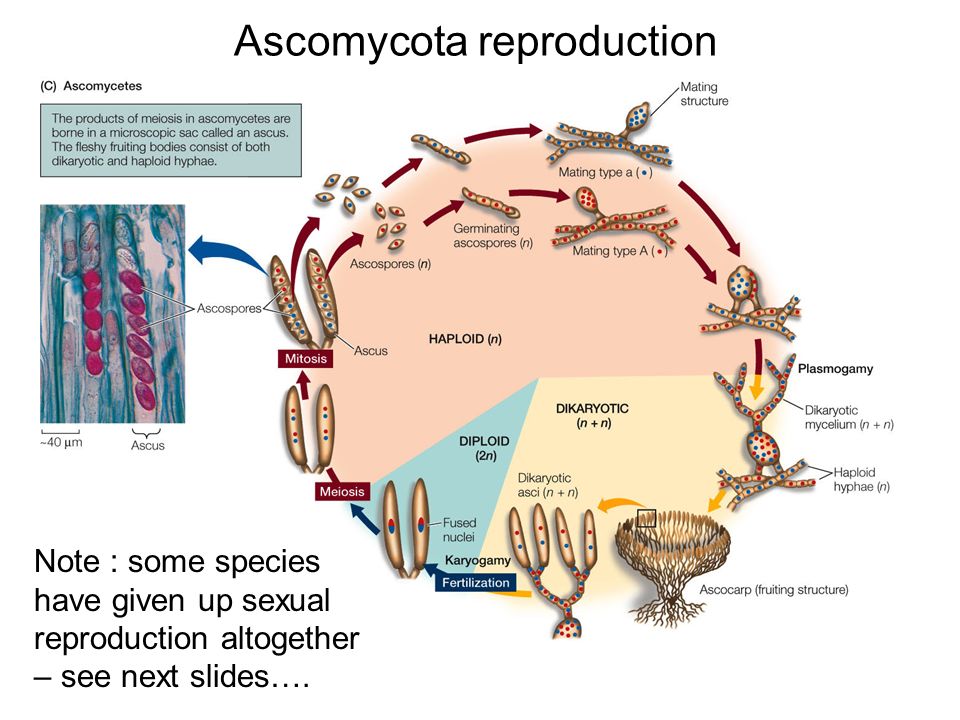
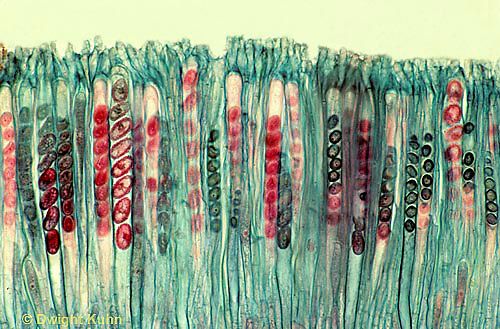
4. Basidiomycetes. ("Club-fungus") When 2 genetically different individuals meet and combine genetic material, they form external spores that grow on a club-shaped structure called a basidium. (Most mushrooms are basidiomycetes, but not all basidiomycetes grow mushrooms.) 


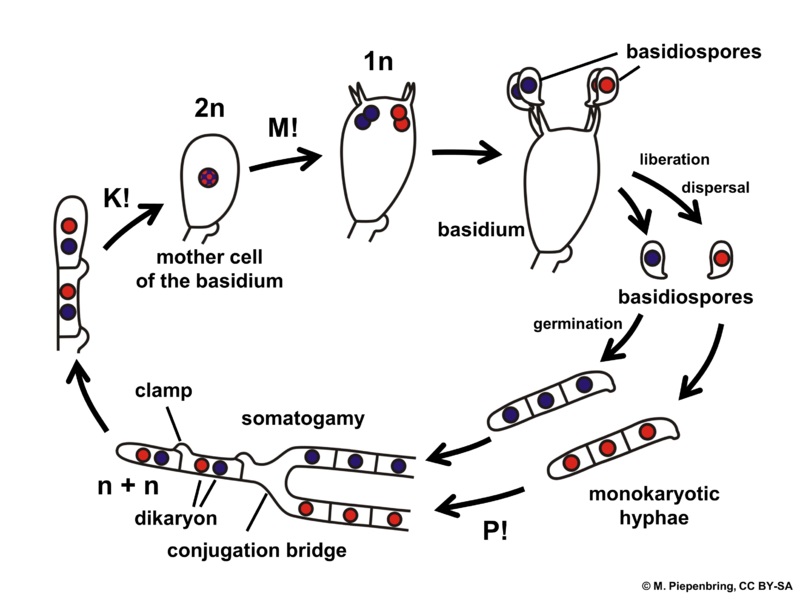

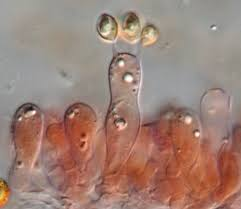
5. Anamorphs/deuteromyces. This isn't a real classification of fungi, it just means these species that have been too shy to have sex in front of scientists so they don't know which division to put these into. These probably are really mostly #3 or #4.
en.wikipedia.org/wiki/Teleomorp…
en.wikipedia.org/wiki/Teleomorp…
So there ya go, now you've seen a lot of photos of fungi having sex, and now you too have a better than average chance of identifying at least which category of mould you're looking at, given a light microscope. Happy Thursday! 🤣
Fungi can't photosynthesize their own food like plants and algae, and they also can't run around like animals, so they have to come up with other methods to fight off competitors for resources. One of the most frequent competitors that fungi have to deal with is bacteria.
Bacteria also don't photosynthesize (with a couple exceptions), can't run around, and often live in the same environments, so many fungi find themselves in frequent competition with them. As a result, many fungal species have evolved toxins that specifically target bacteria.
There's some evidence that the ancient Egyptians were aware of this, because they had a practice of applying a poultice of mouldy bread to infected wounds. In 17th century Poland, wounds were also treated with wet bread mixed with spider webs (containing fungal spores).
However, it wasn't understood why and how these treatments helped. The discovery and understanding of bacteria-killing compounds, aka antibiotics, is probably the most important development in human medicine ever.
In 1928, Alexander Fleming returned from holiday to find some petri plates of bacteria he'd been studying were contaminated with a green mould, and in the plates where the mould was growing, there was a wide margin around its edges where the bacteria seemed to have been killed. 
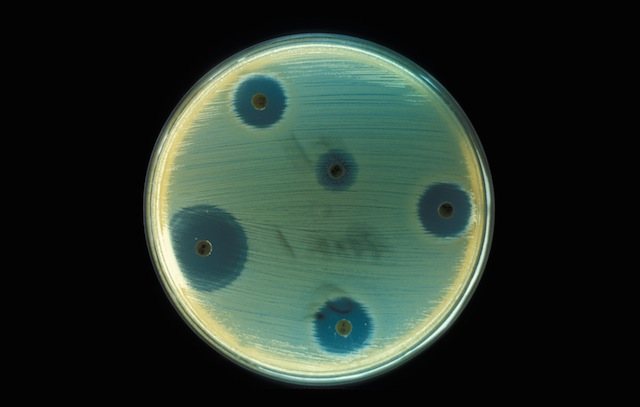
Bacteriologists started studying the "mould juice" out of interest and running some tests, but it was hard to cultivate and hard to produce in large quantities. It wasn't until WWII that the American pharmaceutical industry found ways to make large-scale production possible. 
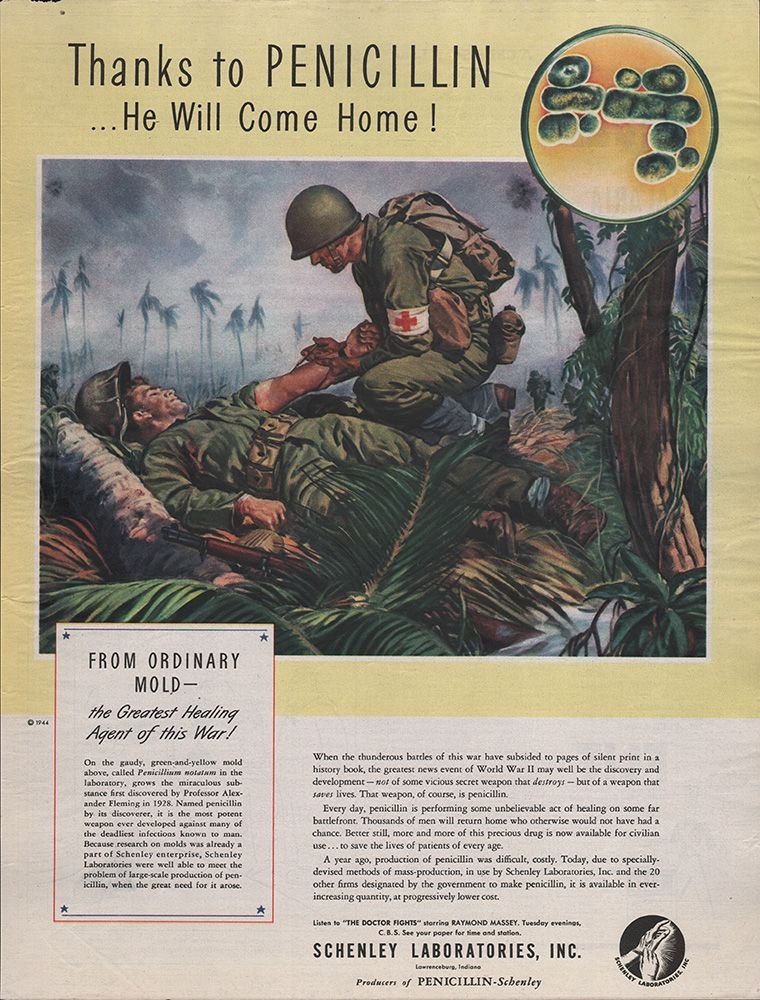
This also included a search to Penicillium strains that produced a high yield of a highly effective antibiotic - the best candidate found is now known as Penicillium chrysogenum, and the drug it produced was called penicillin. It began wide scale use as a medicine in 1942. 

Penicillin kills bacteria by inhibiting an enzyme necessary for creating bacterial cell walls, leading to the death of the bacteria. Since animal cells are different from bacterial cell walls, penicillin is able to effectively kill bacteria without doing any harm to animals. 
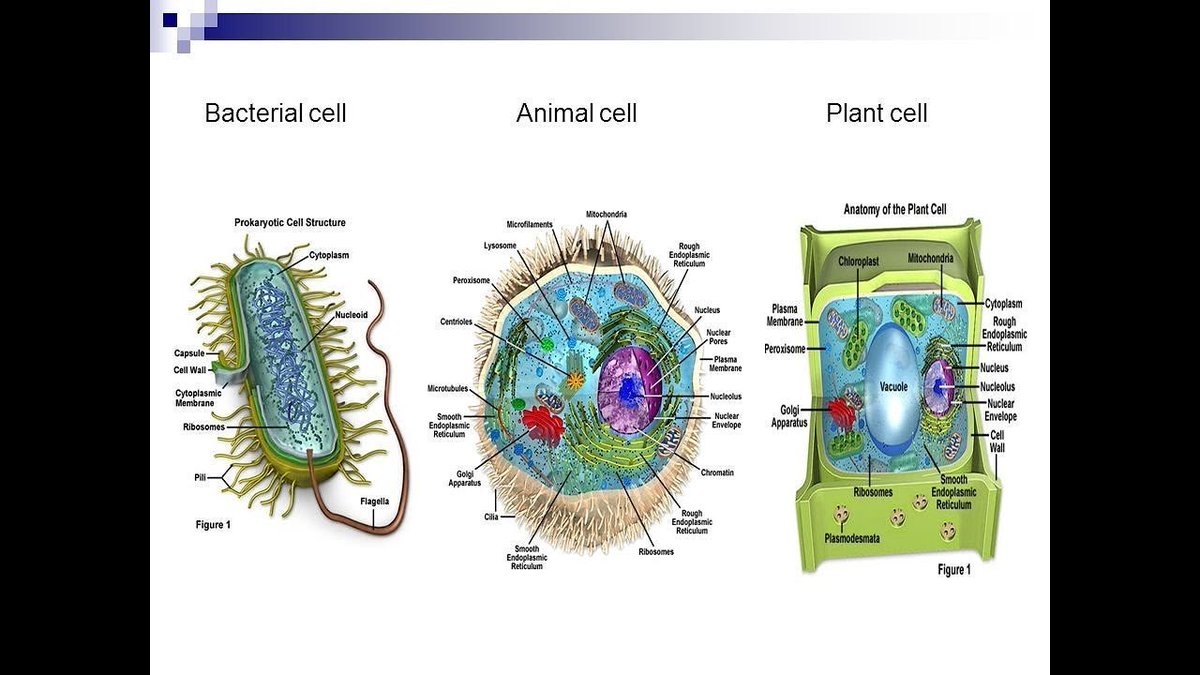
Since the discovery of penicillin, other antibiotic compounds have also been identified which have other methods of damaging bacteria, including blocking DNA synthesis or RNA transcription, inhibiting different enzymes, and inhibiting metabolites.
Depending on the method of attack, some of these other antibiotics may also cause damage to animals, so understanding how these compounds work is key to understanding the degree of danger in using them, and knowing which species of bacteria they are most effective in fighting.
This is why penicillin is still such a very valuable medicine, even with the new antibiotics still being discovered. Since 1942, it's estimated that penicillin has saved at least 200 million lives, making it the most effective life-saving drug in history!
The Common Stinkhorn mushroom is found in North America and Europe. It feeds on dead plant material, and gets its name because of the smell it emits when mature. The mushroom grows to somewhere between 4-12 inches tall and is a thick pale stalk that develops a dark, slimy tip. 
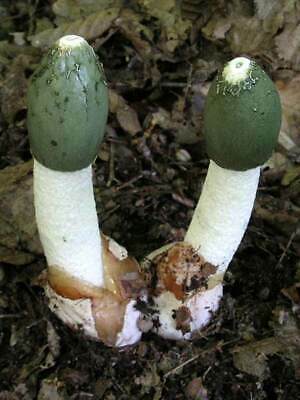
Flies are attracted to the smell and land on the gooey green spore-bearing gel. The flies get free food, and eat fungal spores at the same time, which are then carried away and spread to new habitats by the flies. Though it smells terrible, this mushroom isn't actually poisonous. 
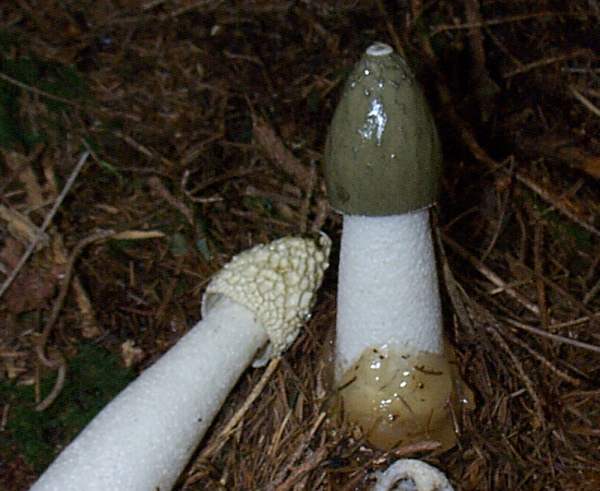
Historically, the mushroom was eaten as an aphrodesiac, presumably because of its shape; the Latin name for the Common Stinkhorn mushroom is Phallus impudicus (literally translated: "shameless penis") 😂 
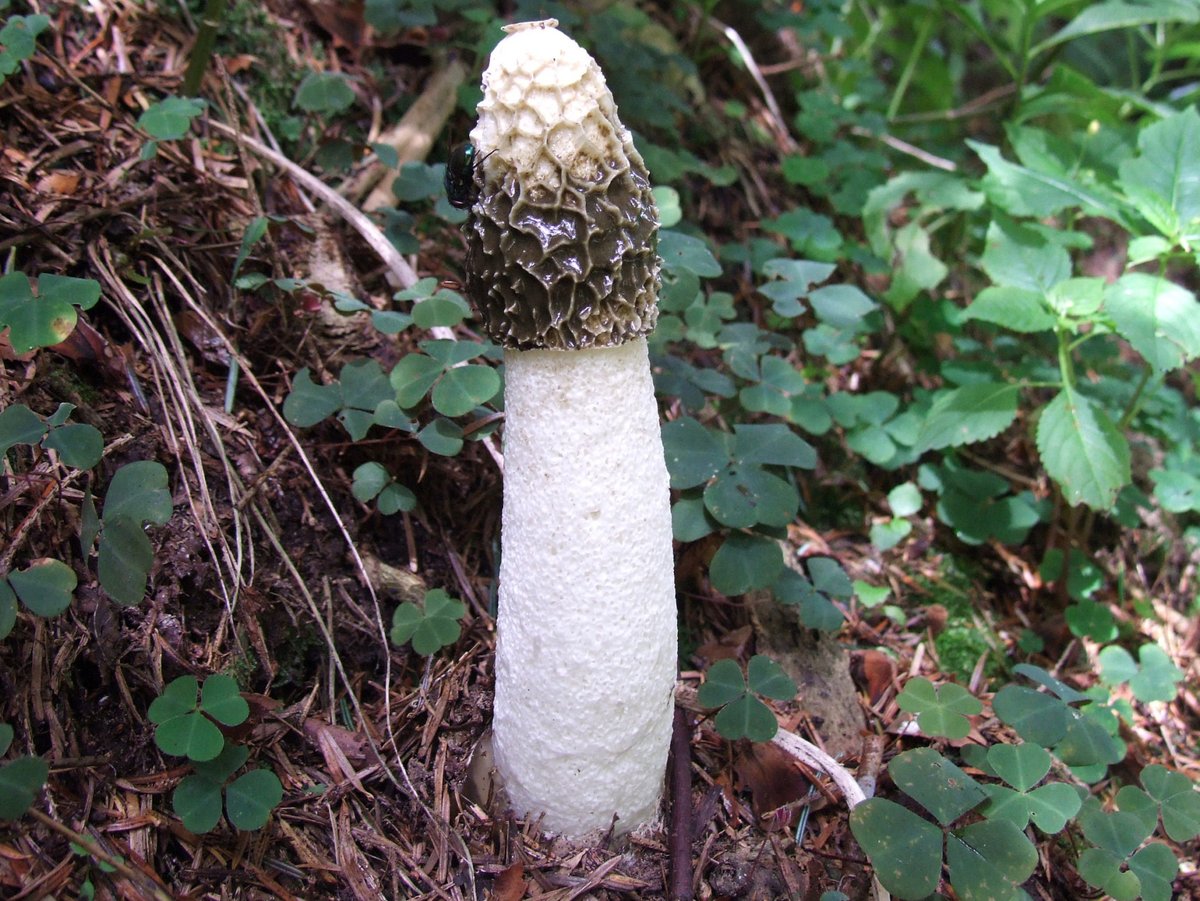
There's no evidence the mushroom actually works as an aphrodesiac, but there is some research suggesting it might have some medicinal potential as an anticoagulant. 😊
Let's talk lichen! Is it a plant? Is it a fungus? No! In fact, lichen is actually a symbiotic relationship between fungus and algae (or in some cases a cyanobacteria). (In some cases, it's a threesome - eurekalert.org/pub_releases/2…)
The fungi get free food from the algae (or cyanobacteria) which, since it's able to photosynthesize, can produce its own food from sunlight! Also gets some additional protection from dry environments fungi couldn't otherwise grow in.
It's less clear what exactly the algae is getting out of it, but possibly additional chemical protection from predators, additional access to nutrients from the soil and from decomposing stuff, and combined they can live in more environments than any of them can solo.
(Or possibly the algae is getting no benefit out of it and the fungi are just keeping pet algae for food ... but it's probably not a totally one-sided relationship since it happens in so many different types of lichens.) 
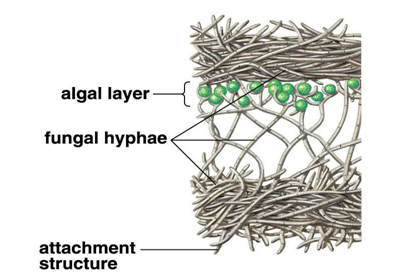
I think I mentioned about fungus, it'll figure out how to eat just about anything if nothing else has taken it (and sometimes even if something else has). That includes metal isotopes ... including radioactive ones, if they're included in the food that's available.
Some species of fungus are able to suck up radioactive isotopes from the environment, resulting in less radioactivity around them, but more radioactivity inside them. Both good and bad: it cleans up the area around them, but just makes it all the more concentrated in the fungi.
In particular this is a problem in colder climates, in areas that received radiation from the Chernobyl disaster (which is probably most of the world by now, since it's spread over time). The fungi in lichens sucks up the radioactive isotopes, resulting in radioactive lichen.
This doesn't particularly seem to harm the lichen as far as we can tell. But in the winter, in some areas lichen is about the only green thing around for animals like reindeers to eat. So the reindeer whose winter diet depends heavily on eating lichen ALSO become radioactive...
... and this isn't necessarily very good for the reindeer, and also not very good for any people around who rely on the reindeer for food in the winter. But, possibly it does mean Rudolph's glowing nose may not be quite as fictional as you imagined ... 😂
wired.com/2016/04/amos-c…
wired.com/2016/04/amos-c…
As a follow up to yesterday's info about radioactive lichens, in 1991-ish they discovered there are some species of fungi that can not just concentrate it, but actually EAT it. It appears they can use the radiation to produce energy, similarly to how plants photosynthesize.
They do this using a variation of melanin (the same pigment that makes human hair and skin dark). They've found melanin-filled moulds happily growing around the Chernobyl site - after all, nothing else wants to live there and eat that stuff, so a perfect opportunity for fungi. 
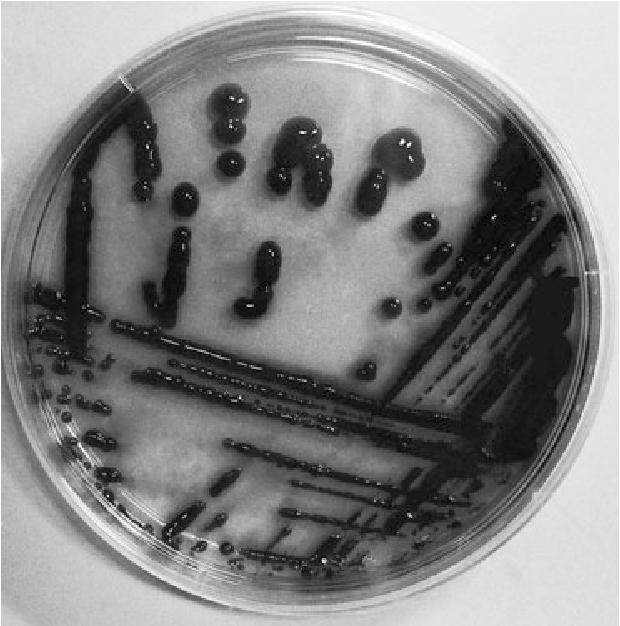
Not a lot is known still about radiosynthetic fungi yet, but there's obviously potential in cleaning up radioactive waste, as well as potentially finding ways to protect astronauts from space radiation. Cool stuff!
scientificamerican.com/article/radiat…
scienceagogo.com/news/200704222…
scientificamerican.com/article/radiat…
scienceagogo.com/news/200704222…
Inky Caps (Coprinus atramentarius) are edible mushrooms that grow in the temperate climate zones of Europe and North America. You've probably seen these growing on lawns or by the side of the road; so named because once the mushrooms get old they start to dissolve to an inky goo. 
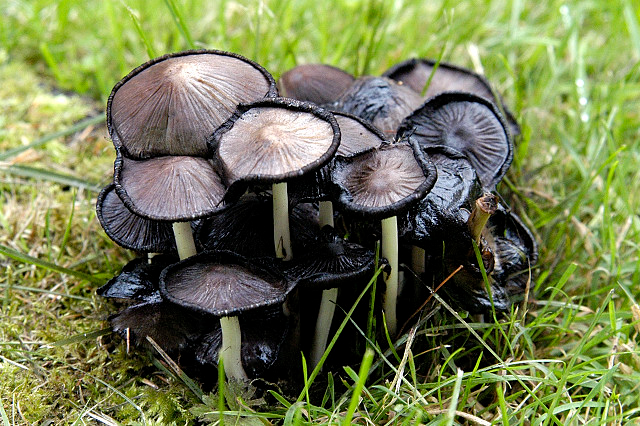
(You can even use them to make an ink you can write with!) They contain a compound called Coprin, which is completely harmless, so these can be safely eaten. EXCEPT...
This is only true until you start drinking alcohol.
This is only true until you start drinking alcohol.
When you drink alcohol, a poison, your body immediately starts to break down the alcohol into a series of other compounds, and eventually into harmless carbon dioxide and water. BUT, some of the compounds along the way are also poisonous, so your body needs to do this ASAP.
You get a hangover when your body can't process these poisons fast enough, so they build up enough to cause hangover symptoms. One of the first compounds created is acetaldehyde; acetaldehyde poisoning leads to hot flushes, nausea, vomiting, heart palpitations, & severe headache.
An enzyme known as acetaldehyde dehydrogenase (ALDH) is responsible for breaking down acetaldehyde (mutations in the ALDH gene are common in Asian populations, which is why many people from Asian backgrounds flush red very quickly after drinking any alcohol at all).
When you cook an Inky Cap mushroom, the Coprin in the mushroom breaks down into chemicals that interfere with the ALDH in your body, preventing it from breaking down the acetaldehyde. The result is a very fast and very bad case of a hangover, even if you only drink a teeny bit.
And Coprin hangs around in your body; it can last about three days, with physical symptoms of poisoning kicking in with as little at 5 mg/dL of ethanol, or about 3 oz. of beer.
Coprin poisoning isn't usually fatal, possibly because the effects of drinking alcohol feel so bad so quickly (within 5 minutes) that most people would immediately stop drinking. But, it could be dangerous for someone with a heart condition, and it can definitely be frightening! 
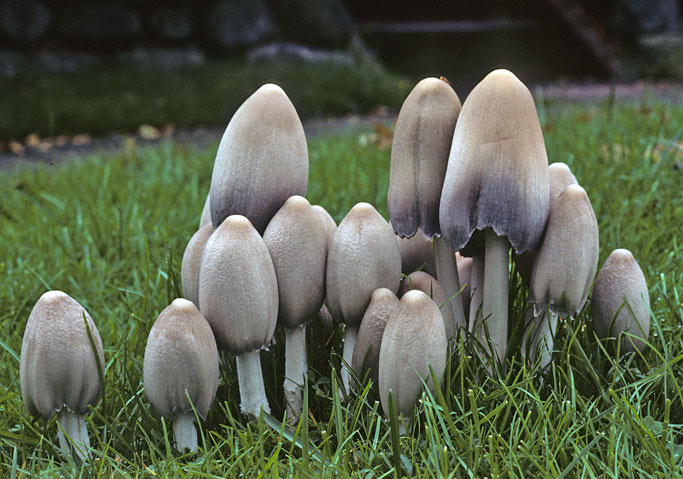
Bird’s nest fungus, in the family Nidulariaceae, is obviously named for its appearance. When the fruiting bodies are mature, they resemble tiny bird's nests, about 1/4 inch to 5/8 inches in width and height. It's a saprophyte, meaning it consumes decaying wood and plant matter.
It may seem odd for a mushroom to grow looking like a bird's nest, but the cup-shaped structure is part of the way the fungus reproduces. In the “nest” are tiny flattened spheres which look like eggs. These are small spore-containing capsules called peridioles. 
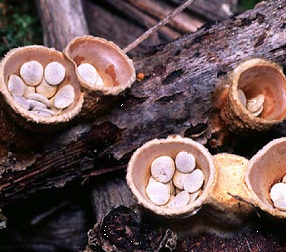
The nest structures usually form during the months of July to October and require rain to disperse. When a raindrop falls into the cup of the mushroom, it has enough force to fling the peridioles into the air; lab studies found they travel on average between 30cm to a full meter!
The peridiole has a coiled cord-like attachment on its underside, which has a sticky patch at the end called a hapteron. When the peridiole is flung through the air by a raindrop, the cord with the sticky end trails behind and catches like a wad of glue to nearby branches, etc 
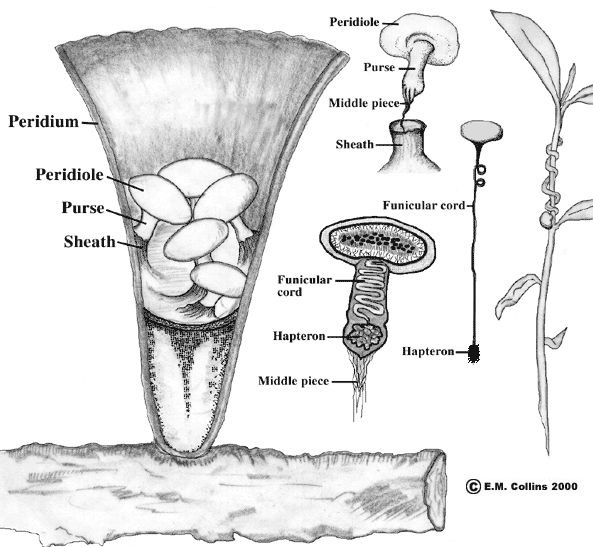
The still-flying peridiole continues onward until the cord fully unwinds, at which point, like a tetherball winding around a pole, the peridiole winds around the branch where the hapteron has become attached. The peridiole is now firmly tethered to hopefully a new source of food!
Once the rain ends and the “egg” dries out, it splits open releasing fungal spores.
Video showing spash-cup dispersal:
Video showing spash-cup dispersal:
Harold J. Brodie, a Canadian mycologist who studied bird’s nest fungi extensively, concluded in his 1975 book, The Bird’s Nest Fungi, that the mushrooms were “not sufficiently large, fleshy, or odorous to be of interest to humans as food,” however they are not poisonous. 
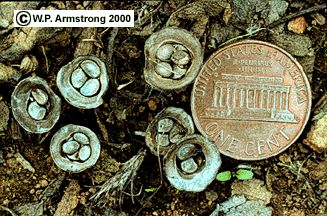
They also only eat already-dead plants so they're no threat to gardeners, just an interesting mushroom you might find on dead trees or mulch in your garden if the climate is right! 😊 
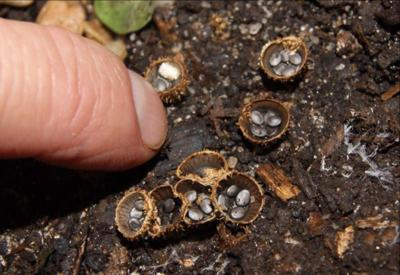
Most fungi (yeasts excepted) consist of a network of fine, hairlike filaments that spread throughout the soil or whatever the fungus is growing on. The individual threads are called "hyphae" (from the Greek word meaning 'web') and the mass of them is referred to as the "mycelium" 
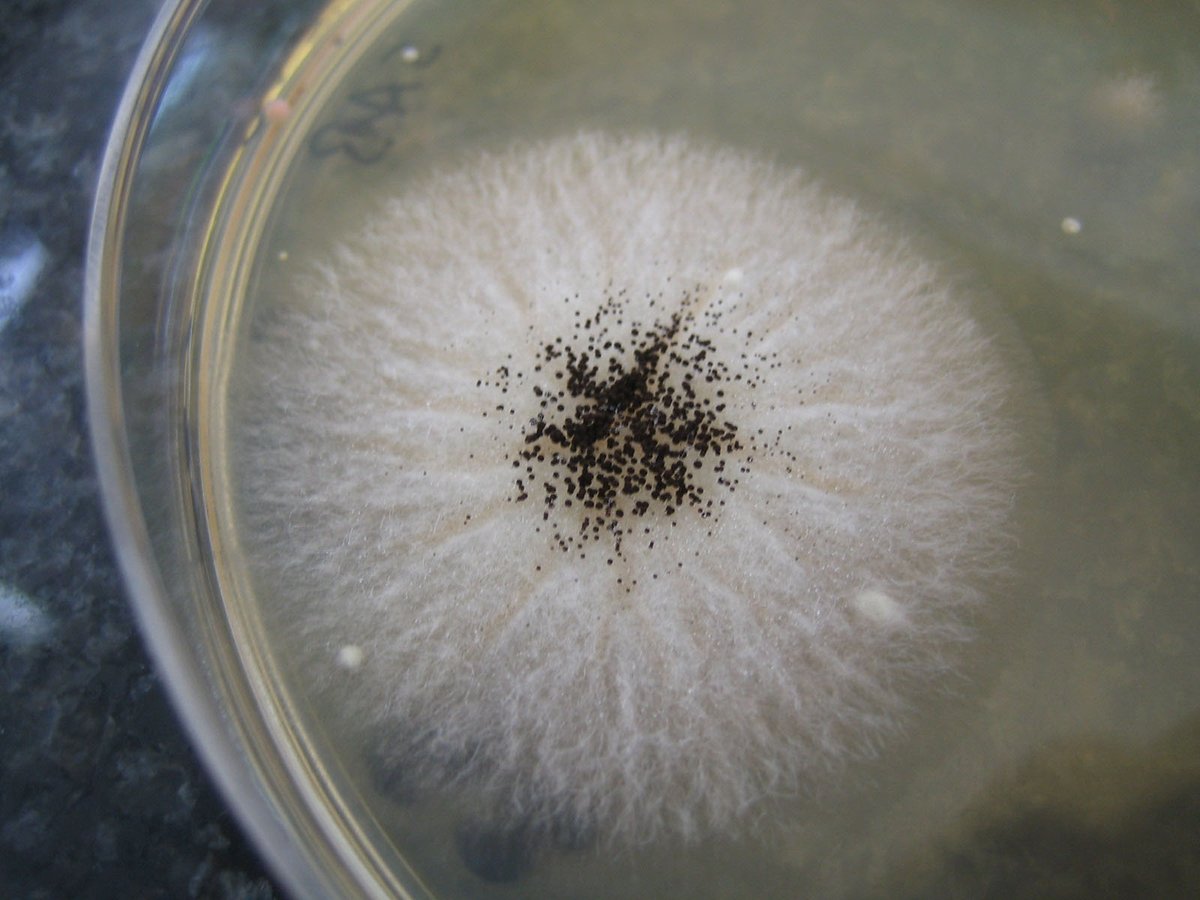
(Please note, everything Star Trek: Discovery says about mycelium is utterly ridiculous and please ignore everything about fungus mentioned in that show - for my previous rant please refer to my pinned tweet
https://twitter.com/pentapod/status/971940207317499904?s=20)
Often the mushroom or the spore-producing structures are the only parts we can visibly see, but the fungus itself is much larger. Although the mycelium may occasionally grow specialized structures such as mushrooms for reproduction, most of the time most fungi are simply hyphae.
As such, they do not have distinct organs in the way animals or even plants do; in particular, they don't have a mouth, or a stomach, or any way to swallow or digest their food. So how does an organism without a mouth or a stomach eat things? 🤔
Fungi are capable of absorbing nutrients dissolved in water through the whole surface of the hyphae. If the food can't be directly absorbed, the fungus secretes enzymes to break it down, essentially digesting the food OUTSIDE the hyphae, instead of inside a stomach like animals.
This is why patches of mould on a fruit become soft or even liquid; the fungus is digesting the plant cells and liquifying them so the nutrients can be absorbed through the hyphae walls. 
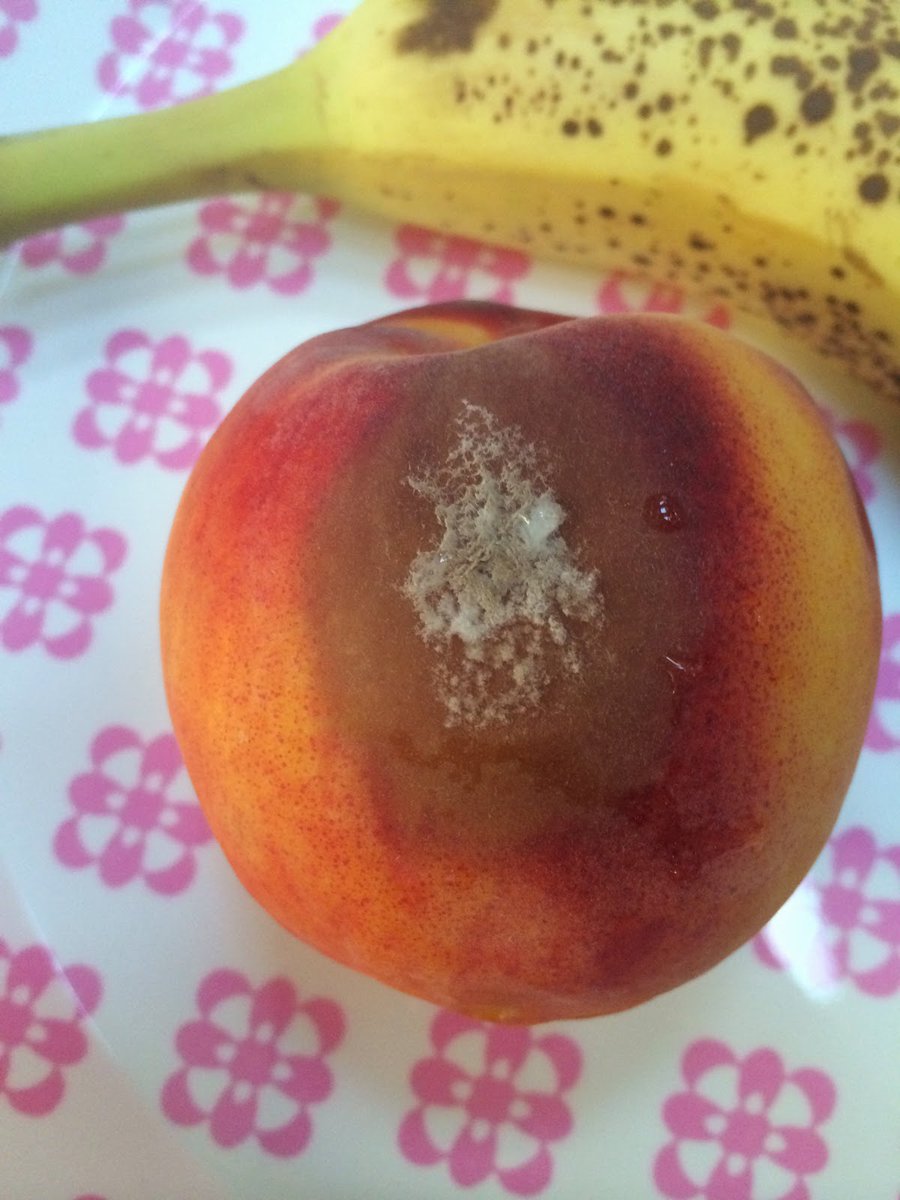
The enzymes extend further out than the hyphae themselves, breaking down the food in advance of the mycelium spreading into those areas. So there's the visible fuzzy mould patch you see, and around that a bigger area of buried hyphae, then that's surrounded by digestive enzymes. 
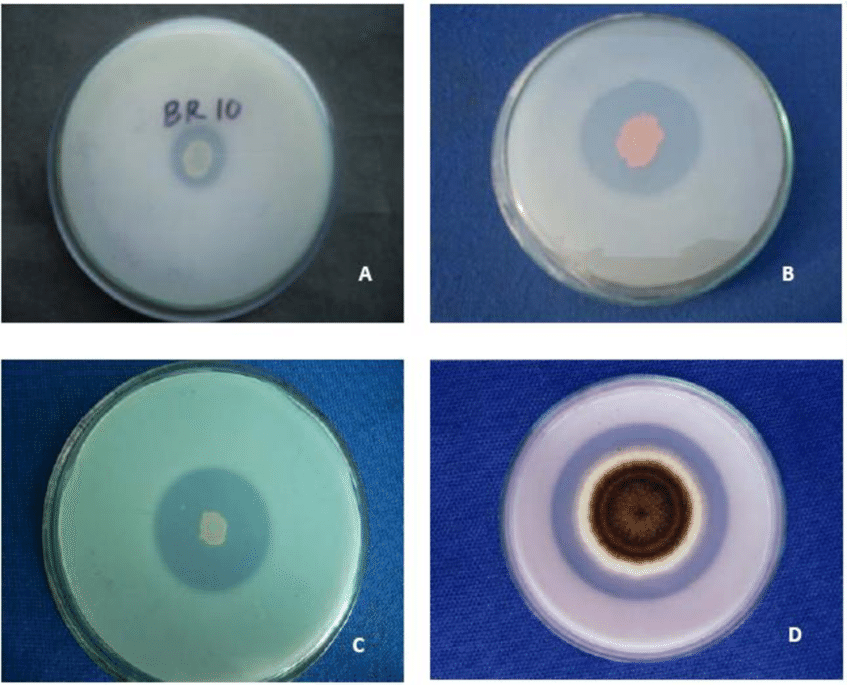
The digestive enzymes may also be accompanied by mycotoxins to discourage competitors from eating the nutrients first - these antibiotics vary from species to species but are produced to kill other organisms competing for the same food. e.g.: 
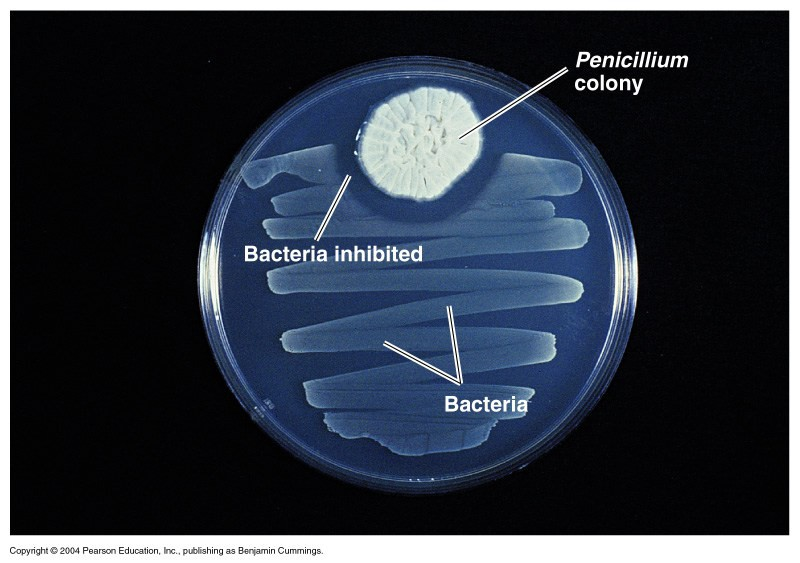
This is also why simply cutting off the visible mould from a piece of food does not necessarily make the rest good to eat; the mycelium and mycotoxins may extend invisibly within the food for much further than the spore-producing patch!
In 1988, when cosmonauts aboard the space station Mir noticed something growing across their windows, they were understandably worried what it might be. It took a while to identify the culprit, but it turned out to be something of a very terrestrial origin. 

Turns out that when humankind entered space, fungi came with them. And, as fungi tend to do, the fungi figured out a way to eat whatever was around ... and in this case, all they could find to eat was a space station. 
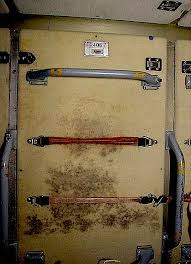
Mir has apparently been plagued with fungi for decades; astronauts visiting over the years have reported that it smelled like mildew or mouldy apples. The International Space Station has also reported fungal contamination.
Not only have the fungi found their way into space, but they've also proved surprisingly resistant to radiation, allowing them to thrive. Space-hardy fungi can potentially reveal useful information about radiation protection; this might also one day help protect astronauts too.
And the fact fungus can happily grow in space makes it a very promising possible source of food in space. However, the problem is that fungi aren't picky about what they eat; they'll try to eat pretty much anything that's available. Given "eat, or die" - they find a way to eat!
Unfortunately, that includes insulation, electrical wiring, window seals, even metal, which is obviously not ideal in a space ship or space station that needs to remain fully functional and completely airtight. To say the least. 

Many science fiction books use the idea of 'sleeper ships' to explain how humans might travel from one planet to another if faster than light travel turns out to be impossible. Humans in cryogenic sleep traveling for centuries until they reach a new home sounds good, in theory. 

But if hungry fungi hitch a ride, how much of a ship will be left after a few decades, let alone a few hundred years? The same concern might apply to a moon or mars colony, also.
It might not be bug-eyed alien monsters that are the greatest threat to humans reaching other worlds, it might be our own close relatives and indiscriminate recyclers of absolutely everything, fungi.
scienceline.org/2018/03/fungi-…
scienceline.org/2018/03/fungi-…
Clathrus archeri is one of the Phallales family of fungi and is related to the common stinkhorn (Phallus impudicus). In Britain this remarkable fungus is commonly known as Devil's Fingers, and in parts of the USA it is referred to as the Octopus Fungus. 
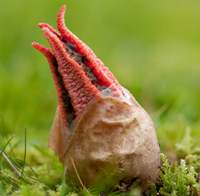
When young, it's a small white egg-shaped ball, but as it ages a large, starfish-like fruitbody with 4-6 arched red arms emerge from the egg. The arms are coated with a smelly spore-bearing goo which has a strong, unpleasant odour reminiscent of rotting meat, to attract flies. 

Clathrus archeri is originally native to Australia and New Zealand, but is now present in parts of Europe, where it was first recorded in 1914 in France, apparently introduced with military supplies at the start of the First World War.
It's also found in North America, especially in California, where it was first reported in 1982 and considered to have been introduced with exotic plants. It is saprotrophic (eating dead plant material), and mainly found in leaf litter under trees and shrubs and on bark mulch.
Despite its threatening appearance and bad smell, it is not poisonous, but is also not reported to taste good and there are no reports of it being good to eat.
This timelapse video is very cool 😊
This timelapse video is very cool 😊
Sunday Fungus update! 😊
When you think about two completely different creatures that have formed a mutually beneficial relationship, maybe you think of those little birds that pick the scraps out of an alligator's teeth.
When you think about two completely different creatures that have formed a mutually beneficial relationship, maybe you think of those little birds that pick the scraps out of an alligator's teeth.

Or maybe you think about humans and dogs. You probably don't think about fungi ... but of course you should. The relationship between fungi and plants is at least 400-460 million years old ... making the friendship of people and dogs seem like a one-night stand in comparison! 

There are many fungal species that form a symbiotic relationship with plants; as a group they are called mycorrhizae: from the Greek "mukés", meaning fungus, and "rhiza," meaning roots.
Mycorrhizal fungi live in the soil and interact with the roots of plants and trees to create a massive underground network. At least 80% of plant species appear to benefit from mycorrhizal fungi, and some (such as orchids) cannot survive at all without their help. 
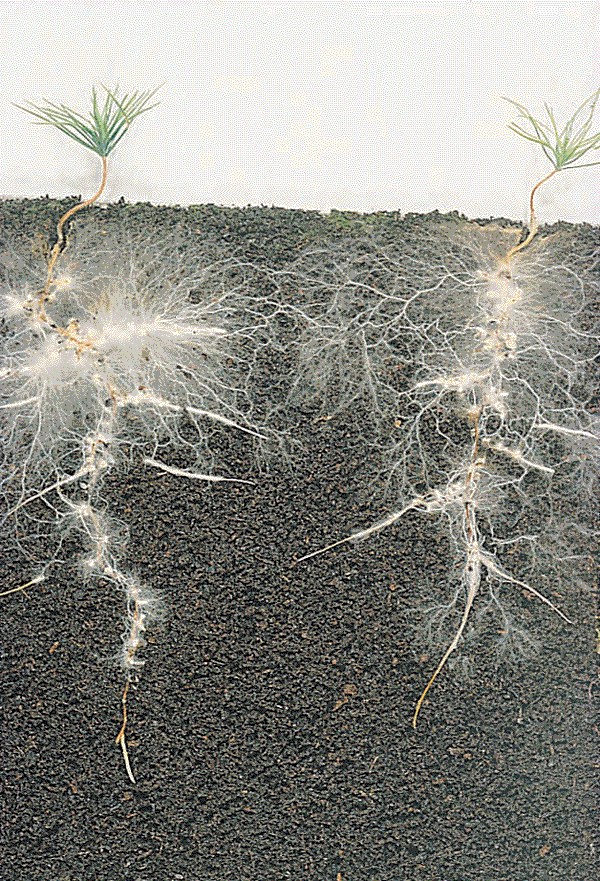
It's fairly obvious what the fungi gets out of the relationship: plants can photosynthesize to produce carbohydrates from sunlight, and the plant shares these with the fungi, which cannot.
What the plant gets out of it varies depending on the fungus and the plant, but mycorrhizae appear to increase the absorption of nutrients, particularly phosphorus; extend the area from which the plant can get minerals & water; increase the plant's resistance to disease; & more. 
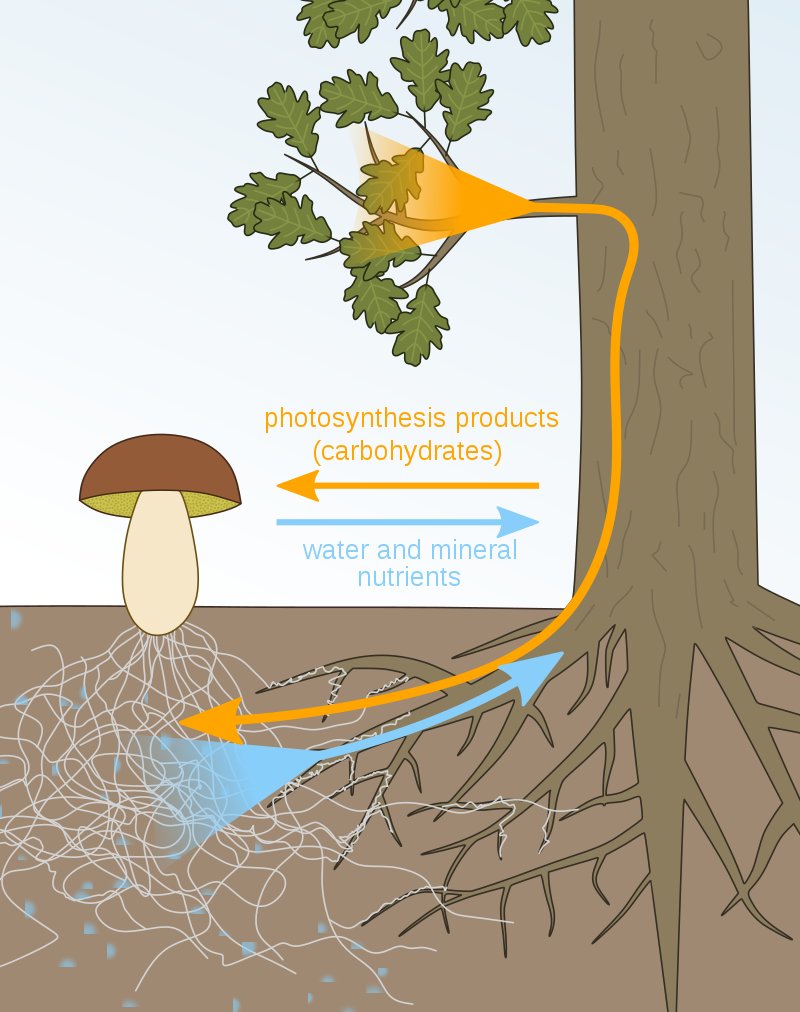
Mycorrhizal networks have been called the "internet of plants" and while it's obviously not a completely direct parallel, it is a massive interconnected network through which many signals and resources can be passed between plants and fungi, and even between different plants.
Different mycorrhizae associate with different types of plants; some fungi specialize in one or a few species of plants, while others don't specialize. One plant may have many types of mycorrhizal fungus, and there's evidence that as plants age the mycorrhizal species change too.
In agriculture and forestry, an understanding of the mycorrhizal networks is essential for growing successful crops and healthy forests. Farmers don't just need to grow healthy crop plants, they need to cultivate healthy mycorrhizae also. 🌱🍄🤗 
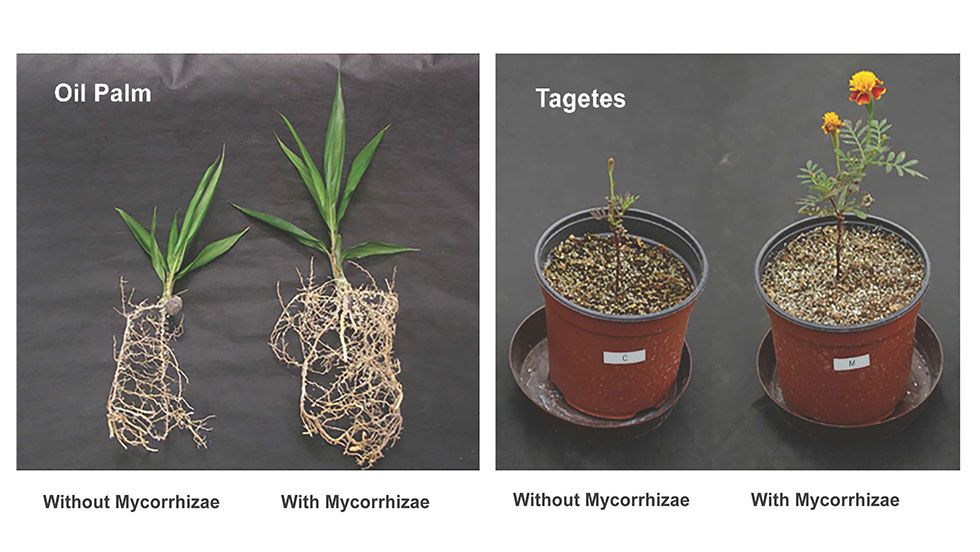
Yakushima, Japan is a subtropical island whose most popular attraction is an ancient forest of cedar trees with massive trunks that reach more than 5 meters in diameter. 

However, in 2015 Suetsugu Kenji discovered it's also home to an unusual plant that he named Sciaphila yakushimensis, one that spends a lot of the year underground where it's safe from predators, and only emerges a few centimeters above ground when it flowers or fruits.
It's difficult for plants to get enough light to photosynthesize when they're growing in the shade of the massive cedar trees, and Sciaphila yakushimensis has solved this problem by becoming what's called a "mycoheterotrophic" plant.
In other words, this purplish coloured plant does not photosynthesize - instead, it traps strands of underground fungi in its roots and steals the nutrients it needs from the fungi! 

In this relationship, the cedar trees photosynthesize sugars from the sunlight. They have a mutually beneficial symbiotic relationship with the mycorrhizal fungi in the soil, and share the photosynthetic food products with the fungi in exchange for water and nutrients. 

Sciaphila yakushimensis appears to be an uninvited third party in this unusual threesome, stealing food from the fungus so it doesn't have to do the photosynthesis itself!
newscientist.com/article/207821…
newscientist.com/article/207821…
One of the weirdest looking mushrooms you may ever see is Hydnellum Peckii, aka Bleeding Tooth Fungus. Located in forested, often mountainous, areas in North America, Europe, Iran, and South Korea, this fungus has a symbiotic relationship with the coniferous trees it grows near. 

The adult mushroom is beige and fairly dull looking. However, when young and actively growing, this whitish mushroom appears to bleed from its pores, inspiring many colorful names (it's also known as Devil's Tooth, and Strawberries and Cream).
The liquid is caused by guttation - a process by which very wet soil forces water up and out of pores at the top. In this case, the liquid appears red thanks to a pigment that forms in the mushroom. H. peckii is not toxic, but is tough, and bitter and peppery to the taste. 

However, the mushroom can be used to create a beige dye or combined with other substances to create blue-green hues. Chemical extracts from H. peckii can also be used as an anti-coagulant and have some antibacterial properties.
nationalgeographic.com.au/nature/the-ble…
nationalgeographic.com.au/nature/the-ble…
Pilobolus crystallinus, commonly known as the "Dung Cannon" or "Hat Thrower", is a species of fungus belonging to the Mucorales order. It grows in dung - a rich source of food for a fungus. But, as with any rich source of food, there's a lot of competition for it. 
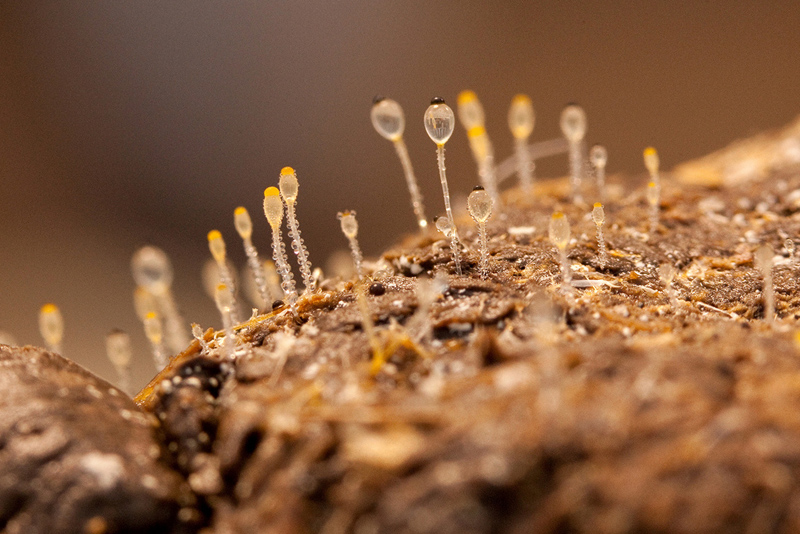
Insects, bacteria, other fungi... all are potential competition for the dung. So Pilobolus crystallinus has a unique strategy to get there first - it gets there first by being there already, from the very start.
It produces spores at the end of liquid-filled structures (sporangiophores) shaped like a lens to focus the sunlight, which allows it to know which way is up. Liquid pressure builds up until the spore at the tip is literally shot into the air like a cannon - hence "Dung Cannon"! 

The spores travel up to 1m away and stick to the blades of grass nearby, where they are then eaten by passing cows or horses. This gets the spores directly into the digestive tract of the grazing animal. The animal's digestive system stimulates the spores into germination...
...as they pass through with the rest of the animal's food and out into the world again, guaranteeing P. crystallinus will be the very first organism present in the newly-deposited dung. After eating this new food source, it grows new sporangiophores and starts the cycle again. 

Although this fungus is tiny, the immense pressure in the sporangiophore means the spore structure accelerates 0–45 mph in the first millimeter of its flight, which is an acceleration of an incredible 20000 g. That's about 1.7 million m/s2 - faster even than guns and rockets!
So, while the lowly "dung cannon" may not be the fastest animal on earth, because it's not an animal, it can definitely put in a strong claim to be the fastest creature on the planet!
BBC video:
BBC video:
Saturday fungus update - now with extra LSD!
Ergot fungus is a term that refers to a group of fungi of the genus Claviceps. It comes from the French word meaning "cock's spur", because the fungus creates a hard purple structure that looks similar.

Ergot fungus is a term that refers to a group of fungi of the genus Claviceps. It comes from the French word meaning "cock's spur", because the fungus creates a hard purple structure that looks similar.


In spring, spores of Claviceps germinate and infect the unfertilized flowers of rye. It induces the cells to divide and enlarge, creating the large purplish growths (sclerotia). These are hard protective structures that allow the fungus to survive adverse conditions like winter. 

In spring, these germinate to produce spores that reinfect the crops once again. Cold winters and damp springs are ideal conditions for maximum infection. An ancestor of Claviceps has been found in the fossil records back at least 100 million years, to the early-mid Cretaceous!
The most famous ergot fungus is Claviceps purpurea, a parasite that grows on grass and cereal species in temperate climates all around the world, and in particular rye. Ergots are so commonly associated with rye that they were included in early botanical drawings of the plant. 

It wasn't until the 1600s that it was realized the ergot was a parasite of the rye, and not a normal part of rye itself!
rcpe.ac.uk/journal/issue/…
rcpe.ac.uk/journal/issue/…
The fungal infection doesn't seriously harm the rye; some flowers are lost to the infection, at worst causing up to 50% loss of the grain, but the fungus exclusively affects only the flowers, leaving the rest of the plant unharmed.
HOWEVER...
HOWEVER...
...as the hard sclerotia growths form, the fungus produces large amounts of toxins in them, presumably to discourage scavengers from eating its "seeds" as they lie around over winter waiting for spring. 

These toxins are alkaloids and include the precursors to d-lysergic acid diethylamide, otherwise known as LSD, as well as other poisons. LSD was first synthesized from ergot in 1943 by chemist Albert Hofmann, who was looking for medically useful compounds. 

When ingested by human beings and animals, different concentrations of ergot alkaloids will have varying effects ranging from hallucinations and burning sensations, to DEATH. In human beings, symptoms documented included hallucinations, vomiting, psychosis, and delirium.
Some of the other impacts of these substances include headaches, convulsions, vertigo, and painful vasoconstrictions, which may even lead to gangrene. In other words.... DON'T go eating rye ergot hoping to get high.
Before the dangers of ergot were understood, infections of rye crops could cause severe poisonings as the fungus was milled with the rye crop and baked into breads (the toxins are not affected by water or heat). Outbreaks of ergotism could cause madness and death in a village.
In general, as little as 2% of ergot in the grain is sufficient to cause an epidemic! There is also a debated theory that the madness and hallucinations of the Salem Witch Trials may have been caused by, or at least exacerbated by, ergotism. 

Between 1770 and 1771, about 8000 people died in one district alone in France. There is no specific treatment for the poisoning, only alleviation of the symptoms if possible.
sciencedirect.com/topics/pharmac…
sciencedirect.com/topics/pharmac…
As with many fungal toxins, there ARE pharmaceutical uses for ergot byproducts (as well as recreational ones), including using it for reduction of bleeding, migraine treatment, and even Parkinson's disease. But as always... leave this to the chemists, don't try this at home! 😱
This is a huge topic and I could add a lot more, but twitter's not the best medium for massive essays, so I'll close with a link to more historical info about ergotism (also called St. Anthony's Fire) and you can find lots more info online if interested! herbmuseum.ca/content/st-ant… 

The Presidential Estate of Castelporziano is a walled estate not far from Rome that's been sealed off from the rest of the world since 1562. For the past 500 years almost no-one has been allowed into the estate, except for a few popes and wealthy hunters. palazzo.quirinale.it/residenze/c_po… 

This has made the area a nearly untouched nature reserve filled with Italian flora and fauna, including the iconic Italian stone pine (Pinus pinea). However, in the 1980s, caretakers at the estate noticed signs that the pine trees were getting sick... 

...and over the next decades the pine trees have continued to die off, leaving a gap in the forest 100m wide and growing. DNA samples from the dying trees found the culprit is a fungus called Heterobasidion annosum - and not native, but a strain that came from the eastern USA 🤔 
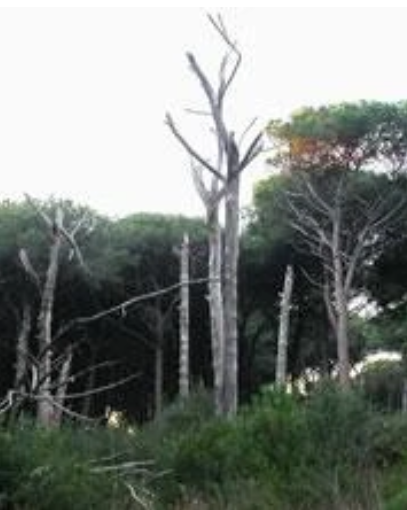
H. annosum spreads from root contact and airborne spores across short distances, but certainly not intercontinentally. It was a mystery how this American fungus could be killing pine trees in a sealed estate in Italy, until ...
...researchers found that in 1944, American forces briefly used the estate as a temporary camp as they fought to liberate Rome. Once they left, they were all but forgotten - but wooden supply crates they brought with them, which were made from untreated wood, may not have been. 

H. annosum spreads very slowly and takes decades to mature to the point that adult trees would start to die, so pine trees infected in 1944 might not have displayed obvious symptoms until the 1980s. 
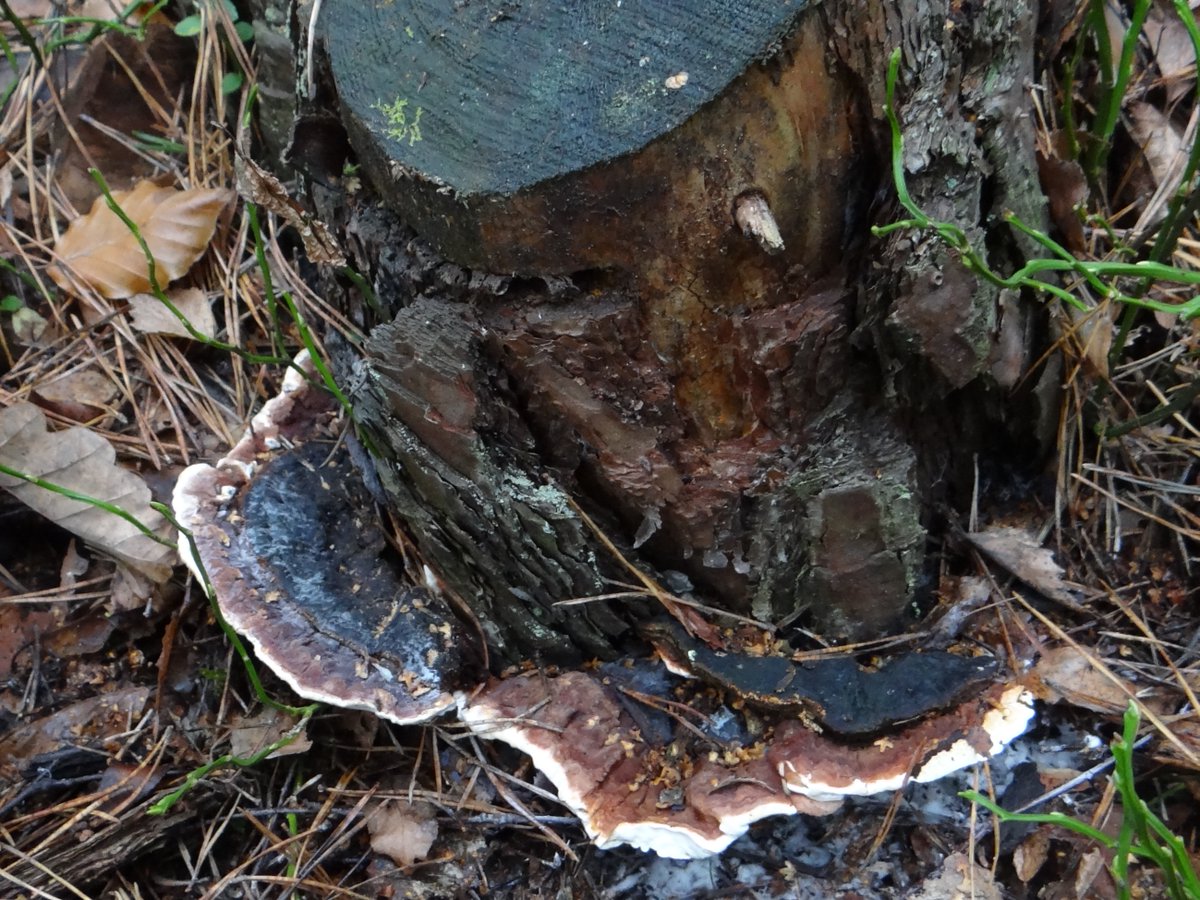
Now local experts are desperately trying to stop the pathogen from spreading outside the estate to devastate the Italian forests more widely. The dying pine trees of Castelporziano illustrate how serious long-term damage can be caused by short-term human carelessness... 

... and who knows how many other slow infections are spreading because of careless human actions around the world, still undiscovered - for now? 😢
In 1991 in the Otzal region of the Italian Alps, the body of a neolithic man was recovered from a glacier. Beautifully preserved, the man provided an amazing opportunity for scientists to study the body, clothing, and belongings of a human of that time. britannica.com/topic/Otzi
"Otzi" (as he came to be called) was over 5300 years old, and among the things that he carried were two species of polypore fungus. In his bag were pieces of the bracket fungus Fomes fomentarius, and hanging from a leather strap was a chunk of birch polypore, Fomitopsis betulina.
F. betulina has medicinal properties as an anesthetic, and can also be used as tinder, and may have been carried around for one of these reasons. F. fomentarius is known even today as an excellent fire starter, and it's likely the ice man would have used this fungus for that. 



One of the common names of F. fomenatrius is "tinder fungus" for this very reason. The spongy layer just under the hard outer skin is dry and flammable, and can smolder for hours. It can be soaked and pressed into cloth-like sheets called "amadou" (from the French for tinder). 

When made into amadou, besides its use as tinder, it can also be used as a fabric and has a soft texture like cork or suede; this material is also extremely water absorbent and can be used to dry things out.
paulkirtley.co.uk/2011/easy-way-…
paulkirtley.co.uk/2011/easy-way-…

Amadou on its own isn't extremely durable, but materials designers are experimenting with ways to make it more long lasting, and a number of clothing designers are now starting to use it as a vegan leather substitute.
e.g. etsy.com/ca/listing/292…
e.g. etsy.com/ca/listing/292…

As mentioned yesterday, fungi like Fomes fomentarius can be used to make a leather-like material with a texture similar to suede. German company ZVNDER has been experimenting with ways to create a more durable leather from F. fomentarius sourced from the forests of Transylvania. 

They produce wallets, watch straps, and similar leather products and have also teamed up with a luxury sustainable footwear company called Nat-2 to produce a sneaker made from fungal leather. (Nat-2 also makes moss and algae sneakers, among other things.) 

The fungal leather ZVNDER creates is produced with no chemicals, no animal cruelty (no animal products at all), ethical manufacture, and all the waste products are biodegradable and fully recyclable. 🥰
nat-2.eu/nat-2-fungi-li…
nat-2.eu/nat-2-fungi-li…

A San Francisco based startup called MycoWorks is also experimenting with fungal leather, this version based on the reishi mushroom, Ganoderma lucidum. They are able to produce a cow hide volume of mushroom leather in under two months and using very little space or resources! 

Compare this to leather from a cow which requires at least two years for the cow to mature, and consumes a lot of space and resources. Not to mention, the cow. 🐄 #vegans
In contrast to the harsh chemicals required to tan leather, MycoWorks has also found treatments that require few chemicals and have a minimal carbon footprint, which is a win all around, not just for the cows. futurism.com/not-just-meat-…
Zero Grado Espace in Italy has also produced a fungus leather called Muskin, This uses Phellinus ellipsoideus, a large fungus that kills trees in subtropical forests. Sheets of Muskin leather are currently available sold by the sheet. lifematerials.eu/en/ 

Designer Junas Edvard in Denmark has a line of products called Myx, which uses Pleurotus ostreatus (oyster mushroom) mixed with left over plant fibre material from the textile industry to grow objects like lamp shades in whatever shape is desired. 

As the objects grow, they produce oyster mushrooms, which can then be harvested and eaten before the finished item is dried out to complete it. To recycle, just get the objects wet and leave them to decompose naturally - no waste! jonasedvard.dk/work/myx/
Ecovative Design, based in New York City, has a "Mycelium Foundry" they use to produce a variety of fungus-based materials, including eco-friendly packing materials, building materials, and textiles. 

They initially prototyped designs with Pleurotus ostreatus, the edible oyster mushroom, but have experimented with a range of different species for different effects. fungimag.com/spring-2012-ar… 

In 2018 they teamed up with Bolt Threads to successfully launch a mycelium leather bag on Kickstarter: wasterush.info/mycelium-leath… 

Students working with NASA also used Ecovative Design's fungal foam materials to create a biodegradable drone which will simply decompose if it crashes somewhere it can't be retrieved. As long as it comes back home and is stored safe and dry, it remains intact and can be reused.
While the engine and rotor parts are not yet biodegradable, one day it's possible these too can be made from a more environmentally friendly material also. 😊washingtonpost.com/news/speaking-…
In recent years, there have been numerous experiments to see if fungi can be used as a construction material. Since it grows fast, eats garbage, and is fully biodegradable, there are some clear benefits if we can find a way to make fungus into a building material. 

When dried, the mycelium is extremely durable and also waterproof, making it a potential replacement for plastic-based products that are very harmful to the environment. dezeen.com/2015/01/21/mov…
In 2014, the world's first fungus tower was constructed at the Museum of Modern Art's PS1 space in New York: constructed of "Hy-Fi" biobricks, grown by mixing fungus with corn stalks, and allowing the fungus to grow into bricks as it consumed the corn. 

The bricks of fungal mycelium were then used to construct a 13-meter-tall tower, which hosted public cultural events for three months.
It was then disassembled and the bricks were composted, returning the resulting soil to local community gardens. inhabitat.com/interview-arch…
It was then disassembled and the bricks were composted, returning the resulting soil to local community gardens. inhabitat.com/interview-arch…
In 2017, Asif Rahman and Yassin Arredia Design teamed up to produce the "Shell Mycelium" installation in Fort Kochi, Kerala. They were addressing the problem that for many limited time events and exhibitions, temporary shelters need to be constructed which are later destroyed. 

This pavilion was built of fungal mycelium, to show how temporary structures could be constructed for short term events like sports events. This was built with the intention of being short-term and recyclable, but more durable structures are also possible.
dornob.com/is-fungus-the-…
dornob.com/is-fungus-the-…
In 2017, a student at Brunel University worked with Astudio architecture firm to create "Grown Structures." Thick tubes of fungal mycelium mixed with waste cardboard and grown in flexible tube shapes that can be shaped is needed. 

The tubes take about 4 weeks to grow on a shaped mold in a greenhouse to produce whatever shape is required, and can then be used as building material. The structure also grows oyster mushrooms which can be eaten. inhabitat.com/these-amazing-… 

In 2019, "The Growing Pavilion" was created at Dutch Design Week. This is another temporary pavilion built from mycelium panels with a wooden framework. The entire building was designed to be temporary and fully recyclable at the end of the exhibition. 



Every day, the creators harvested edible oyster mushrooms from the building itself, and cooked and served them to visitors. thegrowingpavilion.com/about/ 

Another similar effort is currently underway from a company called Redhouse Biohab. Redhouse has been working on several ways of using mycelium bricks as ecologically friendly building materials. The Biohab is one of these proposals ...
... this one intended to help build shelter and contribute to the economy in Namibia. Not only would these buildings provide shelter, but also food to eat or sell as the oyster mushrooms can be harvested. 😋
In 2018, community college student Katie Ayers watched a documentary about fungi and decided to try a fungus-based project. She decided on a boat - and with the help of Nebraska Mushroom LLC, created an 8 foot long mushroom-canoe and took it for a six-hour ride down the river! 

Ayers initially created a boat shaped frame out of wood, and then created a mold which was lined with wood pulp and sawdust inoculated with a solution containing spores of the wood rot fungus Ganoderma lucidum. The fungal mycelium grew around the frame in the shape of the mold... 

...consuming the wood pulp for food, and was then removed from the mold to dry out thoroughly. The entire process took only about two weeks, and created a waterproof and buoyant boat Ayers calls the "Myconoe". 😂
Best of all, since it is still a living organism, it grows a fresh crop of mushrooms after each outing in the river, which she can then harvest! 🍴🍄😋
nbcnews.com/news/us-news/f…
(and thanks to @PartPurple for pointing this out to me!)
nbcnews.com/news/us-news/f…
(and thanks to @PartPurple for pointing this out to me!)
The kingdom of fungi is huge and diverse and there are no doubt many, many species of fungi we have not yet discovered. This month marks the first time that a new fungal species (possibly any new species) has been discovered on twitter, however!
The discovery happened when researcher Anna Sofia Reboleira at the University of Copenhagen in Denmark saw a photo of a millipede that had been tweeted by researcher Derek Hennen, at Virginia Tech in Ohio.
Reboleira spotted some tiny dots on the millipede that looked like a type of fungal parasite, but which she knew had never been observed on a North American millipede. (Circled in red) 

After some investigation of millipede samples in the University of Copenhagen's Natural History Museum, Reboleira and a colleague confirmed the presence of a new species of fungal parasite, belonging to the order called Laboulbeniales.
Fungi of this type are parasites of insects, and live on the outside of the host insect. The newly discovered species appears to infect the reproductive organs of North American millipedes Cambala annulata and Cambala hubrichti and is transmitted to other millipedes when mating.
The Laboulbeniales type fungi are a fairly recent discovery; only 8 were known prior to 2014. Likely due in part to their extreme specialization and tiny size: entomologists may not have recognized them as a fungus, and mycologists may not spend much time looking at insects.
In recognition of its unusual method of discovery, the new fungus is now officially named... Troglomyces twitteri. 😂
phys.org/news/2020-05-b…
phys.org/news/2020-05-b…
Truffles are the spore-producing structure of certain species of fungus, but they don't form mushrooms as we commonly recognize them. Instead, truffles form sac-like structures that look and grow more like a potato ... 

...for this reason, the best known species of truffle-producing fungus has the genus name "Tuber"; best known truffle species include Tuber aestivum (summer or burgundy truffle), Tuber Melanosporum (black truffle), and Tuber Magnatum (white truffle). 

While most common in Europe, truffles have been produced in New Zealand, Australia, Syria, and North America. They are normally found in the fall and winter seasons and are best eaten fresh.
Because the spores are produced in an underground fruiting body, they don't disperse by air the way normal mushroom spores do. Instead, they rely on animals to dig up and eat the truffles, which spreads the spores around the animal's habitat. 

Species of Tuber attract wild pigs by producing a chemical that smells similar to the saliva of boars in heat. As far back as 1600 BC truffles have been prized for their taste, but it wasn't until recently that it was understood exactly what they are and how to cultivate them.
The fungi that grow truffles are mycorrhizal - which means they form a symbiotic relationship with the roots of certain tree species (commonly oak, hazelnut, and poplar, and there is a species more recently discovered associating with pecan trees in the US). 

The fungi cannot grow without the tree, and it may take up to 7 years from planting before the first truffles form. As a result, it is a slow and very expensive process to cultivate truffles, and truffles can be valued at as much as $300 per pound! 

Chocolate truffles are called that b/c they look similar to actual truffles. Since truffles got named "tuber" because they look similar in appearance to potatoes, technically chocolate truffles could be called chocolate potatoes too.... but it probably wouldn't sell as well! 😄 

Chanterelles (genus name Cantharellus) are one of the most popular and prolific wild mushrooms, growing all across Europe and North America. There are over 40 different varieties found across North America, of which the Golden Chanterelle (Cantharellus cibarius) is most popular. 

Known for their beautiful colour, rarity (they only grow from late summer till the first frost) and most importantly their flavor. Very few people eat chanterelles raw; they are peppery tasting and can upset the stomach. When cooked, they have a highly prized mild, nutty flavour.
Chanterelles are a mycorrhizal mushroom (like truffles too), meaning they have a symbiotic relationship with certain tree species, which include pine, Douglas fir, hemlock spruce, oaks, beech, maple, and other trees as well. 

Because they require the trees to grow, this makes them difficult and expensive to cultivate, so they're picked almost exclusively in the wild. This makes the chanterelle business a multi-hundred million dollar, progressive, non-timber forest product enterprise...
... making chanterelles potentially more long term profitable in some cases than the logging industry that it competes with for forest resources! Global trade in chanterelles in 1997 was estimated to be US$1.67 billion (world production from 150 000 to 200 000 metric tonnes/year)
The 1995–2005 trade data for the European Union markets estimated the value of Canadian chanterelle mushroom exports ranged from $1 to $5 million annually. 😮 

Whether or not you like orchids, did you realize that without fungi, they probably wouldn't exist? All orchids are reliant upon mycorrhizal fungi, because they have at least one stage of life when they're unable to photosynthesize. During this stage they rely on fungi for food! 

Orchid seeds are tiny, like little dust particles, and unlike most seeds they contain almost no nutrient reserves. This makes them extremely cheap to make in large numbers, but also means the seeds do not contain enough food to germinate without help. 

When an orchid seed gets wet, it absorbs the water and starts to swell, splitting the seed coat as the embryo inside begins to produce a few root hairs. At this point, the seed is unable to photosynthesize but also does not have enough nutrients to grow much larger.
If the correct kinds of fungi are present, the thread-like fungal "roots" (hyphae) will penetrate the orchid root hairs and spread throughout the embryo. This symbiotic structure between the fungus and the orchid seed is called a protocorm; more than a seed, not yet a seedling. 
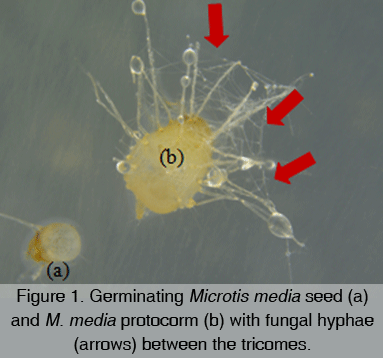
Within the orchid cells in the protocorm, hyphae form little coils called pelotons (peloton is French for "ball"). These pelotons last only a few days inside the cells, after which they break down and are digested by the orchid cells. These nutrients allow the orchid to develop. 

The fungus may be the sole source of nutrition during the first stage of the orchid's life, which may last for years in some species/conditions. Most orchid species develop chlorophyll in their adult stage and become less dependent on the mycorrhiza once they can photosynthesize.
In these cases, the fungi would begin to benefit from the relationship by receiving photosynthetic byproducts. Most of these orchids will also still have mycorrhizal associations in their roots, and continue to gain nitrogen and phosphorus from the fungus. 
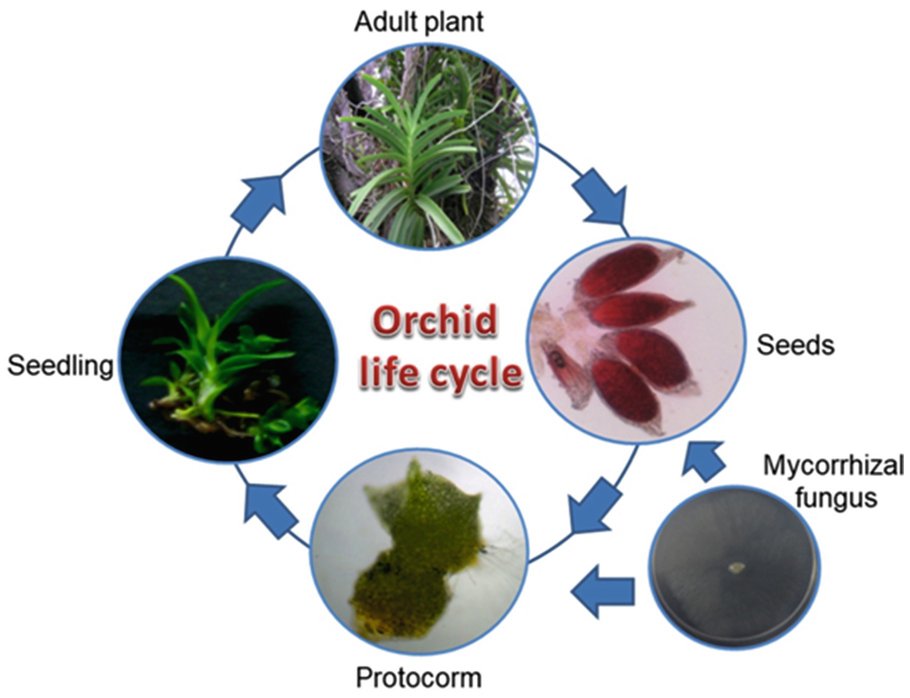
About 200 species of orchids NEVER develop chlorophyll and are always dependent on fungi for food; as far as scientists have found so far, the fungi in these relationships do not get any benefit from the orchids and are simply being parasitized for food.
forestfloornarrative.com/blog/2017/8/9/…
forestfloornarrative.com/blog/2017/8/9/…
Ringworm (also called tinea) is a skin infection so named because it generally forms a ring shape on the skin - usually a red ring, which may be either red or normal skin colour inside. From the name, you might assume it's caused by a worm, but nowadays we know it's actually ... 

... yep, you guessed it, caused by a dermatophytic ("skin-eating") fungus. In fact, there are three genera of fungi most likely to cause ringworm symptoms: Epidermophyton, Microsporum and Trichophyton; Trichophyton rubrum being the most common species.
The fungus can be transmitted directly by touching an infected person or animal, or indirectly via the ground; athlete's foot is a common dermatophyte infection which can spread on the floors and showers of locker rooms.
Like most fungi it grows best in a damp environment; so most commonly causes infections in places like between toes that may remain moist and covered.
Trichophyton infects skin because it has evolved the ability to eat keratin, an important component of the outer layers of skin.
Trichophyton infects skin because it has evolved the ability to eat keratin, an important component of the outer layers of skin.
Dermatophytic fungi land on the skin and adhere to the stratum corneum layer, then colonize the upper layers of dead skin, breaking them down for food. 

The fungus doesn't actually invade the skin very deeply; and most likely the redness and itching are caused by our own immune system reacting to the presence of the fungus, rather than something the fungus itself is causing.
Unless you're immunocompromised, the fungus will likely remain a simple passenger along for the ride and the free dead skin cell food. However, it's visually unattractive and can be itchy, so fortunately there are various antifungal compounds that will kill it off. 

(I once worked for a mycology professor who got a patch of dermatophytic fungus on his arm; unlike most of us he was so fascinated by it that he had his students take slides to examine, and treated it almost like a pet, till his wife finally rebelled and made him get rid of it.)
Well, maybe a light-hearted fungus update is the break you need today. So here's one.
In 2009, researchers described a new mushroom they found in a forest in Thailand. The mushroom was grey and oddly sponge-like, lacking the spore-producing gill structure of a normal mushroom.
In 2009, researchers described a new mushroom they found in a forest in Thailand. The mushroom was grey and oddly sponge-like, lacking the spore-producing gill structure of a normal mushroom.

It was so unlike other known mushrooms that they created a new genus for it. Because of its appearance, they named the genus Spongiforma. And since the mushroom had been discovered in Thailand, its name became Spongiforma thailandica - the one and only known member of its genus.
It's not yet known exactly how Spongiforma mushrooms disperse their spores. Since they don't produce spores in gills, they must use some other method of distributing them. They do not appear to dry up and shoot out spores like puffballs...
...and they weren't observed attracting flies with smelly, sticky substances like stinkhorns. Possibly they are more like truffles and are eaten and transported by an animal in the forest, but this isn't yet confirmed, and also doesn't explain the unusual sponge-like shape.
In 2011, researchers in Borneo found a similar sponge-like mushroom in the forest where they were researching mycorrhizae, though this one was orange, not grey. Gene sequencing showed it was related to but different from S. thailandica, and so it was placed into the same genus... 

... but it needed a new species name. After some debate, the new mushroom was named Spongiforma squarepantsii - not only getting headlines, but also doubling the downloads for the journal Mycologia in which it was published. 😂 

Researchers guess the Spongiforma mushrooms are likely mycorrhizal also, since they were found among the roots of trees. So in this case, Spongiforma squarepantsii does not, in fact, appear to live under the sea. It is, however, unarguably a fungi. 🍄🤣 mushroomthejournal.com/spongiforma-sq…
Monday morning blues? Have some blue fungus:
Blue is a rare colour in nature. Less than 10% of the 280,000 species of flowering plants produce blue flowers, and even those are actually not using a blue pigment, but rather a mix of other pigment colours and tricks of the light.
Blue is a rare colour in nature. Less than 10% of the 280,000 species of flowering plants produce blue flowers, and even those are actually not using a blue pigment, but rather a mix of other pigment colours and tricks of the light.
And there are almost no plants at all with blue-appearing leaves or stems. Most animal colouring comes from what they eat - famously, pink flamingoes are pink because of the shrimp they eat. biodiversityrevolution.wordpress.com/2019/08/20/nat…
And because there are no blue plants pigments, there are almost no blue animals. The ones that do appear blue, such as the blue jay and some butterflies, also use tricks of the light rather than actual blue pigment. The only known exception is the obrina olivewing butterfly. 

So, one modest mushroom native to the coniferous forests of New Zealand is getting a lot of attention recently. Entoloma hochstetteri, known to the Maoris of New Zealand as the Werewere-kokado, is a small mushroom with a cap up to 4cm in diameter. LOOK AT THIS THING! 💕 


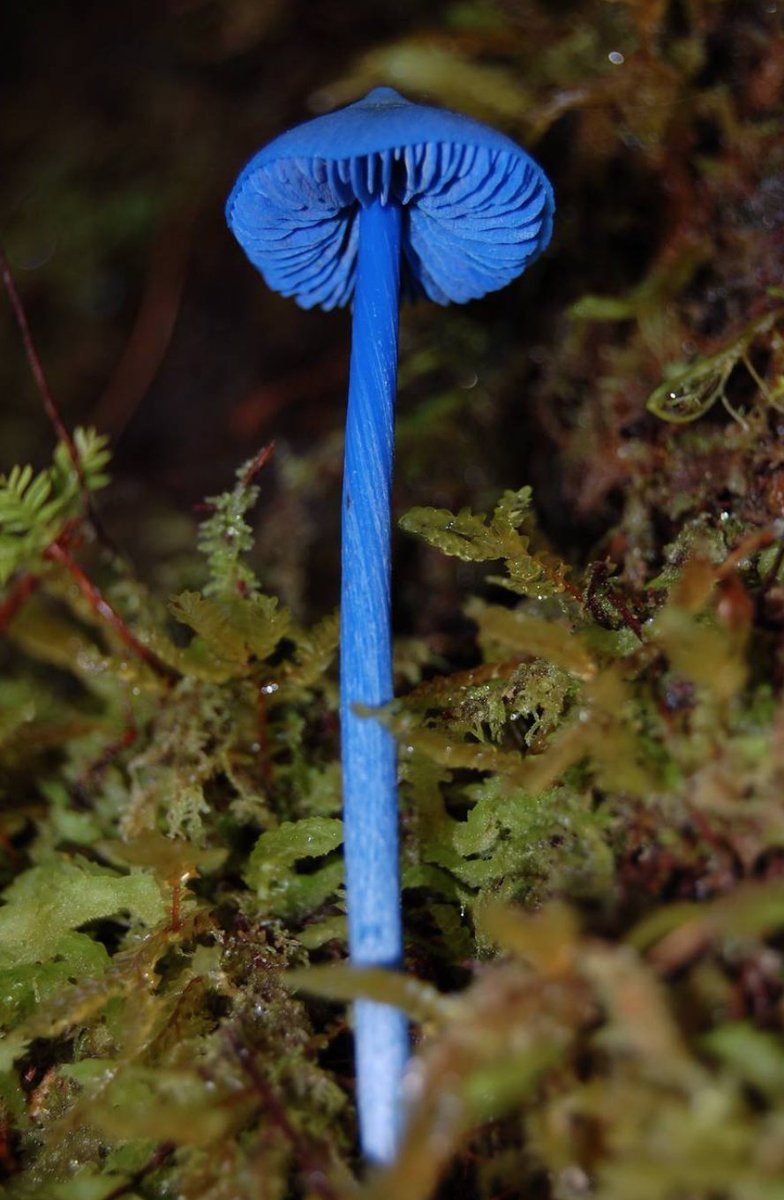

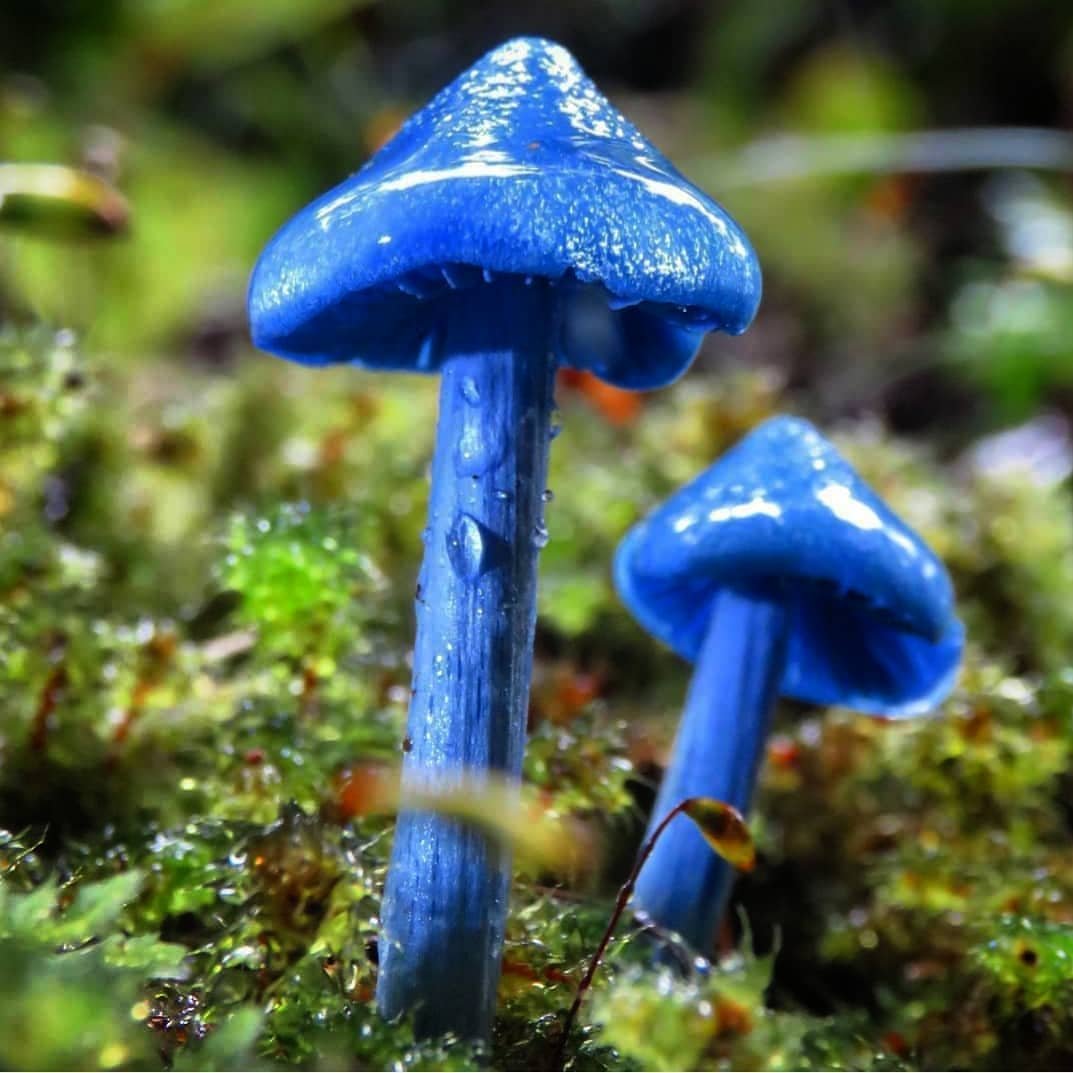
The mushroom produces natural blue pigments rather than tricks of the light, and it's currently attracting attention from the food industry in hopes it could be a natural source of blue food colouring, instead of the chemical compounds currently used. stuff.co.nz/national/93540…
Scientists found the pigment also turns green when exposed to oxygen, which could make it a useful tool to signal improperly sealed food packaging. There still isn't much known about this mushroom, but in the mean time you can study it on the NZ $50 bill:
forestfloornarrative.com/blog/2018/5/18…
forestfloornarrative.com/blog/2018/5/18…

Puffball is a name used to describe mushrooms that grow in a spherical shape, and puff out spores once "ripe". There are several species of fungi that form the puffball type of mushroom. Many are closely related and belong to the Lycoperdon family.
Many types of mushrooms look like small spherical eggs when young, but as they age, the mushroom opens up into the typical umbrella shape with spore-producing gills underneath. Puffballs never open up; they continue growing and may become quite large... 



...but they remain a sealed spherical shape with the spores contained inside. As the puffball ages, the inside slowly dries out until the puffball is essentially an empty sack filled with dry spores. It may either start to split or may develop an opening (depending on species)... 

... and the slightest touch or drop of rain is enough to send a cloud of spores out through the opening and into the air, where they will travel on the wind to a new location.
The largest known puffball is the Giant Puffball, Calvatia gigantia, which forms a large white ball shape up to 66.5 inches (nearly 170 cm) in diameter. The average giant puffball can produce about 7 trillion spores; fortunately almost none of these survive to grow new puffballs! 

Most species that form puffballs are saprophytic (they eat decaying wood). Puffballs are edible, and many are considered delicious, as long as eaten when still young and pure white all through. Once they start to darken and dry out inside to form spores, they shouldn't be eaten. 

And in case you were wondering, "Calvatia gigantia" roughly translates to "giant bald head", while the family name "Lycoperdon" means "wolf farts". Which probably tells you all you need to know about mycologist humour. 🤣
wildfooduk.com/articles/the-p…
wildfooduk.com/articles/the-p…
Following up on yesterday's topic...
Lycoperdonosis is the term for a respiratory disease caused by inhaling the spores from puffballs, many of which are in the Lycoperdon family. This causes inflamation of the lung tissue leading to cough, fatigue, and pneumonia-like symptoms.
Lycoperdonosis is the term for a respiratory disease caused by inhaling the spores from puffballs, many of which are in the Lycoperdon family. This causes inflamation of the lung tissue leading to cough, fatigue, and pneumonia-like symptoms.
It is theoretically possible the spores could germinate in the moist environment of the lungs, causing further damage and requiring antifungal treatment to clear up. In 1967 a group of teenagers at a party deliberately inhaled large amounts of puffball spores, hoping to get high. 

Puffball spores are not hallucinogenic however; and what they actually got was hospitalization for four weeks.
Folks ... do NOT inhale random stuff. Especially random stuff that may GROW in there. 🤦♀️
Folks ... do NOT inhale random stuff. Especially random stuff that may GROW in there. 🤦♀️
While humans need to inhale a fairly large number of spores to cause illness, there have also been cases of dogs accidentally inhaling puffball spores if they are digging where mature puffballs are growing, and causing death in rare cases. 😢
Friday fungi!
"Jelly fungi" is a term used to describe fungi that produce mushrooms with a gelatinous appearance and texture. They aren't necessarily closely related, but mostly fall into one of three larger groups: AURICULARIALES, the DACRYMYCETALES and the TREMELLALES.
"Jelly fungi" is a term used to describe fungi that produce mushrooms with a gelatinous appearance and texture. They aren't necessarily closely related, but mostly fall into one of three larger groups: AURICULARIALES, the DACRYMYCETALES and the TREMELLALES.

The first two groups are generally found on decaying wood, but the tremellales fungi tend to be parasites of other fungi. Which means they may still appear to be found on decaying wood, but actually they are found on other fungi on decaying wood.
They're called "jelly fungi" because they don't have the firm texture and specialized structure of most mushrooms. Instead they form a mass of fairly undifferentiated tissue that's capable of drying out and rehydrating. It looks gelatinous, but has a crunchy texture when eaten.
One of the best known examples of this is the "wood ear" mushroom, Auricularia auricula, which is common in Chinese food dishes. (You often see this in Hot Pot.) This and many others of the jelly fungi are edible but not particularly tasty and used more for texture than flavour. 

Dacrymyces palmatus aka "Witches butter" is another very recognizable example. Also fairly flavourless, it can be used for texture. There are legends about its presence indicating that a household had been cursed by witches; the curse could be broken when the fungus was removed. 

Tremella fuciformis, or "snow fungus", is also used in Chinese cooking, often as a dessert with a sweet syrup. Again, fairly tasteless on its own, but a nice crunchy texture. 

This website includes a story of a mycological society dinner at which this fungus was served, upon which the guests started examining the mushroom with hand lenses, worrying the management. In other words, a fairly normal dinner with mycologists. 😂
website.nbm-mnb.ca/mycologywebpag…
website.nbm-mnb.ca/mycologywebpag…
Like big brains? Tremella encephala, commonly known as Conifer Brain, is found in coniferous forests. It looks like a small pink brain, and has the gelatinous appearance of a jelly fungus. However, if you cut the "brain" in half, you'll find the inside is firm and white. 

Although this fungus was first described in 1801, it wasn't until 1961 that a researcher called Robert Bandoni realized the "conifer brain" is actually not one, but two separate species. 

Stereum sanguinolentum is a parasitic mushroom that grows on conifers all over the world. It normally looks like a leathery crust on the wood surface, but if injured, it "bleeds" a red colour, which have given it common names such as "bleeding conifer crust". Lovely... 😛 

Anyway, it turns out that Tremella encephala is a type of jelly fungus that is parasitic on the parasite; it grows in S. sanguinolentum, enveloping it entirely, and forming the "brain" shape with T. encephala on the outside, and the "victim" fungus S. sanguinolentum inside. 

As far as I could see, T. encephala has not been found growing anywhere except as a parasite of S. sanguinolentum growing on trees. Which possibly means, when the zombie apocalypse arrives, go hide in a conifer forest? 🤔
North America has long been seen by outsiders as a land of opportunities for immigrants, with plentiful resources, opportunities, and room to spread out. And around 1930, a new immigrant arrived in Cleveland, Ohio. The immigrant was called Scolytus scolytus... 

... it was a small beetle that likes to lay its eggs in galleries it carves out under the bark of elm trees. A shipment of unpeeled logs from Europe brought these uninvited visitors, and they immediately made themselves at home in the American elm trees lining the streets. 

The beetles cause only minor damage burrowing under the tree bark, but the beetles didn't travel alone from Europe. They ALSO brought along a fungus called Ophiostoma ulmi, O. ulmi is probably originally from the Himalayas, where it has a long history parasitizing Asian elm trees 

...which have learned to tolerate it over many centuries of co-evolution. During World War I, however, O. ulmi was transported to Europe and found a whole new population of European elms that had no defenses against it.
Throughout the 1910s and 1920s this disease spread throughout most of Europe, spreading mainnly via the Scolytus scolytus beetle and damaging elm trees across the continent until it was eventually identified in the Netherlands, thereby acquiring the name Dutch Elm Disease. 

So what is the fungus actually doing to the elm trees? Elm beetles lay their eggs under the bark of dead or dying elm trees, and the fungus creates spores in those burrows. When the beetles fly to healthy elm trees to feed on fresh buds and branches, they bring the spores along. 

The fungus enters the elm trees from the young branches at the top where the beetles feed, and enters the feeding wounds created by the beetle and into the xylem of the tree - these are the "blood vessels" that carry water throughout the tree. 

Not only does the fungal tissue cause blockages in the xylem, but the tree's defense systems also react by creating a gum-like substance to try and prevent the fungal spread, which also blocks up the xylem even further.
As a result, water is unable to reach the upper parts of the trees, causing the elms to wither and die from the top down. A characteristic sign of Dutch Elm disease is dark, blocked xylem channels visible when the tree is cut down. 

When it arrived in North America, O. ulmi spread rapidly and proved more damaging to American elms than European ones. Initially, the disease was quarantined and strict control measures prevented it from spreading, but during WWII those controls were relaxed and it spread. 

The spread across the continent reached a peak in the 1970s. Of the estimated 77 million elms in North America in 1930, over 75% were dead by 1989. If you're younger than about 40, you may never have seen an adult elm tree on this continent. 😢
But DID YOU KNOW! Edmonton, Alberta #YEG has one of the largest populations of healthy elms left in the world; partly because the cool weather is less friendly for the elm beetles, partly because elms are not native to Edmonton so the beetles aren't able to spread here naturally
... also because of extremely strict provincial regulations to prevent infection. It's illegal in Alberta to store, transport, or sell elm firewood, and there are strict regulations that elm trees can only be pruned in winter when beetles are not active.
dutchelmdisease.ca/history/
dutchelmdisease.ca/history/

So... plants don't have immune systems in the same way animals do, but they are able to detect the presence of foreign pathogens and trigger a number of defense-related responses. These may include physical barriers, chemical defenses to slow invaders, even controlled cell death!
Various chemicals have been tried for controlling the beetles or fungus, and in the Netherlands, which have very strict regulations forbidding the use of chemicals in public areas, scientists have experimented with the use of another fungus to create a "vaccine" for elm trees. 

Scientists took a common soil fungus, Verticillium albo-atrum, that also infects crop plants causing wilt by growing through their xylem (vascular tissue). They found a very weak strain of this fungus that doesn't cause significant damage, and injected a solution of its spores... 



...into healthy elm trees. This appears to significantly increases the elm's ability to resist later infection by Dutch elm disease. In trials conducted in Denver, the losses of elm trees decreased from 7% per year to about 0.5%. 🥳
It's not believed the Verticillium fungus interacts with the Dutch elm fungus; but its presence appears to stimulate the elm trees to detect a pathogen and activate defenses, so that when the Dutch elm fungus attempts to attack later it finds the trees much harder to invade.
This is not a vaccine in the human sense, as trees do not create antibodies the way we do, and the treatment also needs to be reapplied every year to re-stimulate the elm's defenses and protect the new tissue grown each year.
However, it's a promising demonstration of completely non-toxic biological control of a disease as well as an illustration of how one fungal disease can be used to defend trees against a second, worse one. 😊
web.archive.org/web/2010111718…
web.archive.org/web/2010111718…
You might think these search results are from a coral reef but they're actually not. These are not aquatic at all, they're actually fungi. Often called coral fungi or clavarioid fungi, these produce mushrooms that are usually shaped like coral, or sometimes forks, worms or clubs. 

They're not necessarily closely related; there are different groups of fungi (such as Clavulinopsis, Clavulicorona and Ramaria) that all tend to share this appearance. Depending on the species they're often either mycorrhizal (symbiotic w/ trees) or saprophytic (eating wood).
So those are "coral fungi", so called because they look like little coral structures although they are actually mushrooms. Just to be extra confusing, there's also a group of organisms called "coral mushrooms" which are actually neither mushrooms nor coral.
Most corals are made up of colonies of hundreds or thousands of tiny invertebrate creatures called polyps. These are soft-bodied creatures that secrete a substance like limestone (calcium carbonate) that attaches to rocks or other coral structures that build up over time 

Many coral structures also contain algae, simple plant-like organisms that can photosynthesize. The algae are protected by the coral's hard tissue, and recycle its waste products while producing oxygen and photosynthesizing food that is shared with the polyps: a symbiosis.
Mushroom corals are not corals either. They're actually salt water cnidarians very similar to sea anenomes, but they're called mushroom corals simply because they grow in a shape that looks similar to a mushroom, and are often found associated with coral reefs. 

"Mushroom corals" are relatively hardy, colourful, and conveniently sized for an aquarium, but they are in no way closely related related to fungi either. animal-world.com/aquarium-coral…
So to sum up:
Coral fungi = mushrooms but not coral
Coral mushrooms = neither mushrooms nor coral
So to sum up:
Coral fungi = mushrooms but not coral
Coral mushrooms = neither mushrooms nor coral
Fairy rings, also sometimes known as elf circles, witch's circles, or pixie rings, are a circle of mushrooms or abnormal grass growth. While there are some different types of fairy ring, they're all caused by the same agent, which is of course, you guessed it: fungus. 🥳🍄 

A fairy ring begins when a fungus starts growing in (or more likely under) the soil. There are 50-60 species that can form fairy rings (Marasmius oreades, Agaricus campestris are two common ones), most of which decompose organic waste in the soil, such as bits of wood and leaves.
The fungus grows its mycelium outwards (the rootlike threads that spread under the soil) as it consumes the food in the centre. When all the food at the original starting point has been exhausted, the mycelium grows outwards looking for more, forming an ever-expanding circle. 

A few different things may happen on top of the ground as the fungal mycelium grows underground; these will depend on the species of fungus, as well as other factors that may include the weather and the type of soil/environment.
First, some species of fungus grow very dense mycelium, to the extent that it actually prevents water from getting past. This results in the grass above the fungus dying due to lack of water. In this case, a circle or ring of dead grass may appear in the grass above. 

Second, some species of fungus exude chemicals, and/or release extra nitrogen from breaking down the wood debris in the soil, that actually stimulates the growth of grass. So, around the growing edge of the expanding mycelial ring, the grass above may be HEALTHIER than elsewhere. 

And third, if the weather conditions are right, the fungus may grow actual mushrooms (essentially the "fruits" of the fungus). Mushrooms can grow extremely rapidly when conditions are right and so a mushroom ring can appear literally overnight, which can seem like magic! 

Probably due to the "magic" appearance of mushroom rings, there's folklore around the mushroom rings in almost every country they're found. They're said to be the site where witches, elves, or fairies dance in circles; or the circle made by the Devil setting down his milk churn.
There are also warnings in folklore against stepping into one or walking the wrong way around them. And while most rings are relatively small, a ring near Belfort, France (produced by Infundibulicybe geotropa) is a quarter mile in diameter and thought to be over 700 years old. 

Mushrooms, as you will recall (RIGHT?), are just the fruiting body of a fungus; like an apple produced by an apple tree, if the entire tree grew underground. The mushroom produces spores, which fall from the mushroom to be spread by the wind to other habitats. 

However, many mushrooms grow in sheltered areas, such as on forest floors or among fallen logs. There's little wind here to spread the spores for most of the time. Until recently, humans have assumed that mushrooms were just passively dropping their spores in hopes they'd spread. 

In 2013 we discovered that's not the case! Mushrooms contain a lot of water; that's one reason they tend to grow so big so quickly after a rain. By releasing some of that water into the area underneath them, they're able to control the microclimate around the mushroom.
Releasing water creates a humid area, which evaporates and cools. The spores from the mushroom are drawn down into this cooler, heavier air; then reach the edge and are lifted up into the warmer air currents to be carried away from the mushroom! Video:
Essentially, the mushrooms are controlling their own weather, varying the temperature and humidity near them and using this to create their own wind to disperse their spores. 

In Terry Pratchett's Discworld series, he writes about the Quantum Weather Butterfly, which can "create weather" simply by flapping its wings. Perhaps Sir Terry should actually have been writing about Quantum Weather Mushrooms, instead! 🤣 wiki.lspace.org/mediawiki/Quan… 

A contender for the mushroom with the friendliest sounding name is "Big Laughing Gym", Gymnopilus junonius, sometimes also known as Spectacular Rustgill. It's a thick, fleshy mushroom the colour of a pumpkin that tends to grow in clusters on wood. 

It's extremely bitter but not poisonous, and mainly interesting because it produces low levels of hallucinogenic psilocybin compounds. Its name comes from stories of the hallucinations; supposedly one woman who'd eaten several of the mushrooms said "I'm dying, and it's hilarious" 

However, this mushroom is difficult to reliably identify, and is easily mistaken for some similar-looking poisonous species, so it's NOT a good idea to try and find these for recreational purposes, especially since the levels of the hallucinogen are reported to be pretty low. 

The potato originated in South America and was cultivated around 5000BC by the Incas of Peru. When the Spanish arrived in 1536, they brought the potato back with them to Europe. Today the potato, Solanum tuberosum, is the world’s 4th largest food crop (after rice, wheat, maize). 

Unfortunately, transplanting the potato to Europe where it was not a native had two unanticipated effects, First, when the potato traveled to Europe, it left behind the pathogens that it had evolved with over the many thousands of years.
And second, populating all of Europe and then North America from the descendants of a small number of potatoes brought over by the Conquistadors resulted in a very low genetic diversity in the population of crop potatoes. They were all very closely related, and all very similar. 

As a result, when some of the potato pathogens from South or Central America (there are a few theories) also finally made the trip across the world to Europe, they found a large population of potatoes that were completely unused to pathogens, and all susceptible in similar ways.
Historical evidence shows that the disease initially moved from South to North America in early 1843, and then hitched a ride, many think with a shipment of seed potatoes destined for Belgium in 1845. 

Late potato blight is caused by an oomycete called Phytopthora infestans. The Oomycetes were originally thought to be a type of fungus, but are now considered to be something different, although very fungus-like. They are known as water molds. 

Like fungus they do grow a mycelium and produce spores, though the spores are actually motile: they swim using a little flagellum. For the purposes of these fungus facts however we're going to talk about them anyway, since they caused the most devastating crop disease in history! 



When P. infestans arrived in Europe, it found fields and fields of defenseless potatoes, and an ideal climate for spreading. P. infestans does best in cool, humid conditions, so a cool and rainy summer is perfect for its spread.
It primarily attacks potatoes and other closely related solanaceous plants such as tomato and other nightshades. A spore landing on a wet leaf swims over the surface of the leaf into an opening, where it grows into the tissue. A dark lesion forms after only 2-3 days... 

The lesion produces new spores that carry via wind to other plants, or are washed by rain down into the soil where they can infect the developing tubers (the potatoes). One single lesion can produce 100,000 to 300,000 new sporangia (spore-producing structure). 

As a result, a single infection can spread across an entire crop extremely rapidly. The infection of the foliage causes lesions in the leaves followed by collapse and decay; infection of the tubers causes dark patches of discoloration and dry rot. 

In winter, it normally survives in tubers left in the field, in waste piles and in storage. In the spring, this surviving mycelium produces sporangia which are spread by wind and rain to infect new healthy plants and crops. quickcrop.ie/blog/2013/09/p…
In 1845, P. infestans had arrived in Ireland, and weather conditions were favourable for it to make a rapid spread across the country. While all potato crops in Europe suffered, Ireland was VERY heavily reliant on potatoes to feed its population.
By 1952, it's estimated that 1 million Irish had died of famine, and another 1-2 million were forced to leave Ireland to find food. The population of Ireland at the time was barely over 8 million; the population STILL hasn't recovered to that level again.
history.com/topics/immigra…
history.com/topics/immigra…

Copper based treatments were later found to provide some protection, but these have to be reapplied regularly, and copper in the soil is bad for earthworms and other beneficial organisms. Nonetheless, this allowed some countries in Europe to keep the disease under better control.
That is until WWI. During the war, supplies of copper were diverted to the war effort instead, so an outbreak of potato blight in Germany resulted in the deaths of an estimated 700,000 civilians due to starvation, and is thought to have been a factor in Germany's early surrender.
France, Canada, the United States, and the Soviet Union researched P. infestans as a biological weapon in the 1940s and 1950s. 😞 The difficulty of limiting the spread of a biological disease like this would make it a very difficult weapon to control. link.springer.com/article/10.100…
If you hang out with mushroom-hunters (and really, why wouldn't you?) then you may have heard the word "polypore" used to describe certain types of fungus. Polypore is a general term for the type of fungus that typically grows on wood, is almost as hard and as inedible as wood... 

...and may last for years, and does not form a typical mushroom shape; and instead of gills, they have a porous structure. Most polypores are wood rotting fungus, and generally specialize in particular species of trees. However, a few are mutually beneficial mycorrhizae. 



Although polypores are generally inedible, they have had various other uses throughout history, including being used as dyes and medicine. Because they consume wood, many of these fungi excel at breaking down the lignin that makes tree cells hard and indigestible. 

This makes them VERRRRYYY interesting to the paper industry, which currently relies on ecologically unfriendly chemical bleaches to break down lignin in the paper-making process. 

Some species of polypores have also shown they can decompose toxic wastes such as PCBs and PCPs, which could lead to their use in environmental cleanup efforts if a way can be found to scale up their efforts. 🙂 yesmagazine.org/environment/20…
As mentioned previously, fungi cannot photosynthesize to create their own food, so they're under a lot of evolutionary pressure to find other sources of food. Among other things, this has led to various species of fungi becoming very specialized ...
https://twitter.com/pentapod/status/1246504085790040066?s=20
... some of them finding ways to eat food sources that are otherwise undesirable for other competitors to fight for - from moose hooves to radiation.
https://twitter.com/pentapod/status/1254991650365063168?s=20
And if, as a normal human being, you try to think of "things nothing would want to eat" and come to the answer "cockroaches", you'd also be correct. Or at least, you'd be correct that fungi have learned to eat cockroaches. 




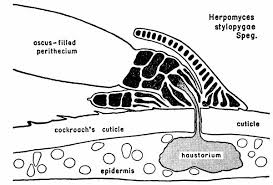
Although fungi may not be the only thing to try it, there is in fact an entire genus called Herpomyces that specializes in eating cockroaches and has not been found anywhere else; as far as scientists have been able to determine, these are "obligate parasites" of cockroaches. 

"Obligate parasite" is a term that means the parasite cannot survive without the host. There are about 25 known species in the Herpomyces genus, and they have been found on almost every continent (except Antarctica). schal-lab.cals.ncsu.edu/files/2018/10/…
A lighter fungal infection does not appear to kill the cockroaches or even severely affect their behaviour in most cases; however very heavy infections may cause the insects to move more slowly or even die. One study examined cockroaches around the Harvard university campus ...
...and found that as many as 98% of cockroaches they trapped had a fungal infection by some species of Herpomyces. 98%!!
Interested scientists like this guy also confirm it's common: 🤣
Interested scientists like this guy also confirm it's common: 🤣
https://twitter.com/dhaelewa/status/1122929179144667139
Moist conditions and crowding of cockroaches appear to spread the infection. Some studies suggest that these parasitic fungi are also being spread globally through the international pet trade. amazon.com/Zoo-Med-Can-O-…
As long as they remain parasitic on only cockroaches this is probably not immediate cause for concern, but if the fungus found another beneficial local insect it can also parasitize it could cause serious environmental impact. 🤔
Anyway, tl;dr: let's be glad that as the top of our food chain we have a lot of other options to consider before trying to specialize in cockroaches! 😂
The simplest type of broom is made by tying a bundle of smaller sticks onto a larger broomstick to form what's usually called a "besom" broom. These were often made of birch twigs and are what is traditionally pictured around Halloween as a witch’s broom. 

Sometimes trees form abnormal, dense clusters of twigs while growing, which are also called Witches' Brooms. According to some folklore, these appear when witches' brooms get caught in the trees. While Witches' Broom is a name common in North America... 

...in England, the disease may be called thunder-bushes or bull-boughs. The Germans call it Hexenbesen, and the French call it Balai du Sorciere. Despite the different terms, the etymology of most of these suggests the growths have a supernatural or magical cause. 

This is caused by a disease, which may be several things including parasitic plants (like mistletoe), insects, bacteria, and (of course) fungi. It can also be a genetic mutation, affecting any offspring the tree produces; that's how some varieties of dwarf trees are produced. 

In cherry trees, Witches Broom is very common in Europe, affecting both sweet and sour cherries. It's less damaging in North America. This is a fungus is known as Taphrina cerasi, and airborne spores probably infect the cherry trees via new leaf buds, which are more defenseless. 

The fungus invades the twigs and leaves. The leaves curl up; in the twigs the fungus produces phytohormones (probably cytokinin) which stimulates growth in the tree's cells. Instead of producing buds at the tip, abnormal twigs develop, forming a thick bundle of broom-like twigs. 
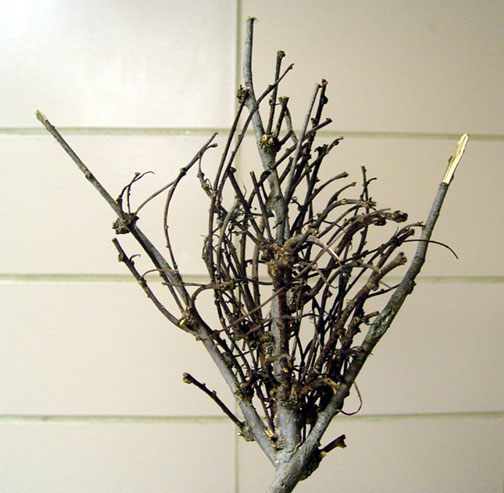
Different species of fungus infect other species of trees; for example, witches’ brooms seen on birch trees are likely caused by a fungus called Taphrina betulina, but the cause of the abnormal growth is generally similar regardless of what the cause is.
These growths do not usually kill the tree, but may cause damage depending on what the tree is used for; infected areas of the tree will not produce flowers or seeds, for example, and would not produce usable lumber.
PS: Based just on the image we've seen, it sure looks as if "sexy romance tree" from the EAPlay trailer might be infected with one of these fungi or similar diseases causing a phytohormone imbalance! 😄 

So far 2020 has included fires, floods, plague, riots, murder hornets, and this month the eastern United States is also welcoming the visitation of giant red-eyed cicadas that occurs every 17 years. 😮
Over a million insects may appear per acre of land, with up to 3 inch wing spans, and making noise as loud as a lawnmower (90 decibels) as they cover the land in search of a mate. popularmechanics.com/science/animal…
Considering they only get to mate every 17 years, this should theoretically be a happy time for the cicadas, but unfortunately for them, there's a fungus awaiting their arrival also. As the cicadas wait underground in the soil, so does the fungus Massospora cicadina. 

As the cicada nymphs emerge above ground, the fungus spores in the soil attach to about 5% of them. M. cicadina grows into the cicada's tissue as it matures into an adult, entering the abdomen and growing a mass of whitish spores inside it. 

The cicada proceeds on its quest for love, mating with other cicadas. Unfortunately, by this time M. cicadina has rendered the cicada sterile, literally replacing its genitals, so all that happens is that the cicada's partner is now infected by the fungus also. 

The cicada's abdomen may be so full of spores at this point that the hind segments of its abdomen may actually FALL OFF - which still doesn't even stop it from continuing to try and mate, and spreading the infection. 

If that's not bad enough, M. cicadina also affects cicadas' behaviour. Infected males are forced to make wing-flick motions that fool other males into thinking they're females, and attempting to mate, spreading the infection further since the only thing left down there is spores. 

Cicadas that are infected through the sexual transmission, rather than when they emerged from the soil, additionally produce "resting spores" that fall to the earth and are designed to wait there in the soil until the cicadas' next 17 year emergence... ready to reinfect.
Scientists studying the infected cicadas discovered they contained psilocybin, a hallucinogen, and cathinone, an amphetamine, which may explain why the cicadas don't notice their abdomens and genitals have fallen off.
These are produced at fairly low levels, so the amount required to make a human high would take at least 12 cicadas. Hopefully it's not necessary to say, DO NOT eat the abdomen-less zombie cicadas to try to get high. SRSLY. 🤮fungusfactfriday.com/221-massospora…
Favolaschia calocera is a bright orange mushroom with an unusual porous structure that was first discovered around 1933, and named in 1966. Its name, calocera, means "beautiful and waxy", from the prefix Calo meaning beautiful, and -cera from ancient Greek meaning "like wax". 

It's a wood rot fungus found in Madagascar, where it will attack both living and dead wood. More recently, it's been discovered in New Zealand, Australia, Europe, an North America where it appears to be an invasive species, probably having traveled there in shipments of wood. 

Presumably where it occurs in these countries it has displaced some other native fungus, which may end up causing problems to the ecosystem in the future.
It is not considered edible, although it's also not clear if it's poisonous.
It is not considered edible, although it's also not clear if it's poisonous.
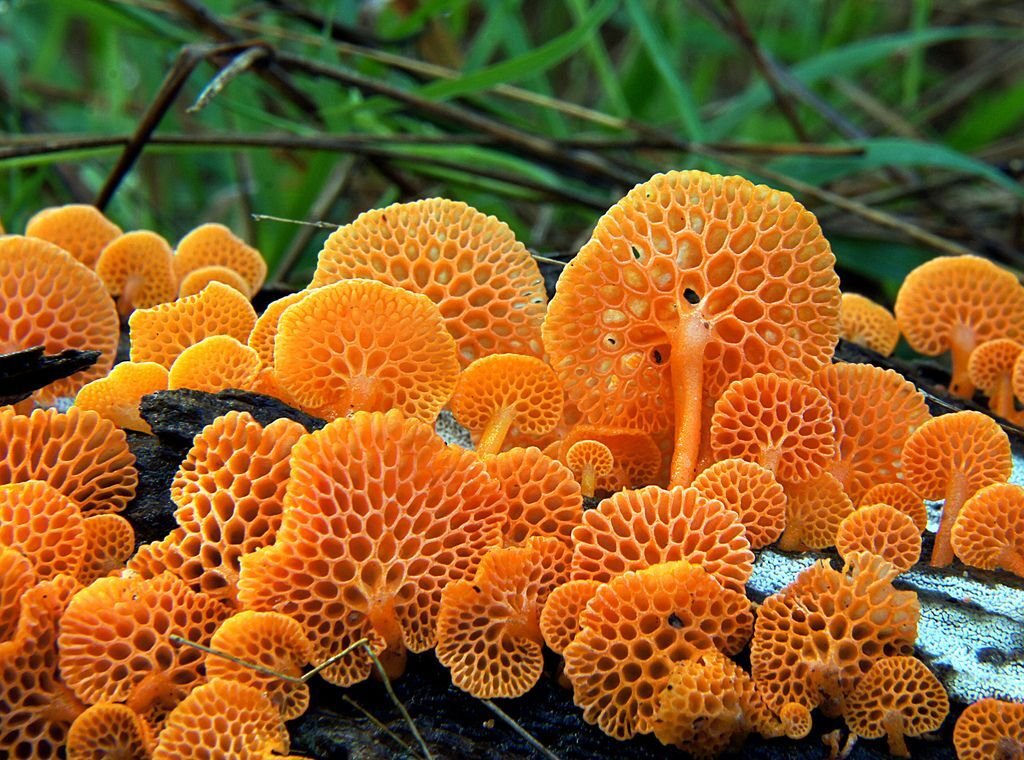
It's sometimes called the Orange Pore Fungus, although there's also one scientific article about its global spread called "Invasion of the Orange Ping-Pong Bats". 🤣 sciencedirect.com/sdfe/pdf/downl…
Part of its success in spreading may be due to its ability to produce several types of antibiotics, which could make it a useful fungus to study for its medicinal potential. 🙂 

Back to fungi facts after a week off work! And this week will be about nematophagous fungi ... which means, fungi that eat nematodes. Of which there are many! But first, you may be asking yourself, "Self, what exactly is a nematode?" so hang on, I got you ...
Nematodes are tiny multicellular insects with smooth, unsegmented bodies that resemble microscopic worms, although not actually related to true worms. "Nematode" is a general term for any worm of the phylum Nematoda, and they're among the most abundant animals on Earth. 

In university I had a professor who swore that if we could invent a ray gun that would disintegrate all matter EXCEPT nematodes, we would be left with an exact shape of every single thing on earth (including ourselves), made entirely out of nematodes. 🪱😱🪱 

There are over 20,000 known species and probably far more not yet identified; they can be both parasitic and beneficial, and are found in plants, animals, soil, water, pretty much anywhere life can exist. Which, from the point of view of fungus, makes them a very promising lunch!
Since fungi often hang out in the soil, the nematodes that also inhabit the soil are an obvious target. Nematodes secrete chemicals as they move through the soil, and in particular they (and nothing else!) produce a highly specialized family of small molecules called ascarosides.
This means that fungi which learn to detect the presence of ascaroside molecules in the soil have the advantage of knowing when nematodes are nearby, and different species of fungi have evolved to take advantage of this in different ways.
So, if you were a fungus hanging out somewhere in the Wild West and looking to catch some nematode food on the run, what would you do? Maybe you'd go full-on cowboy and throw a lassoo over a passing nematode. Maybe you'd make a net or some other sticky trap to catch your prey.
Maybe you'd try poison. Maybe you'd just lie in wait and jump 'em. Guess what? Different species of fungus do all these things, and the rest of the week will describe each type. 😊 For today, the first type is the hyphal ring users, aka the lassoo cowboys of the fungus world.
These fungi produces hyphae (thin thread-like strands of fungal mycelium) that end in an open constricting loop. When a nematode swims through, the loop suddenly fills with water. This causes the diameter of the inside of the loop to narrow and in turn constricts around the prey. 

Within 24 hours of catching the nematode, more hyphae will grow from within the loop and penetrate the nematode, beginning the process of digesting it. Notable fungi that use a hyphal ring include Drechslerella anchonia, Drechslerella dactyloides, and Drechslerella brochopaga. 🤠 

And now for part 2, nematophagous fungi that use sticky traps to catch their dinner!
The species who use this trick grow their hyphae into knob or net shapes which produce an adhesive substance. A nematode trying to swim through soil with these structures gets stuck in them.
The species who use this trick grow their hyphae into knob or net shapes which produce an adhesive substance. A nematode trying to swim through soil with these structures gets stuck in them.
The fungi then grow more hyphae to penetrate the trapped nematode and digest it (close-ups). The adhesive hyphae don't stick to surrounding material, only the nematode; so there's something in the chemistry between the hyphae and nematode which ensures rapid bonding on contact. 

Some fungi construct trap-like structures in advance, whereas a few others wait until the nematodes are detected. e.g. Arthrobotrys oligospora, which also eats rotting wood, can swiftly grow an adhesive net-like structure to trap nematodes if no other food is available... 

...however, if there is plenty of other food available or no nematodes are detected, A. oligospora saves energy by not building these structures. Efficient!
Fungi that use adhesive hyphae include Dactylellina candida, Drechmeria coniospora, and Arthrobotrys oligospora.
Fungi that use adhesive hyphae include Dactylellina candida, Drechmeria coniospora, and Arthrobotrys oligospora.
Part 3, the poisoners!
Another way to stop your lunch from escaping is to use poison to slow or paralyze it.
This is often combined with another method to slow down the nematode - such as a hyphal ring or an adhesive net...
Another way to stop your lunch from escaping is to use poison to slow or paralyze it.
This is often combined with another method to slow down the nematode - such as a hyphal ring or an adhesive net...
... but in this case the fungus also produces a toxin that paralyzes or kills the nematodes (aka: a nematotoxin) to ensure they will not escape the ring or net before they can be digested.
Interestingly, this includes the delicious oyster mushroom Pleurotus ostreatus, which normally just eats decaying wood, but can obtain extra nitrogen by eating nematodes in addition to its normal diet. 

The image below shows a nematode that has been paralyzed by the nematotoxin ostreatin, which is produced by special structures on the hyphae of oyster mushrooms. The paralyzed nematode can now be eaten at leisure. 

Notable nematotoxin users include Coprinus comatus, Stropharia rugosoannulata, Arthrobotrys dactyloides, and the Pleurotaceae family.
Oyster mushrooms: secretly carnivores.
Oyster mushrooms: secretly carnivores.
And finally, the parasites!
Another tactic fungi can use to catch nematodes is to become a specialized parasite. Some of these fungi may not even grow in the soil any more but may have become an obligate parasite of nematodes; ie, can't complete their life cycle without them.
Another tactic fungi can use to catch nematodes is to become a specialized parasite. Some of these fungi may not even grow in the soil any more but may have become an obligate parasite of nematodes; ie, can't complete their life cycle without them.
In these examples, the fungal spores lie in wait in the soil, mostly dormant until they detect the chemicals that signal a nematode is near. Some of these spores have simple flagella, so they can "swim" towards the nematode - at which point they attach themselves to the nematode. 

Other types of spore may actually be swallowed by the nematode and germinate inside it. Either way, the fungus grows throughout the nematode's body, potentially spreading to other nematodes it comes into contact with, and also producing more spores to shed in the soil around it.
While the fungi may not kill the nematode outright, or at least not immediately, it will be weakening and slowly starving its host by absorbing the nutrients that would otherwise be used by the nematode.
Fungi that survive as spores in the soil until the time is right, and then parasitize nematodes, include Drechmeria coniospora, Pythium caudatum, and Harposporium leptospira.
Finally, quite a few fungi combine two or more of the above approaches, such as Nematoctonus (literally "nematode-murderer"), which initially traps a nematode in an adhesive net but then parasitizes the nematode, growing into its body where it produces spores. 

Probably you've never wondered what the Eye of Sauron would look like if it were a mushroom, but nonetheless, the answer is Laternea pusilla (photo by flickr.com/photos/costari…) 

Laternea pusilla is a fungus in Phallaceae family, the same family commonly known as stinkhorns, including a couple mentioned previously in this thread, Phallus impudicus and Clathrus archeri.
https://twitter.com/pentapod/status/1252581628708294656?s=20
https://twitter.com/pentapod/status/1258821392742658048?s=20
Like these relatives, Laternea pusilla produces a sticky mass of spores that smell like carrion in order to attract flies. The flies land, the smelly spores stick to them, and are then carried elsewhere to start afresh. 

L. pusilla appears to be a saprophytic fungus (it eats dead wood), and is found in the rain forests of central America. As such, it's not one you're likely to see often. Despite its slightly unnerving resemblance to the Eye of Sauron it is actually only about 6 inches high. 

Fungi in the Taphrinia genus are obligate parasites: ie, they cannot survive without the host they parasitize. Taphrina robinsoniana is one of these; it specializes in attacking speckled and smooth alder trees (Alnus rugosa and A. serrulata).
The fungus attacks the cone-like young catkins (the cone-like structures that protect the growing flowers) and releases phytohormones that cause unusual and uncontrolled growth in the infected scales of the catkin.
A normal (uninfected) young alder catkin looks like this:
A normal (uninfected) young alder catkin looks like this:

Affected scales swell and grow long. Initially they are green like the catkin but as they age they often change to a reddish colour, resembling long red tongues which then produce infectious spores to continue the cycle of infection. 

Because of the appearance of the infected catkins, the disease is often called "alder tongue" or "alder tongue gall". Several other species of Taphrinia cause similar diseases on other hosts. 😛😝 

Aleuria aurantia is a very recognizable looking fungus you may see in the summer and fall in North America. It's also called the "Orange Peel Fungus" because it looks like discarded orange peels: 

It's bright orange and usually cup-shaped, with a whitish underside when young, darkening as it ages. It doesn't have a stem like many more "traditional" mushrooms, but lies flat against the surface it's growing on, and the spores are released from the top surface. 

The Orange Peel Fungus grows up to about the size of an orange, making its resemblance to discarded orange peel even closer. It's believed to be saprophytic, eating decaying plant matter, and is often found in disturbed soil rich in clay and gravel such as beside hiking trails. 

It is edible but apparently brittle and tasteless so not considered worth picking except for novelty value and colour. There are other related Aleuria mushroom species that also form similar shapes but are poisonous; however they aren't as brightly coloured. 

There is also a mushroom originally called Aleuria fuckel which is similarly orange and cup-shaped but has a small stem; this is now thought to actually belong to the genus Sowerbyella. 



Eyelash Fungus is a name given to a few closely related mushrooms in the genus Scutellinia, including S. Scutellata (the most common), S. erinaceus, S. scutellata, S. subhirtella, and S. setosa. Their colour and size vary slightly but a microscope is needed to tell them apart. 

These are saprophytic fungi that grow small cup-shaped mushrooms between about July to October in North America on the decaying wood of deciduous trees, and their most distinctive feature is the "eyelashes" that grow around their border. 

Other names include eyelash cup, scarlet elf cap, Molly eye-winker, and eyelash pixie cup. The bright orange and red colours of these mushrooms appear to be caused by carotenoids, the same type of compound that makes carrots orange. 

They're generally listed as inedible, although not poisonous, and mostly too small to be worth gathering for food. Plus, who likes their food looking back? 😄👀 

Earth Tongues are a type of mushroom that resembles exactly that: a dark coloured tongue growing out of the earth. They typically grow in nutrient-poor grasslands, usually in short grass or moss. While the main body of the fungus is underground, the mushrooms form in late autumn. 

Common genus names for Earth Tongues include Trichoglossum (hairy-tongue), Microglossum (small-tongue), and Geoglossum (earth-tongue). They are not considered edible although at least some are not poisonous. Shown here, Trichoglossum hirsutum (= "hairy hairy tongue" 😂): 

"But of all the wicked-looking Fungi, none have so weird an appearance as the black Geoglossum. It is well termed Earth-tongue, for it springs in a tongue shape from the ground, black and glutinous."
- Margaret Mary Plues, "British Fungi", 1863
- Margaret Mary Plues, "British Fungi", 1863

Lichen, as OF COURSE you recall, is a symbiotic relationship between fungi and algae (or cyanobacteria). Although lichens are traditionally given a genus and species name for identification, they're actually multiple species living together in one "body".
https://twitter.com/pentapod/status/1253123100146913283?s=20
However cooperative the internal structure of a lichen may be, it's still a potential food source for other animals. Reindeer and other animals find some lichens a useful food source during winter months when a lot of other options aren't available.
Of course, whenever there's a food source available, there's probably a fungus somewhere that's trying to eat it. The term for a fungus that attacks lichen is "lichenicolous"; these fungi are often very specialized to attack only one type of lichen, although some are less picky.
Xanthoriicola physciae is a common lichenicolous fungus found in Europe, Africa, and Asia. Specifically, it attacks the closely related lichens Xanthoria parietina, X. aureola, and X. polycarpa which grow on rocks and tree bark, often in coastal zones. The victim: 

The lichenicolous fungus X. physciae appears to infect the lichen first through the apothecia, which are the small cup-shaped fruiting bodies that many lichens form to distribute spores: 

The fungus will cover these with dark spores of its own, and then spreads over the rest of the body of the lichen turning it all dusty black. The infected lichen is gradually destroyed from its centre. 

Laccaria bicolor is a mycorrhizal fungus that associates with pine trees, and is common in Canadian pine forests. It grows fairly ordinary looking mushrooms, at least from above; underneath, the mushroom gills are often an attractive lavender colour. 

This fungus is interesting for a few reasons. For a start, it was the first mycorrhizal fungus to have its entire genome sequenced, mainly because it's easier to grow in a lab environment than most mycorrhizal fungi, which have trouble growing at all without their tree partner. 

Secondly, gene sequencing has shown that although its ancestors were likely saprophytic (using decaying wood as a food source), Laccaria bicolor has lost that ability. It is now extremely dependent on the pine trees it associates with for nutrients. 

And thirdly, it is not ENTIRELY dependent on its pine tree partners; it's also a carnivore! Researchers discovered that small bugs known as springtails are paralyzed by toxins exuded by L. bicolor. Once they're immobilized, the fungus grows hyphae into the bugs and digests them. 

Insects like springtails are an excellent source of nitrogen, which the fungus is able to share with the tree in exchange for photosynthetic products.An unusual but effective way for a fungus to expand its diet!
forestfloornarrative.com/blog/2018/5/11…
forestfloornarrative.com/blog/2018/5/11…

"Rust fungi" refers to fungi in the genus Pucciniales (formerly known as Uredinales), of which there are 6000 or more species. This highly specialized group of fungi tend to be obligate parasites of plants - meaning they cannot complete their life cycle without the host plant. 

Because they depend so heavily on the host plant, they don't generally kill it outright, but instead may cause long term damage and severely lowered crop yields. It's believed that rust fungi were known to farmers as far back as Roman times...
... some historians believe the Roman festival Robigalia, intended to celebrate and revitalize the growing season, may have originated in anxieties about rust fungi infecting crops.
penelope.uchicago.edu/~grout/encyclo…(Pliny%2C%20XVIII.
penelope.uchicago.edu/~grout/encyclo…(Pliny%2C%20XVIII.
Rust fungi land on a plant leaf and enter through the stoma (small surface pores). Once inside, it grows between the cells, intercepting food and water the plant needs. The fungus produces spores on the outer surface of the plant, which can cause the plant to look "rusty". 

Rust fungus infections are hard to treat and remain a severe problem for modern crops. Affected crops include wheat, rye, oats, barley, coffee, beans, apples, and pears. 



Fungi are natural parasites of many insects, and a fungus called Metarhizium was found in 2005 that can kill malaria transmitting mosquitos. However, it works so slowly that the mosquitos still had time to transmit malaria before the fungus spread enough to harm them. 

A search for faster-acting strains found some others but none that acted fast enough, so in 2019 researchers used genetic engineering techniques to modify the fungal species Metarhizium pinshaense by adding a gene from the Australian Blue Mountains funnel-web spider. 

This spider venom toxin has already been approved by the US Environmental Protection Agency as a safe and effective insecticide, and researchers also added an additional control gene that activates the venom gene only when inside a mosquito.
M. pinshaense naturally infects Anopheles coluzzi , the mosquitos that spread malaria. The spider venom gene activates only when in contact with hemolymph, the insect equivalent of blood. Because the spider toxin is only activated by insect blood, it doesn't harm humans...
... and testing also showed that because the fungus specifically affects mosquitoes, other insects such as bees were not harmed. Early trials in Burkina Faso showed a 99% collapse of mosquito populations within 45 days. 

More than 3.2 billion people are at risk for malaria and over 400,000 people die every year from malaria alone, not even counting other mosquito-born diseases such as Zika and dengue virus. So if this fungus is approved for wider use, it will save lives!
directorsblog.nih.gov/2019/06/11/com…
directorsblog.nih.gov/2019/06/11/com…
As discussed previously in this (now rather alarmingly large) fungus fact thread, rust fungi of various species are parasites on many crop plants, and are particularly damaging to the yield of many common crops.
https://twitter.com/pentapod/status/1286687760682647552?s=20
This is Phakopsora pachyrhizi, a rust fungus that attacks soybean crops; it is the most severe disease of soybeans and may cause up to 100% crop loss if conditions are right. 



Researchers were therefore very interested that Lecanicillium muscarium and Simplicillium lanosoniveum appear to attack P. pachyrhizi growing on the soybean leaves. The parasite of a parasite is called a hyperparasite, and potentially may help control the original parasite.
When crops were sprayed with a water suspension containing L. muscarium spores, researchers observed the latter growing over and through P. pachyrhizi and coiling around the spore-producing structures. During testing this treatment reduced the spread of the rust fungus' spores...
... and therefore severity of the soybean rust infection by 70-84%. Tests of Simplicillium lanosoniveum showed similarly promising results.This is one of a number of possible methods to control rust fungi that are being investigated and showing significant potential. 🙂
This is a rust fungus called Frommeëlla that infects plants of the rose family; and second photo, the rust spores are becoming covered and destroyed by L. muscarium. The hyperparasite reduces the ability of the rust fungus to produce spores and therefore to spread. 



When you think about mushrooms, you quite likely think first of the white button mushroom most commonly found in North American supermarkets. These may be sold under a variety of names (e.g. white mushroom, button mushroom) but its actual species name is Agaricus bisporus. 

Or maybe you think of the similar brown coloured crimini mushrooms. These are, in fact, ALSO Agaricus bisporus. The white button mushrooms are just a mutant colour variant, discovered in 1925, & became popular because it was considered more attractive. It tastes exactly the same. 

OR perhaps you think of the large, open capped Portabello mushrooms whose caps can reach 4-6 inches (10-15cm) in across, and often used as a vegetarian alternative to hamburgers. Guess what? These are ALSO Agaricus bisporus; just allowed to grow older and larger. 

The smaller button mushrooms are simply young portabello mushrooms picked early, before the caps fully open. These too taste the same, since they're the exact same mushroom! 😛 

Agaricus bisporus is cultivated in at least 70 countries and global production is more than 1.5 million kilograms per year. The fact that the exact same mushroom can be sold in three different names/forms probably helps keep this number high!
While A. bisporous is a perfectly good to eat mushroom, there are many other types of mushroom that can be cultivated too, and though other varieties may be harder to find at in common supermarkets you can almost always find more options at Asian supermarkets and specialty shops. 

If you like mushrooms it's worth trying some other types also; and if you DON'T like mushrooms, maybe consider that you might only have ever tried one species - different species of mushrooms taste different, just like different varieties of apples do. Maybe try some other types! 

Most plants photosynthesize, turning sunlight into the food they need to survive and grow. However, some plants have found alternate ways to supplement their diets and live in areas where the soil is poor or the sunlight is limited, and one example of this is pitcher plants. 

Pitcher plants are so named because they form specialized leaves into a hollow container that can hold liquid, like a pitcher.
There are actually several species of plant that may be referred to as pitcher plants, the most common being the Nepenthes genus.
There are actually several species of plant that may be referred to as pitcher plants, the most common being the Nepenthes genus.

These plants lure insects to their pitchers with visual or olfactory cues. When the insect lands on the lip of the pitcher, the slippery surface causes them to fall into the pitcher, where they drown in the liquid inside. This liquid contains enzymes secreted by the plant... 

...which digest the insect, breaking down the chitin that forms the hard parts of its body. The digestion of the insect provides additional energy and nutrients to the plant in addition to what it may be able to photosynthesize. 

So what does this have to do with fungus? By moving away from simple photosynthesis and eating insects as well, these plants are now coming into competition with other organisms that also eat insects. In particular, fungi are very likely to be competition for eating dead insects.
Fortunately for pitcher plants, fungal cell walls ALSO contain chitin, so the enzymes that help the plants digest the dead insects can also attack any fungi that may enter the pitcher. (Plant and animal cell walls do NOT contain chitin.) 

Samples of the liquid from inside Nepenthes pitcher plants have indeed been found to have significant antifungal properties; and may be a source we can study to find new antifungal treatments for humans! ncbi.nlm.nih.gov/pmc/articles/P…
Agaricus bisporus is the most commonly cultivated mushroom for western markets. While other fruit and vegetable crops have been farmed by humans for thousands of years, mushroom farming is relatively very new and large-scale farming of A. bisporus only started in the 20th century 

It's not surprising therefore (or at least, not to biologists) that it was only within the past century that we discovered that mushrooms, like any other crop grown in large volumes, can be susceptible to diseases and growth abnormalities. en.agaricus.ru/cultivation/di…
The first definitive evidence of viruses affecting mushrooms was confirmed in 1962, as researchers investigated a die-back disease of Agaricus bisporus first reported in Pennsylvania in the 1940s (slightly confusingly named La France disease, after the name of the farm owner).
This particular disease caused symptoms including "watery stipe" (the stipe is the mushroom's stem) which softens the stem and ruins the mushroom crop. Over the years since, many other viral diseases have been identified that affect this and other fungi.
Watery stipe:
Watery stipe:

A virus that specifically affects fungi is known as a mycovirus. While some mycoviruses, such as the one causing La France disease, are damaging to mushroom crops, others have the potential to be helpful to agriculture. More on this next time!
Chestnut blight is caused by a fungus known as Cryphonectria parasitica. This fungus was accidentally introduced into the United States around 1904, when cultivation of Japanese chestnut trees (naturally resistant to the fungus) were imported and brought the pathogen with them. 



Finding itself surrounded by tasty American chestnut trees with no natural resistance, the fungus rapidly spread across the continent, and by 1940 most (an estimated FOUR BILLION) mature American chestnut trees had been destroyed, leaving only the roots alive. 

C. parasitica enters chestnut trees through wounds in the bark and grows into the tree itself, initially causing an orange-brown patch on the bark and then forming a sunken canker. As the fungus spreads it produces toxic byproducts that kill the tree cells around it. 

The American chestnut was once extremely common, so this pandemic was devastating to the landscape. Another example of the dangers of introducing a new organism into a region where it didn't evolve, and therefore where local plants and animals have no natural resistances to it!
A bit more history: forestfloornarrative.com/blog/2017/12/2… 

Going back to mycoviruses (viruses that infect fungi)...
If the fungi in question are a valuable crop, mycoviruses may be harmful. However, because there are many fungal diseases of plants, mycoviruses that attack the fungal diseases can be used as a beneficial biocontrol agent!
If the fungi in question are a valuable crop, mycoviruses may be harmful. However, because there are many fungal diseases of plants, mycoviruses that attack the fungal diseases can be used as a beneficial biocontrol agent!
In other words, mycoviruses that target fungal plant diseases actually have a beneficial effects on agriculture because they reduce the harm the disease causes to desirable plants.
One example of this is the chestnut blight described yesterday.
One example of this is the chestnut blight described yesterday.

When chestnut blight was accidentally introduced into Europe it was damaging, but less devastating than in North America, and eventually it was discovered that this was due to the presence in Europe of a mycoviruses that could infect C. parasitica.
The mycovirus infection slows down the reproduction of C. parasitica and reduces the damaging symptoms, resulting in slower spread of the disease and less damage to the chestnut trees.
This image shows a normal growth of C. parasitica on the left, and on the right, how the growth and spore production of the fungus is significantly changed by two different virus infections. 

The exact mechanism(s) by which a mycovirus interacts with the fungus are still being studied, and it's now known there are several different viral strains that are more or less effective in different conditions and regions, but ...
...viral biocontrol of chestnut blight in Europe is the first large-scale example we have of using a mycovirus to suppress a fungal disease.
Left: "normal" chestnut blight canker. Right: canker caused by chestnut blight in the presence of a mycovirus that diminishes its damage.
Left: "normal" chestnut blight canker. Right: canker caused by chestnut blight in the presence of a mycovirus that diminishes its damage.

Biocontrol using mycoviruses has been less successful in North America so far due to a wider number of strains of the fungus with different resistances, but a combination mycovirus strains and ...
... creating chestnut tree hybrids resistant to the fungus (by incorporating blight resistance genes from Asian chestnut species into American chestnut trees) are being used to attempt some repopulation of North American chestnut trees. acf.org/our-community/…
In 1936, poet Robert Frost mentioned chestnut blight in a poem called “Evil Tendencies Cancel”:
"Will the blight end the chestnut?
The farmers rather guess not.
It keeps smoldering at the roots
And sending up new shoots
Till another parasite
Shall come to end the blight."
"Will the blight end the chestnut?
The farmers rather guess not.
It keeps smoldering at the roots
And sending up new shoots
Till another parasite
Shall come to end the blight."
All things considered, this was remarkably foresighted of the poet! Not only did he accurately describe the disease, and how it cannot infect the tree roots, but he also predicted a biocontrol treatment, years before the existence of mycoviruses was even discovered. 😮 

Possibly you remember the new species of parasitic fungus in the Laboulbeniales order that was discovered on twitter from a photo someone tweeted of a millipede:
https://twitter.com/pentapod/status/1265869542883909634?s=20
A related fungus (also an insect ectoparasite) was discovered this year on a ground beetle (Bembidion biguttatus) in a botanic garden near Brussels. So far it's been found only parasitizing this exact species of beetle, and only in this area. 

Anyway, still not a ton known about the new fungus, but since it was discovered and confirmed to be a new species entirely during the Covid-19 global quarantine period, researchers have given it the name... Laboulbenia quarantenae. 😀
phys.org/news/2020-08-s…
phys.org/news/2020-08-s…
Biological control, or biocontrol, is defined as the reduction of pest/parasite populations through the use of natural enemies of that pest. It typically involves an active human role. britannica.com/science/biolog…
The potential of biological controls of agricultural crop diseases and pests has been recognized for many decades, but because they require more knowledge to apply successfully and take more time to make an impact, and because chemical pesticides are cheap and available...
...there hasn't been a high focus on developing biocontrol methods for widespread use. However, as the negative environmental effects of pesticide use become more and more severe, scientists continue to investigate possibilities and look for ways to encourage their use.
Relationships between parasites and their hosts is complex and constantly changing; an ever-escalating cold war between the attacker and the attacked. In the context of biocontrol there are additional layers of complexity.
There is the original host plant, which in the context of human biocontrol discussions is usually a valuable agricultural crop such as wheat; and the parasite or disease of this crop, such as a rust fungus or a damaging insect.
Host + parasite:
Host + parasite:

When a biocontrol agent is introduced, it is an organism that attacks the disease; for example, a fungus that attacks the rust fungus or insect. So the biocontrol agent now takes the role of the parasite, and the pest/disease becomes the host.
Host + parasite:
Host + parasite:

This puts the original disease or pest in the role of both parasite (to the original host) and the host (to the new biocontrol agent).
For more discussion of host-parasite relationships: britannica.com/science/diseas…
For more discussion of host-parasite relationships: britannica.com/science/diseas…
Many different organisms have been studied as potential biocontrol agents of various pests, and guess what! Fungi are among the most frequently researched due to their metabolic diversity and common presence in the environment. So a few interesting examples are coming up next! 😃
Argas persicus is a blood-sucking tick that parasitizes poultry and wild birds, particularly in tropical and subtropical regions. Not only does it harm the fowl directly, causing weakness, anemia, reduction in egg production and growth, and potentially death ...
...it also acts as a vector of parasitic, bacterial and viral pathogens that can harm humans as well as birds. Chemical solutions to kill the ticks may cause harm to the environment and animals exposed to them; and there's also evidence that the ticks develop resistance to them. 

Metarhizium anisopliae is an entomopathogenic fungus (ie: pathogenic to arthropods such as ticks). This fungus is able to infect not only adult ticks, but also larvae and even eggs. When spores of the fungus comes into contact with the tick, they stick to the cuticle and grow...
...forming thread-like hyphae. The hyphae form penetrative structures and enter the tick's body, often getting between segments of the cuticle or through openings such as the mouth, then growing inside the body until the tick is killed. 

M. anisopliae doesn't cause environmental damage like chemical sprays, and as a living organism, it's also able to evolve and adapt if ticks develop resistance. M. anisopliae and similar fungi are therefore extremely promising forms of biocontrol vs ticks and related pests.😊
Beauveria bassiana is an entomopathic fungus that attacks Lygus lineolaris, the "tarnished plant bug", a severe pest of canola crops. 

While B. bassiana attacks L. lineolaris and some other species of arthropod also, studies suggest that it is specific enough that it doesn't cause significant harm to other beneficial arthropods that might be associated with the crops, such as spiders and honey bees. 

In fact, because the fungus doesn't harm bees, trials using honey bees to distribute spores of B. bassiana have been shown to be a more efficient way of controlling L. lineolaris than spraying the crops directly. 
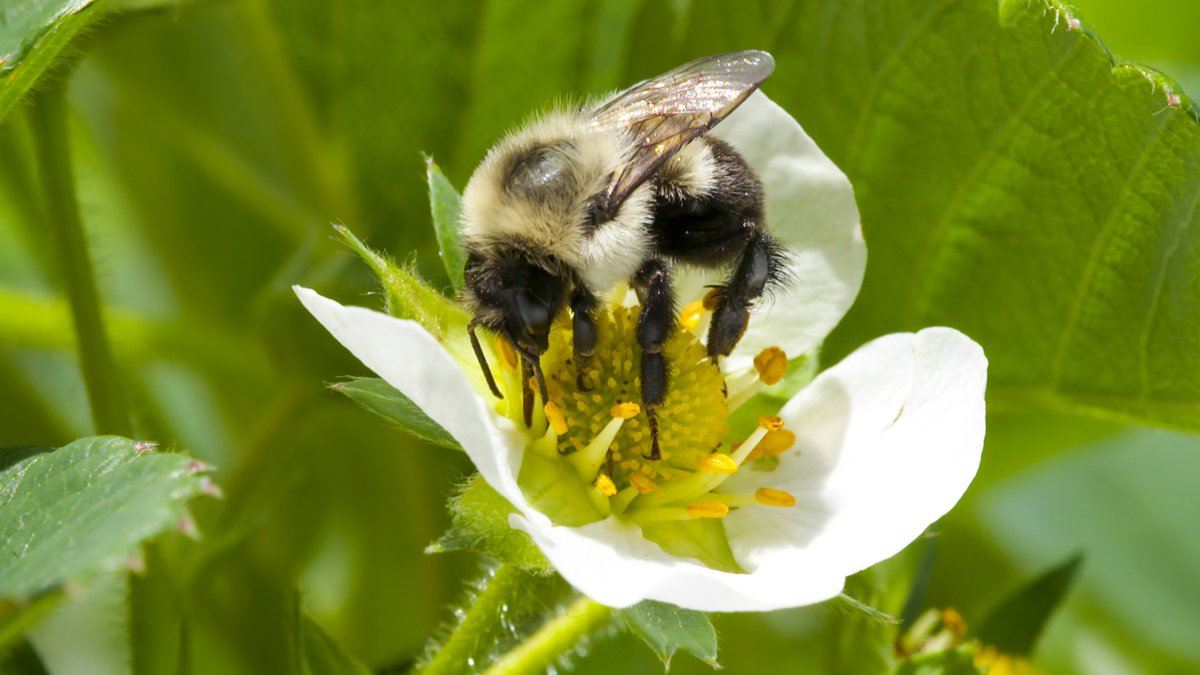
The fungus-coated bees visit the canola flowers, leaving behind spores which infect L. lineolaris as it crawls over the same plants. The bees are able to spread the spores throughout the crop more efficiently than humans could, without harm to the bees. popsci.com/unearthing-nat…
In some cases, control of pests/pathogens can be the result of direct interaction between the biocontrol agent and the pathogen - such as a fungus directly attacking and killing a bug that was damaging a crop. However, biocontrol agents may also have indirect effects too.
This could include things like producing chemicals that indirectly damage the pathogen; inducing a defense response in the plant that makes it more resistant to any pathogen; or simply out-competing pathogens for space or resources they need. 
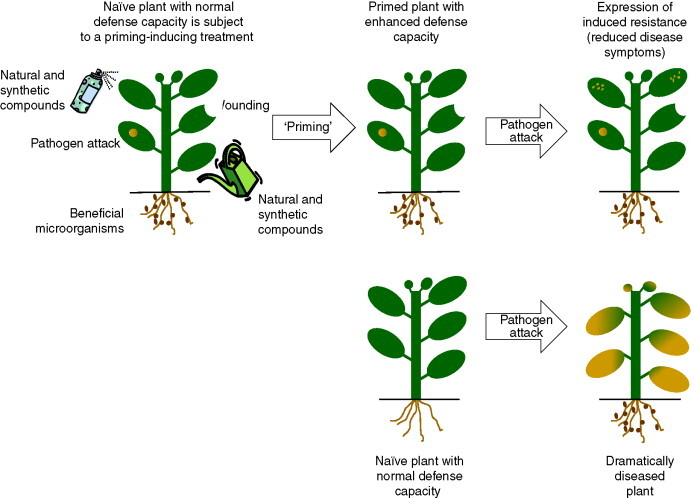
The fungus Beauveria bassiana has also demonstrated this kind of indirect effect when it interacts with plants. For example, although B. bassiana attacks certain arthropod pathogens directly, it also appears to indirectly improve resistance of tomato seedlings ...
...against the common soil fungi Rhizoctonia solani and Pythium myriotylum, which cause root rot and damping-off. While there's no evidence that B. bassiana directly attacks these other fungi, its presence results in better growth of the tomatoes and a big reduction in symptoms.
Similar results have also been found using Beauveria bassiana on cotton plants. It's got great potential for use as a biocontrol agent! 😊
researchgate.net/publication/22…
researchgate.net/publication/22…
Species of Trichoderma fungi also help protect plants against Rhizoctonia solani and similar pathogenic fungi, but Trichoderma do this both directly AND indirectly. Trichoderma species produce helical hyphae around the hyphae of R. solani, penetrating them to attack it directly. 

In addition, they produce several compounds with antimicrobial activity, and they are aggressive competitors for space and nutrients, so they are beneficial in protecting plants.
longdom.org/open-access/tr…
longdom.org/open-access/tr…
Since R. solani can affect potato, sweet potato, tomato, eggplant, lettuce, and many other crops, there's huge potential in developing species of Trichoderma as biocontrol agents. But, more research is needed to learn how to do this safely and at large scale. 🙂
Another example where Beauveria bassiana is being used as a biocontrol agent is in the People's Republic of China, in order to control Pine Moth (Dendrolimus species). Pine Moth caterpillars can devastate huge areas of a forest, but they're very susceptible to B. bassiana. 

Experiments with B. bassiana control began several decades ago, and by 1980 there were 60 factories in Hunan province alone that grew B. bassiana on peat or bran, specifically for use to control the Pine Moth caterpillars. 

Powdered spore structures of the fungus are then harvested and distributed throughout the forests via a variety of methods including sprays, explosives, and using other insects as vectors. (Yes, explosives! There were some quite enthusiastic methods of distribution test! 😂) 

(Previous image from books.google.ca/books?id=KUQAG…)
At least one million hectares of pine forests have been treated with B. bassiana, making this possibly the largest biocontrol effort in the world! sciencedirect.com/topics/agricul…
At least one million hectares of pine forests have been treated with B. bassiana, making this possibly the largest biocontrol effort in the world! sciencedirect.com/topics/agricul…
The Alfalfa Weevil, Hypera postica, is believed to have arrived in North America from Europe in the early 1900s and has since spread throughout North America. The eggs hatch in spring around the same time as alfalfa crops begin to grow, and cause significant defoliation damage. 
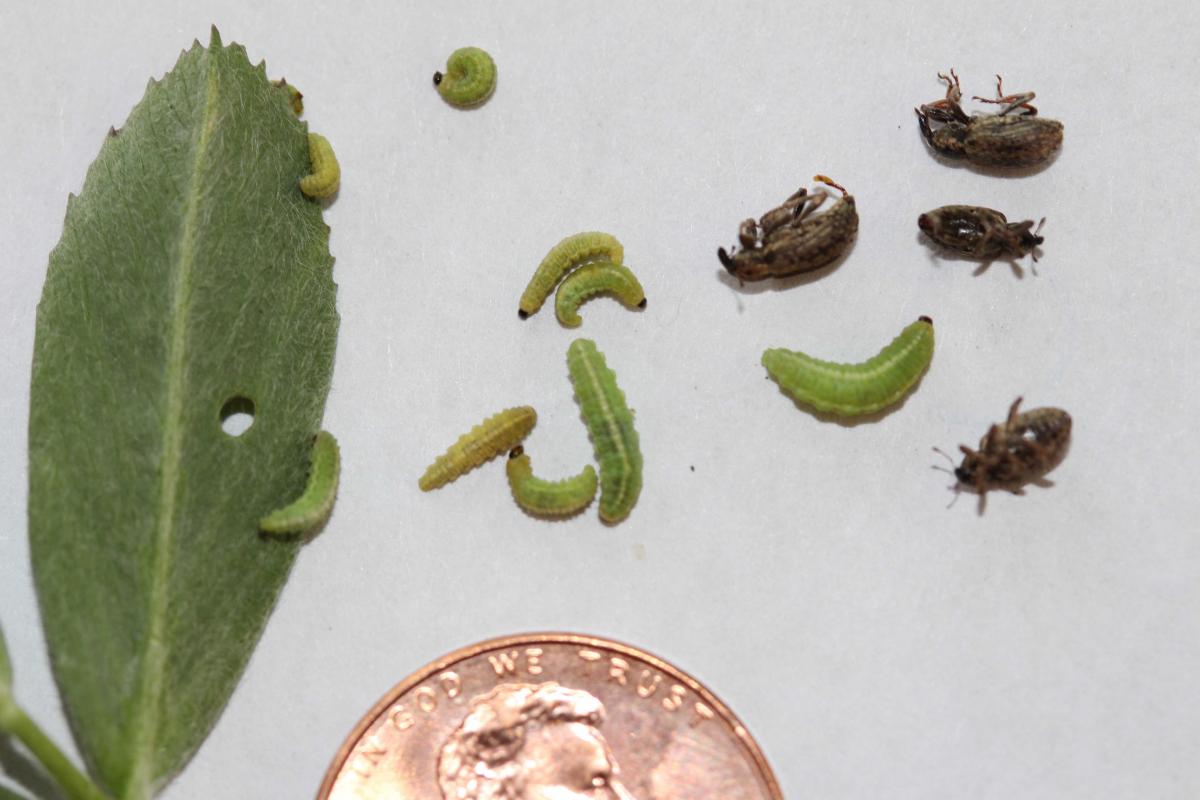
A fungus called Erynia phytonomi was discovered in Ontario in the 1970s and has also now spread within North America. This fungus overwinters in the soil, and germinates in the spring in time to infect the larvae of the alfalfa weevils.
If the weevil population becomes dense enough, it spreads rapidly through the population. (Note: social distancing works for weevils too! More space & less contact between individuals in the population means diseases can't spread effectively!) 

Because effective spread of E. phytonomi depends on weevil density as well as the humidity and other climate factors, use of this biocontrol method requires careful monitoring of the local crop conditions in order to find the most effective time to harvest for maximum yield.
This fungal biocontrol method is often combined with other methods of control, including a parasitic wasp that also attacks H. postica, and chemical controls.
faculty.ucr.edu/~legneref/biot…
faculty.ucr.edu/~legneref/biot…
Eudarluca caricis is a species of fungus in the family Phaeosphaeriaceae. It's a mycoparasite, meaning that it parasitizes other fungi. Unlike some, E. caricis doesn't specialize in just one particular host target; instead, it appears to affect a wide number of different fungi.
E. caricis has been found to parasitize rust fungi that attack leeks, corn, sorghum, and french bean crops, as well as many other less agriculturally important plants such as willow trees, blackberries, and ryegrass.
This image shows E. caricis growing in a patch of the rust-coloured spores of Phragmidium violaceum, which causes blackberry rust disease. Since rust fungi are pathogens of so many important crop plants, scientists are particularly interested in any mycoparasites of them! 

E. caricis is one of the more promising candidates. It's often found parasitizing the spore-producing structures of rust fungi in the Pucciniaceae family, reducing the number of spores the host produces, and thus the spread of disease and the amount of damage done to the crop. 

There are at least 26,000 known nematode species, approximately 4100 of which are plant parasites. A 2016 paper estimated US$100 billion in agriculture damage world wide is caused by just 100 species of nematode. Currently, a variety of chemical nematicides are used, but ... 

...these may harm other harmless or beneficial organisms in the soil, and well as potentially causing environmental damage. Most nematicides also cannot penetrate the thick protective coat of nematode eggs, meaning frequent reapplication of the chemicals as more eggs hatch. 

"But wait!" I hear you say. "I read this ENTIRE ENORMOUS RIDICULOUS fungus facts thread and I remember that some fungi are capable of attacking nematodes!"
YOU ARE CORRECT, and indeed, researchers are looking at fungi as a potential biocontrol agent.
YOU ARE CORRECT, and indeed, researchers are looking at fungi as a potential biocontrol agent.
https://twitter.com/pentapod/status/1280515178879213568?s=20
Several species of fungi have been tested for their potential as a biocontrol agent of nematodes. Purpureocillium lilacinum is one of the most promising, as it's able to infect nematode eggs as well as the hatched adults.
Also, if you're wondering why it got that name:
Also, if you're wondering why it got that name:

In addition to being a very pretty colour and also harming the nematodes, P. lilacinum also produces a number of metabolic byproducts including phytohormones that promote plant growth, and some others that appear to increase plants' resistance to disease and poor soil conditions.
Like many other fungi, P. lilacinum is also able to solubilize phosphorus in the soil into compounds that plants can utilize. Other fungal species (such as Verticillium chlamydosporium) also also show promise as potential nematode biocontrol agents (but are less pretty!) 

As always, using a biocontrol agent is less straight-forward than using a chemical. Because it's is a living organism, its performance may vary widely depending on environmental and other conditions. The ongoing challenge of using biocontrol agents is ...
... to find a way to make them as simple and effective to apply as chemicals, regardless of location.
If interested, you can find lots more information on fungi as biocontrol agents here, among many other sources around the internets: researchgate.net/publication/30….
If interested, you can find lots more information on fungi as biocontrol agents here, among many other sources around the internets: researchgate.net/publication/30….
Ascosphaera apis is a fungal disease that can affect both honey bees and bumble bees. Its origin isn't known, but the disease has been common in Europe for a long time so may have originated somewhere in Europe and spread globally with human migration patterns. 

It can affect workers, drones, even queen bees, but is most obvious in the larvae.
A. apis spores are eaten by the larvae; the fungus germinates in the larva's gut and grows hyphae into the gut wall. Initially the infection isn't visible and the larvae may continue to develop.
A. apis spores are eaten by the larvae; the fungus germinates in the larva's gut and grows hyphae into the gut wall. Initially the infection isn't visible and the larvae may continue to develop.
When larvae are ready to pupate they are sealed into honeycomb cells; at this point larvae would normally rely on the food they have stored to survive during the process of becoming an adult, but instead the fungus absorbs these nutrients and the infected larvae starve to death. 

When the cells are uncapped by worker bees, instead of living bees they find "mummies" of the dead pupae, hardened and wrapped in white fungal hyphae. As the fungus matures and grows spores it will turn from white to a dark grey. 

The dead larvae bodies are deposited by workers on the hive floor or near the hive entrance, where unfortunately the sticky spores may spread the infection; spores can remain infectious for up to 15 years. 

Chalkbrood disease tends to occur during late spring and is worse in humid conditions in the hive, and by cool weather. It's unlikely to wipe out a colony entirely, but it can seriously weaken the hive, so beekeepers should check for it and and clean out any infection promptly.
The hymenoptera order of insects includes many important pollinators essential to human crops. Its members include ants, bees, sawflies, and wasps, among others. 

Many hymenoptera ancestors are monoandrous (females pair with one male at a time), but there's evidence that polyandry has developed separately in multiple hymenoptera species. In these cases, one queen may mate with multiple different males. 

Researchers studying polyandry vs monoandry in insects such as honey bees hypothesized that for something to independently occur multiple times in different places, there is likely some kind of external evolutionary pressure that makes it advantageous.
Our model of host-pathogen relationships suggests that genetic diversity in a host population reduces chance that a pathogen strain can kill all host genotypes. In other words, the more genetically diverse the host is, the less likely it is that any one disease can kill them all.
Therefore, in the case where there is strong pressure from a pathogen on a host population, any adaptation that might increase genetic diversity in that population increases their chance of at least some of them being resistant to the disease, and surviving.
Studies of honey bees confirmed the more genetically diverse the colonies are, the lower the instance of diseases such as the fungus that causes chalkbrood. Similarly, more genetically diverse leafcutter ant colonies showed greater resistance to the fungus Metarhizium anisopliae. 

Researchers also examined naturally monoandrous bumble bee colonies, and when they increased genetic diversity in the colony by using artificial insemination techniques, they found the more genetically diverse colonies were less susceptible to pathogens. 🤔 

While there are likely multiple factors that have led many insects to become polyandrous, there does seem to be evidence supporting the possibility that the pressure from diseases like chalkbrood may be a significant factor in insect species switching from monoandry to polyandry. 

Note that besides implying diseases can cause polyandry, this ALSO implies it's someone's job somewhere to artificially inseminate bumble bees. I don't recall this coming up as an option with my high school career counselor, who suggested I consider being a trucker, iirc. 🤣
Podoserpula miranda is a mushroom originally found in 2009 in the south Pacific archepelago of New Caledonia. Podoserpula species have an unusually shaped mushroom, resembling a series of cup-shaped caps attached to a central stem. 

P. miranda is believed to be a mycorrhizal fungus associated with a species of myrtle tree, Arillastrum gummiferum. It's particularly unusual looking since it's also bright pink, which has earned it the nickname "Barbie pagoda fungus".
While it has inspired some computer generated images that add additional colour, such as this one, the variable colours shown here aren't accurate: society6.com/product/pagoda…
The genuine Barbie Pagoda Fungus is actually just bright pink, which is still pretty striking! Though probably not poisonous, it's also probably not very good tasting. No comment on whether a "Mycologist Barbie" will be forthcoming from @Mattel to match.🤣
theguardian.com/science/2011/o…
theguardian.com/science/2011/o…
Grifola frondosa is a polypore mushroom that grows around the base of oak trees iIn early fall in North America, and the clusters of mushrooms on a single tree can grow to 100 lb (45 kg). In Japanese, it's called "maitake", meaning "dancing mushroom"... 

...in English it's often called hen-of-the-woods, possibly because it's said to have a similar texture and meatiness to chicken when cooked, or possibly because the clusters of mushrooms look like a feathered hen. 

It causes wood rot at the base of trees, but can also be cultivated by growing it on sawdust or artificial logs, so this is a popular mushroom to sell commercially.
Maitake mushrooms have also been used traditionally in Japanese medicine for centuries.
Maitake mushrooms have also been used traditionally in Japanese medicine for centuries.

There are some initial research papers that indicate it may have some medicinal value such as helping to control blood sugar in diabetics, however there are no fully conclusive studies yet that have fully verified this.
I previously mentioned the common stinkhorn (Phallus impudicus).
A close relative is Phallus indusiatus, sometimes called the long net stinkhorn or veiled lady. Like the common stinkhorn, it produces its spores in a sticky, smelly substance called gleba
https://twitter.com/pentapod/status/1252581628708294656?s=20
A close relative is Phallus indusiatus, sometimes called the long net stinkhorn or veiled lady. Like the common stinkhorn, it produces its spores in a sticky, smelly substance called gleba
It's also called "bamboo mushroom" because it grows in bamboo forests. One theory is that the "veil" like structure is grown to provide an easy "ladder" for insects to climb and reach the gleba, so they can distribute the spores elsewhere in the forest.
Despite its odd appearances, this is an edible mushroom grown commercially and commonly sold in Asian markets, and often used in stir-frys and soups. There are records of its use in Chinese medicine as far back as the 7th century, and it's also mentioned in Nigerian folklore. 

Its scientific name comes from the Latin indusiatus, "wearing an undergarment". In Japanese it's called Kinugasatake. from the hat called kinugasa, which is a wide-brimmed hat with a hanging veil. In Nigeria it's called éró ḿma, from the Igbo words for "mushroom" and "beauty". 

Many mushrooms grow gills under their caps. As the mushroom matures, spores form on these gills and fall, to be carried away by the breeze. In fact, as previously described, some mushrooms even help create their own breeze to speed their spores along:
https://twitter.com/pentapod/status/1273384666288930817?s=20
The key word here is: air. Mushrooms grow in the air, so it's always available to drop spores into. Or at least, that's what mycologists thought up until 2005, when researcher Robert Coffan discovered small mushrooms growing in the Rogue River in Oregon. mailtribune.com/news/environme…
These mushrooms break down plant matter in the river bed, and have extra-long stipes (the stem of the mushroom) which helps keep them anchored in the river current, and they appear to have the same kind of spore-dropping gills as air-dwelling mushrooms. So how does it even work? 

The fast-flowing Rogue River is a notoriously oxygen-rich river, and photos of the mushrooms show many air bubbles trapped around their caps. It's possible the spores could drop into trapped air bubbles, which are then released to the surface. 



It's also possible that grazing caddisfly larvae may transport the spores elsewhere in the river. There are many questions still unanswered, but in the mean time the new mushroom has been named Psathyrella aquatica, or more simply, the "Rogue mushroom".
forestfloornarrative.com/blog/2019/1/18…
forestfloornarrative.com/blog/2019/1/18…
Armillaria mellea is a variety of honey mushroom parasitic on trees, particularly hardwoods. The mushrooms tend to appear in the fall in North America, particularly after a rain. Although the fungus damages to trees, its mushrooms are considered good eating when cooked. 

Entoloma abortivum is another species of fungus that grows in similar areas. It is also edible, although there are several other very similar looking species of Entomola that are NOT edible, so it's not advised to eat these without being very certain. 

When these fungi meet, things get interesting! The mushrooms produced when both are present look like neither one of them; instead they're strange shaped popcorn-like white masses that look a bit like misshapen puffball mushrooms. When cut, they may be pink inside like Armillaria 

Entoloma abortivum got its name because it was believed these odd popcorn-like mushrooms were "aborted" Entomola mushrooms that hadn't properly developed - hence the name. BUT! Microscopic examination shows both Entomola and Armillaria hyphae are present within the structures. 

The first theory was that Armillaria - already known to be a damaging parasite of trees - was also parasitizing the Entoloma fungus and causing its mushrooms to develop into this misshapen form. 

However! More recent studies strongly suggest the reverse is true, and that in fact it's Entomola that is parasitizing Armillaria mellea and causing the latter's mushrooms to develop in this misshapen form. It's still unclear what evolutionary advantage this gives E. abortivum.
They don't have spore-producing gills like normal mushrooms. But they are considered very tasty to humans; another name for this mushroom is "shrimp of the woods" or "ground prune", and their unusual shape makes them very easy to identify!
A: Entomola; B: combined; C: Armillaria
A: Entomola; B: combined; C: Armillaria

Let's talk about smut! The word "smut" likely comes to us from the German "smutzen" meaning to stain; one of its meanings is still a particle of soot or substance that blackens things. merriam-webster.com/dictionary/smut
Therefore, when a group of fungi were found that cause diseases in flowering grasses where the grains get replaced by what looks like sooty black powder (actually the fungus' spores), this group of fungi were called Smut Fungi.
Barley, healthy and with smut infection:
Barley, healthy and with smut infection:

Depending on the species, smut fungus may either infect new plants as they sprout or as they grow, or may actually infect the seeds of the plant and spread along with the plant seed, growing together with the plant right from the start.
Sorghum (healthy/smut):
Sorghum (healthy/smut):

"Loose smut" produces dusty spores which are distributed by wind to infect other plants, while "covered smut" species produce their spores within enclosed structures, usually galls formed from the infection of the plant's grain. 

Covered smut spores do not blow away like loose smut spores but ripen inside their protective gall. These enclosed structures are then broken up as the grain is harvested, which releases the spores and spreads the fungus all throughout the harvested grain. 😢 

Smut fungi can, obviously, have a severely bad impact on the yield of the infected plant. Smuts primarily affect grasses, which include agriculturally important crops such as corn (maize), wheat, sugarcane, and sorghum. Farmers monitor crops closely for signs of smut!
More smut info! 😮 Although smut fungi can cause devastating damage to crops and have been a well known agricultural problem for hundreds of years, corn smut - Ustilago maydis - is an interesting case. 
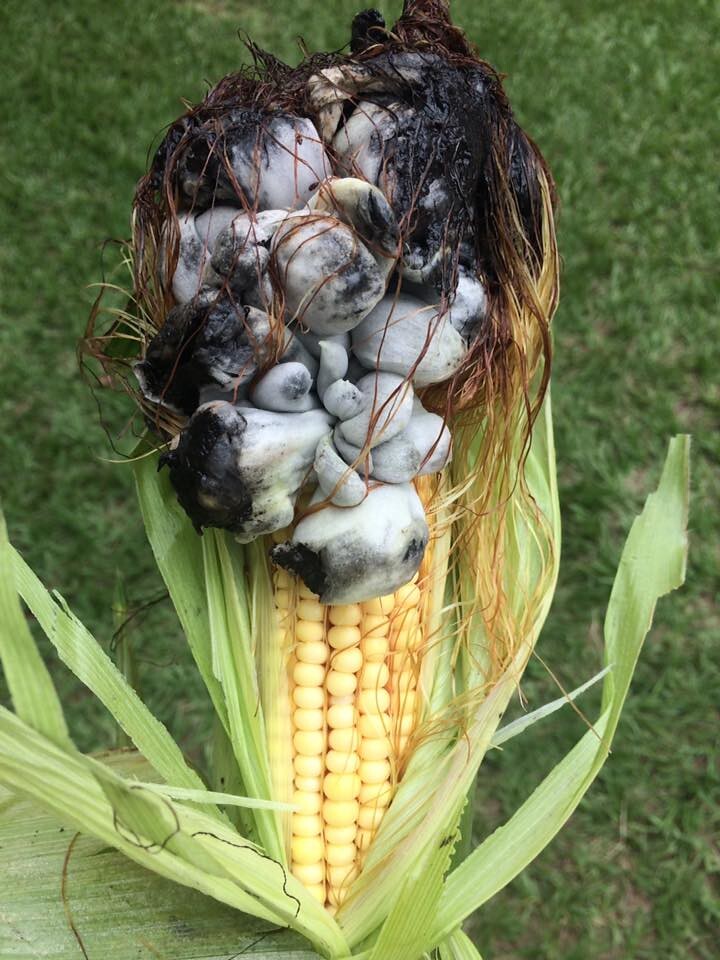
It's been a longtime problem for corn farmers, and in the US is sometimes called "Devil's Corn". The smut causes infects corn kernels, causing them to swell up into grey-purple galls that will slowly ripen and eventually become filled with the dusty black spores of the fungus. 

BUT! In Mexico, this corn smut is known as huitlacoche, and is actually valued as a delicacy. If picked while the galls are still young, before they dry out to form the powdery spores, they are delicious and are sold and treated like a type of mushroom. 😋
npr.org/sections/thesa…
npr.org/sections/thesa…
It's an old (and questionable) saying that the Inuit language has an unusually high number of words for snow. Canadians in general have a lot of words to describe types of snow and ice, not all of them polite enough to tweet. ❄️🌨️☃️
According to one survey, apparently it's the Scots who have the biggest snow-related vocabulary at over 400! k-international.com/blog/which-lan…
Despite having grown up in Canada, one type of ice I'd never heard of before is "hair ice". Google it for some images - it's beautiful, and literally looks like hair made of ice. Here's an amazing timelapse video of it forming:
It's found on dead wood and only at temperatures just below 0C. While it's been observed for about 100 years, it's quite rare and it wasn't until recently known what makes it form. The answer appears to be: fungi! Or, specifically, one particular fungus called Exidiopsis effusa. 

A team of German scientists studied samples from wood that grew hair ice and discovered that the one thing they had in common was this particular fungus. The metabolic byproducts of the fungus growing on the wood appear to stabilize the water ... 

...so it can form the hair-thin ice structures. Without the fungus present, the ice hair doesn't form! sci-news.com/biology/scienc…
So, while E. effusa may not "put hair on your chest", as the saying goes, it does appear to put hair on your wood, so to speak, given the right conditions. 🤣 And also gives us yet another word for a type of winter ice crystal. ❄️ 

Delicatula integrella is a tiny translucent mushroom found on decaying hardwood in damp mossy woodlands around Europe in late summer through autumn. 



It appears to be saprophytic - eating decaying wood - and it's unknown if it's poisonous because it's so small that there wouldn't be enough to eat anyway. Mostly, it's just pretty to look at! 😊 



Hericium erinaceus is also known as the bearded tooth mushroom, lion’s mane mushroom, tree hedgehog fungus, satyr’s beard, pom-pom mushroom, monkey head mushroom, and more. The scientific name 'erinaceus' comes from the Latin word for hedgehog, describing its clusters of spines. 

It's not surprising that it has so many names; it's very unusual looking, forming a cushion-like mound covered with white or yellow spines that look like fur. It grows to about the size of a soccer ball, and is usually found eating fallen deadwood in N. America, Asia or Europe. 

It's edible and traditionally used in Chinese medicine to treat memory loss and other neurological disorders. However, between the decline of its natural habitat (old woodlands) and the demand for consumption, this mushroom has now been declared an endangered species in England. 

This is Lactarius indigo, aka "Indigo Milk Cap". The genus name "Lactarius" means "milk mushroom," because the mushrooms in this genus produce a milky latex when cut or bruised. The latex is normally stored in special large hyphae called lactiferous hyphae. 

The unusual thing about this species is that the colour of the latex it produces is indeed indigo; the mushroom itself is a light blue but the "milk" released is a dark indigo that turns greenish as it ages. The mushroom is edible, although slightly bitter until cooked. 

Rhodotus palmatus is an unusual looking mushroom commonly called the Wrinkled Peach, Rosy Veincap, or Netted Rhodotus. It's fairly uncommon but has been found in North America, Asia, Europe and Africa, typically growing on rotted hardwood. 

The most distinctive feature of this mushroom is the wrinkled and grooved cap which may be salmon pink to red in colour. It's often photographed exuding pink or red droplets of liquid from the stem through the process known as guttation. 

It's probably not poisonous, but is also described as bitter and inedible. In Europe it's now so rare that it's on a number of critically endangered species lists. woodlands.co.uk/blog/flora-and…
In 1893 a mushroom was found in Texas. It grows on the stumps or dead roots of cedar elms in Texas and looks like a dark coloured cigar when young; when older it splits open into a starlike shape, reportedly with a hissing sound. It got named "The Devil's Cigar" or "Texas Star". 

It was only found in a few counties of Texas and for many years thought to be unique to that state. However, in 1937, the same mushroom was found in Kyush, Japan, where it was called kirinomitake, and grows on dead oaks. 

In 1997 there was a proposal to name it the State Fungus of Texas, however since State Fungus isn't a designation that officially exists, this doesn't seem to have been successful.
It remains a mystery why the fungus has only been found in Texas and Japan and nowhere else.
It remains a mystery why the fungus has only been found in Texas and Japan and nowhere else.

Like many fungi, when it's not actually forming mushrooms it exists as mycelium under the soil and is very hard to identify, so it's not known whether it might exist in many other places but not grow mushrooms, or if it really isn't there at all. 🤷♀️ 

Fistulina hepatica is called the Beefsteak Mushroom, or sometimes the Ox Tongue Fungus, because it resembles nothing so much as a slab of raw meat. It's a red coloured polypore that grows on trees, particularly oak. 

It can be eaten raw or cooked and apparently has a texture similar to real meat, but a slightly sour taste like sorrel or rhubarb. foragerchef.com/the-beefsteak-…
Omphalotus nidiformis is a mushroom that grows on dead or dying wood and is common in the south of Australia. It looks a bit like an oyster mushroom, except at night ... when the gills of O. nidiformis start to glow in the dark. 



The mushroom is poisonous, causing cramps and vomiting, though not lethal. The toxicity is caused by a family of chemicals called illudins; these have some antitumor and antibiotic properties and are currently undergoing clinical trials to test their use for cancer therapy. 

If you're visiting the south of Australia, photographing some of these is definitely a bucket list item! 😄 milkwood.net/2015/02/16/glo…
Clathrus ruber is one of the stinkhorn family, and like the others in this thread, it has a sticky smelly substance containing its spores that attracts flies to carry them away. Unlike some of the others, C. ruber forms a hollow latticed structure, with the sticky spores inside. 

It's saprophytic, and fairly common in mediterranean and temperate climates in Europe, North America, and Asia. However, the mature mushroom only lasts for about 24 hours and all signs of it will have completely vanished within 2-3 days. 

Because of its shape, it's called the Latticed Stinkhorn or Red Cage fungus, and in the former Yugoslavia it's known as "Witch's Heart", which is about the best, most evocative name ever for something so creepy looking. 😱 
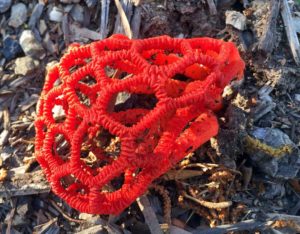
Botrytis cinerea is a pathogenic fungus that attacks many plants, but is best known for the diseases it causes on grapes. It's a necrotrophic fungus, meaning it consumes the dead tissue of plants it has killed, and it forms a grey mold, producing grey spores across the surface. 

The scientific name Botrytis cinerea comes from the Latin meaning "grapes like ashes". On grape vines, when weather conditions are wet, the grey mold spreads uncontrolled across the grape bunches, and the fruit are usually lost entirely, causing severe loss for wineries. 
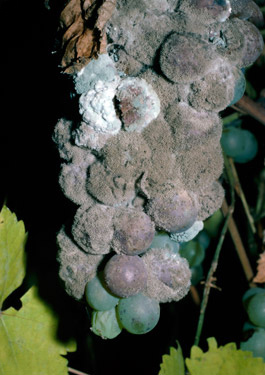
However! If the weather becomes dry, it is less destructive. The fungus will take water from the grapes, causing them to have a higher overall concentration of sugars. In this case the grapes can still be made into wine, and will create a sweeter, more concentrated dessert wine. 

When this happens it's called "noble rot" and the wines it creates are called botrytized wines. (This is similar to the effect of ice wines, where the freezing of the grapes removes water from the pressing, resulting in a higher sugar content and more concentrated flavour.) 

Intentionally making botrytized wines is more complicated than making regular wine for many reasons, not least the need to make sure the conditions are wet enough for the fungus to spread but then dry enough so the grapes are dehydrated, not destroyed.
B. cinerea also naturally produces antifungal compounds that kill off yeasts and other fungi that may be competitors for the plants it eats. Since yeast is required for the fermentation process of making wine, this can also add complexity to the winemaking process.
Because of all the additional factors that go into making botrytized wines, they tend to be more rare and more expensive than regular wine, and not something that every vineyard has the necessary conditions, or skill, to make. But those who do, can profit from these valued wines! 

Gliocladium roseum is a fungus that is often found growing on plants including soybean, red clover, strawberry, and raspberry. Although it may be found growing on many parts of these plants, it doesn't appear to cause any harm to them. 

Since it doesn't appear very damaging to plants, if at all, this fungus might not get much attention, except that researchers noticed it DOES compete with other fungi. Among others, Botrytis cinerea, which causes harmful mold on many important crop plants. 

In the presence of G. roseum, the damage caused by B. cinerea infection is greatly reduced. Exactly how the fungi interact is still being understood and appears to vary based on which part of the plant is infected, and possibly the plant species.
On strawberry leaves, G. roseum "strongly suppressed germination and germ tube growth" of B. cinerea but rarely parasitized it directly. However, on stems, there was only "modest suppression of germ tube growth" but in high humidity, G. rosium directly parasitized B. cinerea.
The smaller hyphae of G. roseum "contacted, grew on,or coiled around, and in many instances, invaded conidia and hyphae of B. cinerea". This mycoparasitism has also been observed on raspberries and other plants. 



Overall this makes G. roseum a very promising biocontrol agent to help reduce the damage B. cinerea can cause to crop plants. This paper has a lot more detail about some of the research being done to determine the most effective way to use it: apsjournals.apsnet.org/doi/pdf/10.109… 



Schizophyllum commune is a wood decay fungus causing "white rot", and is so common that it's found on every continent except Antarctica, where there's nothing for it to eat. It has no stem, but grow directly on the wood like a bracket fungus; however, unlike them it has gills. 

Its scientific name means "split gill" due to their unusual appearance, and in English its common name is usually "split gill mushroom" or "gillies". The gills of these mushrooms are actually folds in the under surface and tend to occur in pairs, hence the name. 

The upper surface is white to grey and covered with fine hairs; both the fuzzy upper surface and the split gill structure underneath help this mushroom survive dry periods extremely well (the gills curve inward as they dehydrate to reduce water loss... 

...and the hairs allow extra efficient absorption of new rainfall when it does happen).
forestfloornarrative.com/blog/2017/8/11…
forestfloornarrative.com/blog/2017/8/11…
Schizophyllum commune mushrooms are not poisonous but also not very popular to eat because they're generally small and dry. This fungus is common and successful all across the world, likely due to its extreme versatility in where it can grow. It primarily breaks down wood... 

...and it has been observed on at least 150 genera of woody plants, but it can also live on softwood and grass silage, and has even been observed attacking immunocompromised humans and animals in some rare cases. 

S. commune is able to grow on so many different things because it can produce a wide range of enzymes and other chemicals to break down different types of food. This means it's got a very high potential for use in creating biotechnological products/treatments!
It may be useful both for the enzymes it produces and/or for the substances it can break down. There are MANY patents on S. commune currently being worked on, and a lot more detail about some potential uses in this paper: ncbi.nlm.nih.gov/pmc/articles/P… 

Guess what ... it's Friday and I have the day off work so we're going to talk about SEX! Fungus sex and genders, that is. And if you thought human dating was complicated, hang on to your caps (mushroom caps or otherwise) because you're in for a ride.
In the 1950s-1970s researchers from Harvard University collected samples of Schizophyllum commune from all around the world, to try and confirm if they were really the same species. They were able to confirm this by getting individuals from every area to mate w/ one another. 

They confirmed that - and were also able to identify that the species had mating types. Like genders in humans, but a bit more complicated!
Many animals we're familiar with have two genders (from a genetic mating perspective), often called male and female...
Many animals we're familiar with have two genders (from a genetic mating perspective), often called male and female...
They're physiologically different in certain ways (e.g. one produces the sperm, the other produces an egg and gets pregnant). Sperm + sperm doesn't produce offspring, nor does egg + egg, you need two different types for that.
(Yes this is simplifying things, and there are exceptions, and sometimes egg + egg DOES produce offspring ... but broadly speaking there are two types of reproductive bits that are most common to find in many animals.)
Anyway the point is ... fungi don't do it this way. AT ALL. It's a bit complex to explain in detail but very simply speaking, any gender of a fungus can either donate genetic material (like a sperm) or getting "pregnant" (producing a mushroom).
In fungi, rather than using the term "gender" scientists use "mating type", but like animals, two of the same mating type (gender) can't produce offspring. In fungi, the mating types are just assigned letters instead of names like "male" or "female", e.g. mating type A1 or A2.
Just like male dog + male dog will not get anybody pregnant with puppies, two A1 type fungi cannot produce offspring with each other, and nor can two A2 type fungi. But an A1 and an A2 fungus can.
In many animals, mating type (gender) tend to correspond to certain obvious physical characteristics (like in peacocks, the males grow a huge beautiful tail but females don't). Not so obvious in fungi; A1 and A2 types of fungus look basically the same...
...the difference is mainly in a whole bunch of genes associated with sexual structures and spores determining who can do what and how.
Many fungi are still "bipolar" - which means having just two mating types, A1 and A2.
Many fungi are still "bipolar" - which means having just two mating types, A1 and A2.
BUT! Some other fungi got even MORE complicated and added a second chromosome location that also affects mating type. Scientists (who are really not good at coming up with exciting names for things) called these additional mating types B1 and B2, which is a "tetrapolar" system.
So fungi that use the additional B mating type have both an A and a B type ... for example, A1B1, or A1B2, or A2B2, etc. And when these fungi mate, BOTH the A and the B type have to be different. So A1B1 can mate with A2B2, but NOT with A1B2, for example.
Confused yet? But wait, there's more! In the examples above, there are just two different types of A and of B. But, some fungi have more. So for example, A1, A2, and A3 types, and maybe even more. So an A1 fungus could mate with BOTH A2 and A3 types, giving it extra options.
For example, an A1B1 fungus could mate with A2B2, A2B3, A3B2, and A3B3 types, giving it LOTS more potential mates. And some species don't stop at just 3 types either, although many do.
Now, getting back to where we started, with Schizophyllum commune...
Now, getting back to where we started, with Schizophyllum commune...

Turns out S. commune has over 300 A mating types and 90 B mating types, which means, if you do some math, that it has 28,000 distinct combinations, or genders. And you thought HUMAN dating was complicated!
Of course, even human genders aren't really as simple as male vs female; the more we learn about the topic the more we realize there are more complexities in our own genetics and reproduction than we expected. Fungi, however, are truly next level.
This blog has the clearest explanation of fungal sex that I was able to find, if you're interested in learning more: blog.mycology.cornell.edu/2010/06/02/a-f…
...and that's a very brief overview of fungus gender identity. We now return you to your regular Friday! 😄
...and that's a very brief overview of fungus gender identity. We now return you to your regular Friday! 😄
• • •
Missing some Tweet in this thread? You can try to
force a refresh









